Australia Post Travel Platinum Mastercard®
A prepaid travel card with 11 currencies to load from, giving you confidence when spending overseas.

- About Australia Post Travel Platinum Mastercard
- Fees & limits
- Get started
- Support & FAQs

The ideal prepaid card for overseas travel

Travel smarter with our Australia Post Travel Platinum Mastercard, a reloadable, multi-currency prepaid card that’s accepted wherever Mastercard is, worldwide 1 . Easily swipe or tap in-store, use online and withdraw money from ATMs 2 .
Load up to 11 currencies. Easily switch between USD, EUR, GBP, NZD, THB, CAD, HKD, JPY, SGD, AED and AUD on your travels.
Lock in your exchange rates. Know exactly how much you have to spend online or in-store with locked-in exchange rates 3 .
Travel safely. With no link to your bank account and Mastercard’s Zero Liability 4 protection against fraud and other unauthorised transactions.
Total control. Manage and load your prepaid travel money card on the go via ‘ My Account ’ or the Australia Post Travel Platinum Mastercard app.
24/7 global assistance. Card lost or stolen? Call for a replacement anytime. You may also be eligible for emergency funds assistance 5 .
Managing your travel money just got easier
Our Australia Post Travel Platinum Mastercard app makes managing your travel money faster and easier. Check your balance, reload in-app, track your spending and switch between currencies.
Mastercard Prepaid Management Services Australia Pty Ltd (ABN 47 145 452 044, AFSL 386837) arranges for the issue of the Australia Post Travel Platinum Mastercard in conjunction with the issuer, EML Payment Solutions Limited ('EML') ABN 30 131 436 532 , AFSL 404131. Australian Postal Corporation (ABN 28 864 970 579, AR No. 338646), the card distributor, acts as an Authorised Representative of Australia Post Services Pty Ltd (ABN 67 002 599 340, AFSL 457551). You should consider the Australia Post Travel Platinum Mastercard Product Disclosure Statement (PDF 248kB) and Financial Services Guide (PDF 72kB) before deciding to acquire the product. Any advice does not take into account your personal needs, financial circumstances or objectives and you should consider if it is appropriate for you. Mastercard® is a registered trademark, and the circles design is a trademark of Mastercard International Incorporated.
View the Target Market Determination (PDF 88kB) for this product.
If you click on links to Australia Post Travel Platinum Mastercard you will be leaving the Australia Post site and be directed to a third-party site to place your order and complete your purchase. Please see the terms and conditions of the third-party site for further details.
1 The ATMs and POS terminals are not owned or operated by Australia Post, the Issuer or Mastercard Prepaid Management Services and Australia Post, the Issuer and Mastercard Prepaid Management Services are not responsible for ensuring that they will accept the Card
2 Some ATM operators may charge their own fees and set their own limits.
3 Lock in your exchange rates means the exchange rate is locked in for the initial load only. The exchange rates for subsequent reloads will be set at the prevailing exchange rate at the time of the transaction.
4 Further information relating to Zero Liability card protection can be found at the Mastercard website .
5 T&Cs apply. Customers must contact Customer Service to report lost or stolen cards. Emergency cash can be arranged up to the balance of your Australia Post Everyday Mastercard, subject to availability of funds at the approved agent location.
For a full list of Fees & Limits, refer to the Product Disclosure Statement (PDF 258kB) .
Mastercard Prepaid Management Services Australia Pty Ltd (ABN 47 145 452 044, AFSL 386837) arranges for the issue of the Australia Post Travel Platinum Mastercard in conjunction with the issuer, EML Payment Solutions Limited ('EML') ABN 30 131 436 532 , AFSL 404131. Australian Postal Corporation (ABN 28 864 970 579, AR No. 338646), the card distributor, acts as an Authorised Representative of Australia Post Services Pty Ltd (ABN 67 002 599 340, AFSL 457551). You should consider the Australia Post Travel Platinum Mastercard Product Disclosure Statement (PDF 248kB) and Financial Services Guide (PDF 72kB) before deciding to acquire the product. Any advice does not take into account your personal needs, financial circumstances or objectives and you should consider if it is appropriate for you. Mastercard® is a registered trademark, and the circles design is a trademark of Mastercard International Incorporated.
Travel smarter with our prepaid travel money card
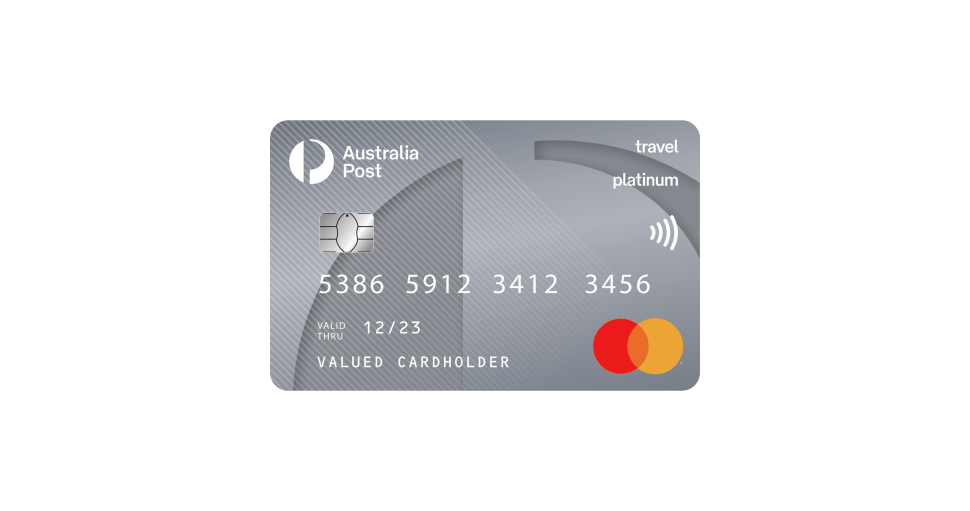
Buy your Australia Post Travel Platinum Mastercard® at a participating Post Office or online .

Register / Activate
Register your prepaid travel money card online.
If you purchased your card online, you’ll need to activate it.

Load your card anytime online through ' My Account ', the Australia Post Travel Platinum Mastercard® app or at any participating Post Office .
Use your card wherever Mastercard is accepted 1 .
1 The ATMs and POS terminals are not owned or operated by Australia Post, the Issuer or Mastercard Prepaid Management Services and Australia Post, the Issuer and Mastercard Prepaid Management Services are not responsible for ensuring that they will accept the Card.
More information
- Product Disclosure Statement (PDF 339kB)
- Financial Services Guide (PDF 72kB)
- Target Market Determination (PDF 88kB)
Can't find an answer below? Call Card Services on 1800 549 718 within Australia or +44 207 649 9404 internationally for help 24/7.
If you have a transaction on your card that doesn't seem right, download the disputed transaction form .
Frequently asked questions
Australia Post acknowledges the Traditional Custodians of the land on which we operate, live and gather as a team. We recognise their continuing connection to land, water and community. We pay respect to Elders past, present and emerging.

Best Travel Cards in Australia in 2023 For Overseas Travel

Byron Mühlberg
Monito's Managing Editor, Byron has spent several years writing extensively about financial- and migration-related topics.
Jarrod Suda

A writer and editor at Monito, Jarrod is passionate about helping people apply today’s powerful finance technologies to their lives. He brings his background in international affairs and his experiences living in Japan to provide readers with comprehensive information that also acknowledges the local context.
Links on this page, including products and brands featured on ‘Sponsored’ content, may earn us an affiliate commission. This does not affect the opinions and recommendations of our editors.
From the multitude of bank fees and ATM charges to hidden currency conversion fees, there's no question that travelling abroad can be a costly endeavour — and that's saying nothing of the cost of the holiday itself!
As you prepare for your trip abroad, the golden rule is to pay using the local currency of your destination. This means accessing local cash with ATMs and using a prepaid debit card that can access the local currency. If it's not possible for you to spend in the local currency when travelling abroad, then spending in your home currency while using a card that doesn't charge any hidden exchange rate markups from your bank (e.g. only paying Visa or Mastercard exchange rates to convert currency) is still a good bet for most Australians when travelling abroad.
In this guide, we explore cards like Revolut and Wise that can lower ATM fees and hold multiple currencies. Spend on your holiday like a local and enjoy peace of mind after each tap and swipe.
In general, we consider Revolut to be the best travel card in Australia for all-around use, as its versatile account and card can be used to spend like a local pretty much anywhere in the world. With Revolut, you'll get a debit card, multi-currency account balance in 32 currencies, and a savvy mobile experience.
Best Travel Cards in Australia
- 01. Revolut — Best all-round travel card in Australia scroll down
- 02. Wise — Best for number of currencies and foreign account details scroll down
- 03. Considering going through your bank scroll down
- 04. Compare the best travel cards in Australia scroll down
- 05. Tips to save money when travelling overseas scroll down
- 06. FAQ about the best travel cards in Australia scroll down
Revolut: Best All-Round Travel Card in Australia
Revolut is impressive for its vast currency options and additional services, such as international money transfers and a money management interface. Revolut is one of the most well-known mobile finance platforms in the world because it offers services not only in Australia but also across Europe, the Americas, and Asia.
Like Wise, Revolut converts your currency to the local currency of your travel destination at the Revolut rate, which is close to the real mid-market exchange rate. It does set a cap on free allowances, however, since fair use limits and weekend surcharges may apply (Revolut's Standard Plan only allows free exchanges for transfers worth $1,000 per month). Once you make your exchange from AUD to the local currency of your destination, your card will be treated like a local card (avoiding foreign transaction fees or dynamic currency conversions ).
ATM withdrawals are also free for the first $350. These allowances can be waived by upgrading memberships. Bear in mind that third-party ATM fees may apply, even though Revolut doesn't charge any fees of its own for withdrawals up to $350 per month.

- Trust & Credibility 8.9
- Service & Quality 7.9
- Fees & Exchange Rates 8.3
- Customer Satisfaction 9.4
- Account name: Standard
- Account type: Personal account (not a bank)
- Total cost: $0 per month .
- Noteworthy features: AUD account details, multi-currency balances.
- More info: See our full Revolut review .
Wise: Best for Number of Currencies and Foreign Bank Details
Wise has one of the best multi-currency cards available on the market. Load up to 54 currencies onto this card at the real exchange rate, giving you access to truly global travel.
Unlike banks, credit unions, airport kiosks, and foreign ATMs, Wise is transparent about never charging a hidden exchange rate margin when you convert your home currency into up to 54 currencies. The live rate you see on Google or XE.com is the one you get with Wise. An industry-low commission fee per transaction will range from 0.35% to 2.85%, depending on the currency.

- Trust & Credibility 9.3
- Service & Quality 8.9
- Fees & Exchange Rates 7.6
- Customer Satisfaction 9.6
- Account name: Multi-Currency Account
- Account type: Electronic Money Account (held by local banks).
- Total cost: $0 per month.
- Noteworthy features: International money transfers, multiple account details, multi-currency balances.
- More info: See our full Wise Account review .
Consider Your Australian Bank Travel Money Card
Another option for spending abroad is to use your bank. Some Australian banks offer prepaid debit cards onto which you can load AUD and convert it into many countries around the world. These include the Commbank Travel Money Card. However, as of 2023, some banks such as ANZ, NAB, and Westpac have cancelled their travel card offerings, meaning you'll need to use a third-party prepaid card like Revolut .
You could also travel abroad with your ordinary debit or credit card, however, this will generally be the most expensive choice , as in most cases you'll pay an exchange rate fee plus a currency conversion fee. If you decide to use a standard bank card, make sure that you choose a card produce that explicitly waives foreign transasction fees .
What’s the Best Travel Card in Australia?
To discover the best travel money card in Australia to suit your overseas travel needs, compare the two fintech offerings we discussed above, Wise and Revolut, with a typical bank travel card like CBA's Travel Money Card:
Last updated: 6/1/2023 ¹ Bank account details in USD, EUR, GBP, AUD, NZD, SGD, CAD, RON, HUN, and TRY
Money-Saving Tips When Traveling Abroad From Australia
When you convert Aussie dollars into a foreign currency, foreign exchange service providers will charge you two kinds of fees:
- Exchange rate margin: Providers apply an exchange rate that is poorer than the true "mid-market" exchange rate . They keep the difference, called an exchange rate margin .
- Conversion fee: This fee is usually a percentage of the amount converted or a fixed amount, which is charged for the service provided.
With these facts in mind, let's see what practices are useful to avoid ATM fees, foreign transaction fees, and other charges you may encounter while on your travels.
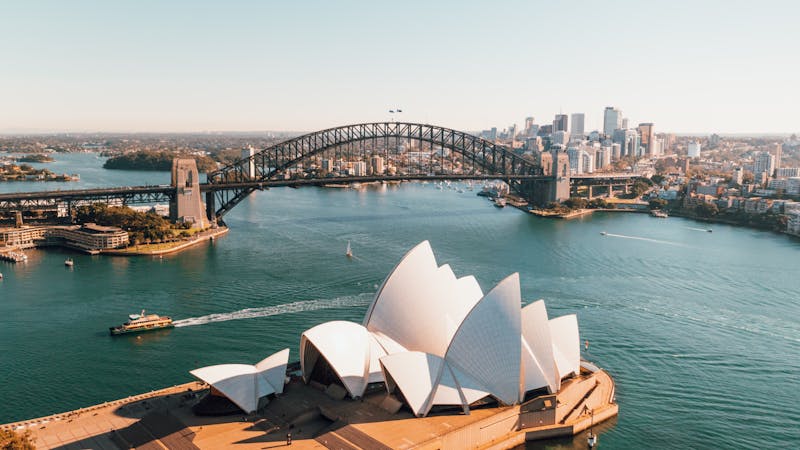
Tip 1: Avoid Bureaux de Change
Have you ever wondered how bureaux de change and currency exchange desks are able to secure prime real estate in touristic locations like the Champs-Élysées in Paris or Covent Carden in London while claiming to take no commission? It’s easy: they make (plenty of) money through hidden fees on the exchange rates they’re giving you.
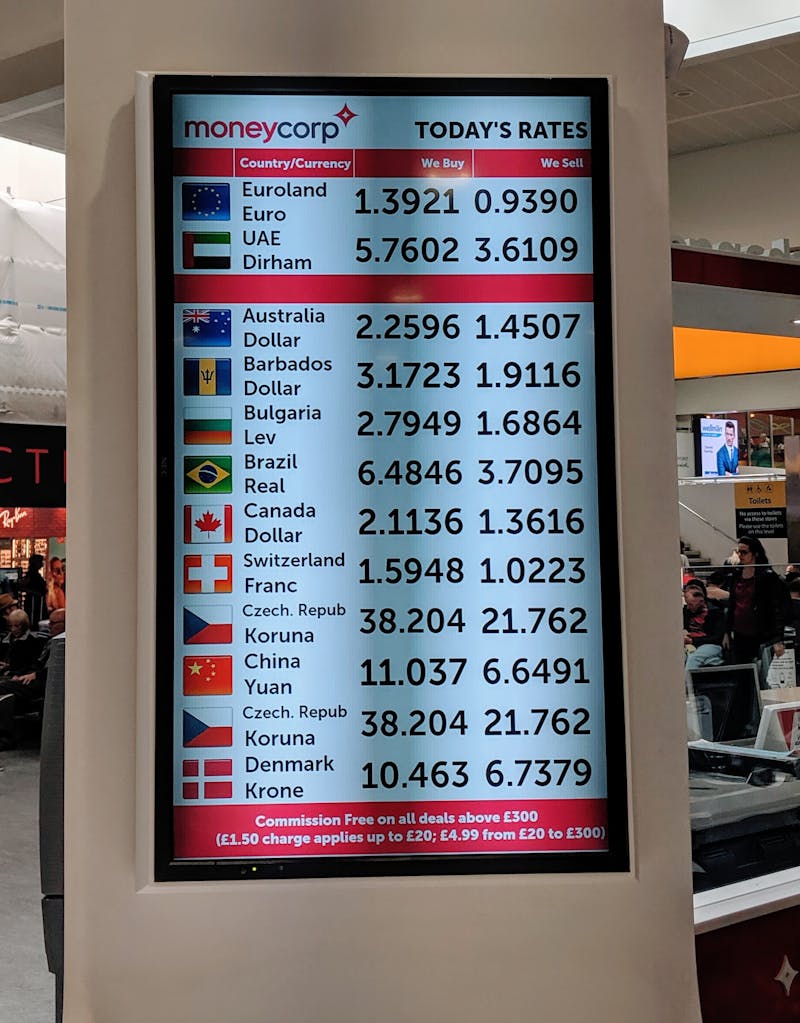
Our study shows that Bureaux de Change in Paris charges a margin ranging from 2.15% at CEN Change Dollar Boulevard de Strasbourg to 16.6% (!!) at Travelex Champs-Élysées when exchanging 500 US dollars into Euros for example.
If you really want cash and can’t wait to withdraw it with a card at an ATM at your destination, ordering currencies online before your trip is usually cheaper than exchanging currencies at a bureau de change, but it’s still a very expensive way to get foreign currency which we, therefore, would not recommend.
Tip 2: Always Pay In the Local Currency
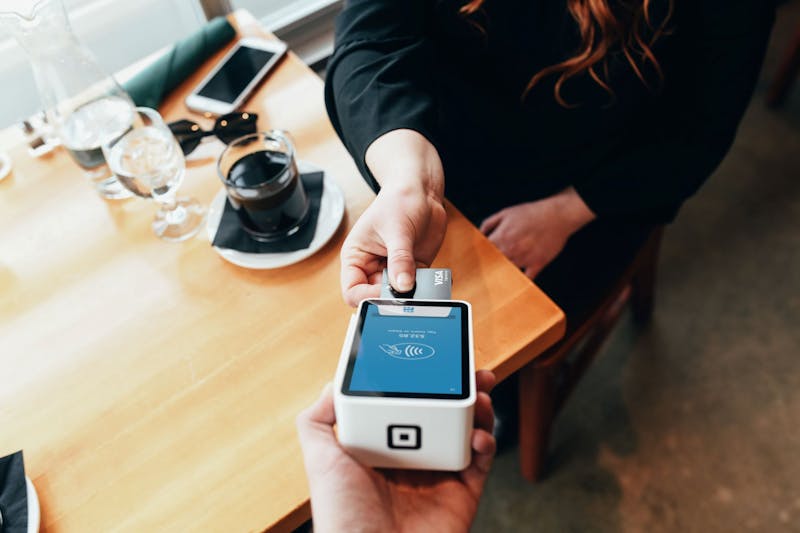
Don’t fall for the dynamic currency conversion trap! When using your card abroad to pay at a terminal or withdraw cash at an ATM, you’ve probably been asked whether you’d prefer to pay in your home currency (i.e. Australian dollars) instead of the local currency of the foreign country. This little trick is called dynamic currency conversion , and the right answer to this sneaky question will help you save big on currency exchange fees.
As a general rule, you always want to pay in the local currency (Euros in Europe, GBP in the UK, DKK in Denmark, THB in Thailand, etc.) when using your card abroad, instead of accepting the currency exchange and paying in Australian dollars.
This seems like a trick question - why not opt to pay in AUD? On the plus side, you would know exactly what amount you would be paying in Aussie dollars instead of accepting the unknown exchange rate determined by your card issuer a few days later.
What is a Dynamic Currency Conversion?
When choosing to pay in AUD instead of the local one, you will carry out what’s called a “ dynamic currency conversion ”. This is just a complicated way of saying that you’re exchanging between the foreign currency and AUD at the exact time you use your card to pay or withdraw cash in a foreign currency, and not a few days later.
For this privilege, the local payment terminal or ATM will apply an exchange rate that is often significantly worse than even a traditional bank’s exchange rate (we’ve seen margins of up to 8%!), and of course, much worse than the exchange rate you would get by using an innovative multi-currency card.
Knowing what amount you will pay in Australian dollars is not worth the additional steep cost of the dynamic currency conversion, hence why we recommend always choosing to pay in the local currency.
Tip 3: Don't Use a Traditional Card To Pay
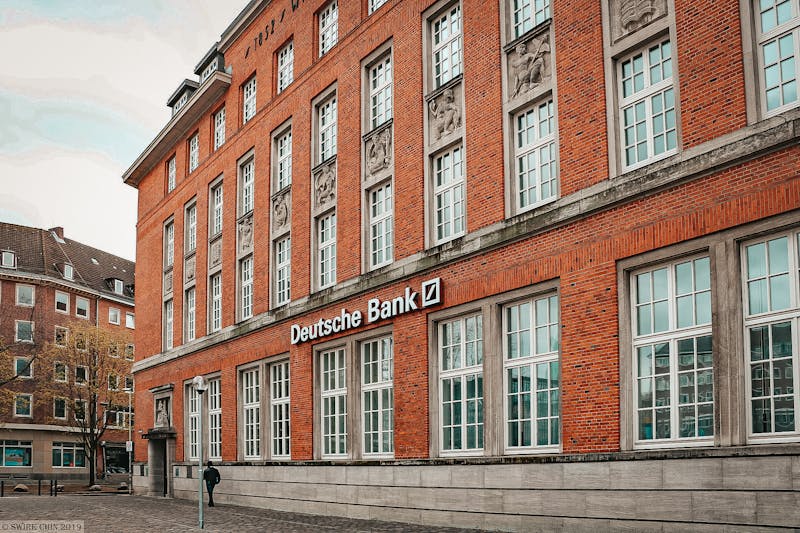
Only use traditional Australian bank cards for overseas travel if they waive international card transaction fees . As mentioned before, providers make money on foreign currency conversions by charging poor exchange rates — and pocketing the difference between that and the true mid-market rate. They also make money by charging commission fees, which can either come as flat fees or as a percentage of the transaction.
FAQ About the Best Travel Cards in Australia
Having reviewed and compared several of the industry's leading neobanks, experts at Monito have found Revolut to offer the best prepaid multi-currency card in 2023 in Australia.
In general, yes! You can get a much better deal with new innovative travel cards than traditional banks' debit/credit cards. However, not all cards are made equal, so make sure to compare the fees to withdraw cash abroad, the exchange rates and monthly fees to make sure you're getting the best deal possible.
- Sign up for a multi-currency account;
- Link your bank to the account and add Aussie dollars;
- Convert amount to the local currency of holiday destination ( Wise and Revolut convert at or near the actual mid-market rate);
- Tap and swipe like a local when you pay at vendors.
Yes, the Wise Multi-Currency Card is uniquely worthwhile because it actually converts AUD into foreign currency at the real mid-market exchange rate . Wise charges a transparent and industry-low commission fee for the service instead. More traditional currency cards like the Travelex Money Card are good alternatives, but they will apply an exchange rate that is weaker than the mid-market rate.
The Wise Multi-Currency Card is the best money card for euros because unlike banks, credit unions, airport kiosks, and foreign ATMs, Wise is transparent about never charging a hidden exchange rate margin when you convert your local currency into euros with them.
The live rate you see on Google or XE.com is the one you get with Wise . An industry-low commission fee will range from 0.35% to 2.85%. USD to EUR transfers generally incur a 1.6% fee.
Learn more about how to buy Euros in the United States before your trip.
There are usually three types of travel cards, prepaid travel cards, debit travel cards and credit travel cards. Each have pros and cons, here's a short summary:
- Prepaid travel cards: You usually need to load cards with your home currency via a direct entry or credit/debit card top-up. You're then able to manage the balance from an attached mobile app and can use it to pay in foreign currencies or withdraw cash at an ATM abroad tapping into your home currency prepaid balance. With prepaid travel cards, as the name indicates, you can't spend more than what you've loaded before hand. Some prepaid card providers will provide ways to "auto top-up" when your balance reaches a certain level that you can customize. On Revolut for example, you can decide to top-up £100/£200/£500 from your debit card each time your balance reaches below £50.
- Debit travel cards: Some innovative digital banks, like N26 or Monzo, offer travel debit cards that have the same advantages than a Prepaid Travel Cards, except that they're debit card directly tapping into your current account balance. Like a Prepaid travel card, you can't spend more than the balance you have in your current account with N26 or Monzo, but you can activate an overdraft (between €1,000 or €10,000 for N26 or £1,000 for Monzo) if you need it, for a fee though.
Note that even if they're Prepaid or Debit cards, you can use them for Internet payments like a normal credit card.
- Credit travel cards: You can find credit cards made for international payments offering good exchange rates and low fees to withdraw money abroad, but you'll need to pay interests in your international payment if you don't pay in FULL at the end of every month and interest on your ATM withdrawals each day until you pay them back.
Other Monito Guides and Reviews on the Best Travel Cards in Australia and Top Multi Currency Cards
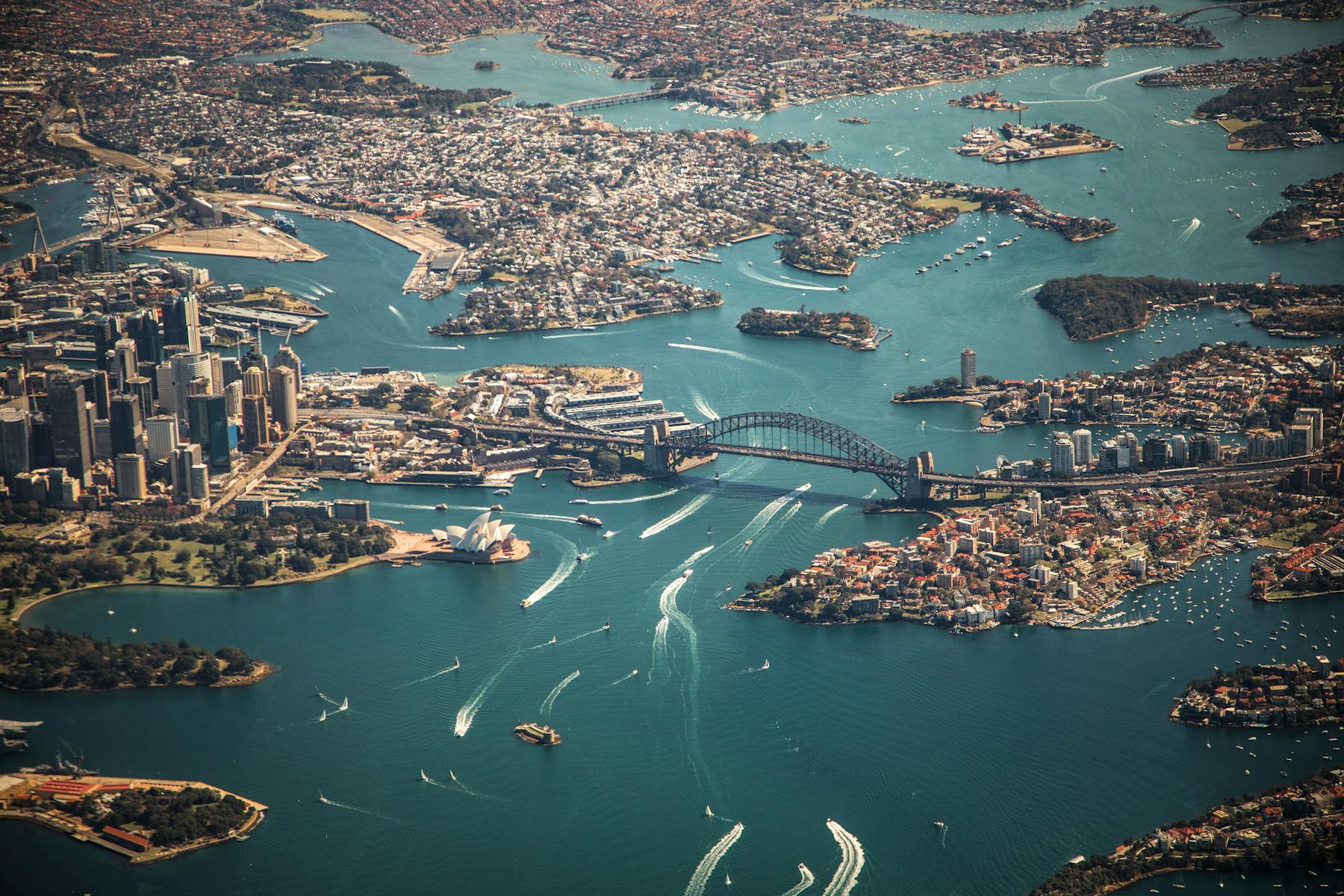
Why Trust Monito?
You’re probably all too familiar with the often outrageous cost of sending money abroad. After facing this frustration themselves back in 2013, co-founders François, Laurent, and Pascal launched a real-time comparison engine to compare the best money transfer services across the globe. Today, Monito’s award-winning comparisons, reviews, and guides are trusted by around 8 million people each year and our recommendations are backed by millions of pricing data points and dozens of expert tests — all allowing you to make the savviest decisions with confidence.
Monito is trusted by 15+ million users across the globe.
Monito's experts spend hours researching and testing services so that you don't have to.
Our recommendations are always unbiased and independent.
10 Of The Best Travel Credit Cards in Australia in 2024
- Compare travel credit cards based on foreign exchange fees, travel perks and more.
- Plus get expert tips on using your credit card overseas from a veteran frequent flyer.

Featured offer: American Express® Platinum Edge Credit Card
$0 annual card fee (usually $195) in first year when you apply online and are approved. T&Cs apply, new members only. Plus, get $200 each year to spend on eligible domestic and international flights, hotels or car hire with American Express Travel.
Top travel credit cards in Australia
Bankwest Breeze Zero Platinum Mastercard
Bankwest breeze platinum mastercard, coles rewards mastercard, hsbc low rate credit card, american express platinum, bendigo bank ready credit card, latitude 28° global platinum mastercard, westpac lite card, ing orange one rewards platinum, american express platinum edge.

- International transaction fee: 0%
- Interest rate on purchases: 14.99% p.a.
- Up to 55 interest-free days
- Annual card fee: $0
- Complimentary international travel insurance: Included
What to know about the card
What’s good? By any standard, the Bankwest Breeze Zero Platinum Mastercard is a low-cost credit card that will save travellers money, with a 0% foreign transaction fee, a relatively low ongoing interest rate on purchases and no annual credit card fee . Yet it still comes with complimentary credit card travel insurance , a travel perk rarely found on low-cost cards.
What’s not so good? Despite being positioned as a ‘Platinum’ card, aside from the complimentary travel insurance, the card offers little in the way of perks and rewards.

- Interest rate on purchases: 19.99% p.a.
What’s good? Another low cost card (assuming you repay the card balance in full each statement period) with no foreign transaction fees. There are no hoops to jump through to avoid the annual fee, which is rare for a card offering complimentary travel insurance.
What’s not so good? There’s not much to dislike here if you want a low-fee card. That said, the interest rate is on the high side. For travellers covering the cost of a holiday across multiple statement periods, this could be an issue.

- International transaction fee: 0% on purchases
- Interest rate on purchases: 27.49% p.a.
- Complimentary international travel insurance: Not included
What’s good? No international transaction fees and no annual fee, plus a couple of other eye-catching travel perks: Access to global roaming data from eligible telco networks in 150 countries; and a flight delay pass which offers access to airport lounges if your flight is delayed.
What’s not so good? Even by credit card standards, Latitude’s 28° Global Platinum Mastercard has a remarkebly high interest rate, meaning carrying a balance could be extremely expensive of you have a revolving balance.

- Interest rate on purchases: 0% p.a. for 12 months, then 12.99% p.a.
- Annual card fee: $69
What’s good? Offers the same travel-friendly advantages as Bankwest’s Breeze Zero Platinum Mastercard but with a slightly lower ongoing interest rate that’s waived for the first 12 months. This could be an option for new cardholders looking to pay off an expensive trip over time with what is effectively an interest-free credit card for the first year.
What’s not so good? There’s an annual fee and also relatively few card perks (not surprising given the annual fee is fairly modest).
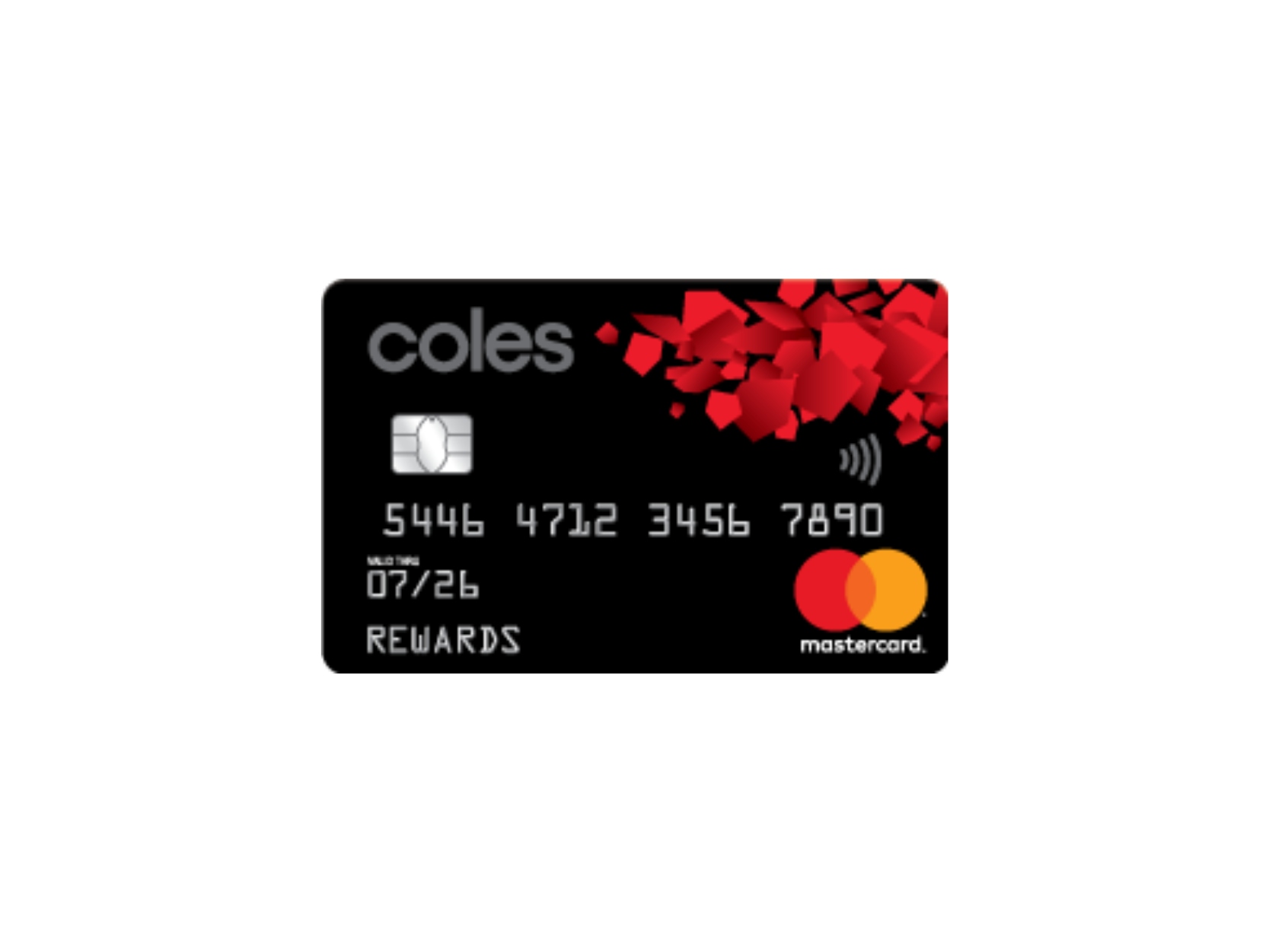
- Annual card fee: $99
What’s good? This is one of the 0% international purchase fee credit cards that also offers rewards points (Flybuys), with a sign-up bonus of 50,000 points if you apply by 30 June 2024 and spend $3,000 on eligible purchases within 3 months of approval.
What’s not so good? There’s an annual fee – it’s not massive for a rewards credit card but there are other cards out there arguably offering more travel perks (e.g complimentary travel insurance) with no annual fee.

- Interest rate on purchases: 12.99% p.a.
- Complimentary international travel insurance: Not included, but comes with domestic travel cover.
What’s good? The HSBC Low Rate Credit Card comes with no international transaction fees and a low interest rate on purchases of 12.99% p.a. It also offers domestic travel insurance, and an offer of 0% on balance transfers for 20 months.
What’s not so good? The annual fee takes some of the gloss off what is otherwise a low-cost, low-frills card. The cash advance rate is 25.99% which is very high if you need to withdraw cash using your card.

- Interest rate on purchases: 9.90% p.a.
- Up to 45 interest-free days
- Annual card fee: $108 ($9 monthly)
What’s good? The 0% fee on international transactions is the standout feature, along with the low interest rate on purchases (one of the lowest available of any card with no foreign transaction fees).
What’s not so good? For a card with a ‘Lite’ offering, the annual fee (charged monthly) is not particularly ‘Lite’. There’s also no cash advance option. Although expensive, a cash advance facility can be handy when travelling if you need cash from an ATM in an emergency.

- International transaction fee: 0% (subject to eligibility criteria)
- Interest rate on purchases: 16.99% p.a.
- Annual card fee: $149
What’s good? ING’s Orange One Rewards Platinum ticks two major boxes for travellers: No foreign transaction fees (although there’s a big asterisk on this) and complimentary travel insurance is included. There’s also a credit card cashback offer with the potential to earn cardholders up to $360 per year, comfortably enough to offset the card’s annual fee.
What’s not so good? The main caveat with this card is that the 0% international transaction fee is conditional on the cardholder also having one of ING’s Orange Everyday accounts, depositing at least $1,000 into it each month and making at least five card purchases each month. It’s not an insurmountable hurdle but it’s not ideal unless you already have ING as your main bank.

- International transaction fee: 3%
- Interest rate on purchases: 23.99% p.a.
- Annual card fee: $195 (waived in the first year)
What’s good? Amex’s Platinum Edge Credit Card also offers plenty of travel perks but with a much lower annual fee than the Platinum Card. Cardholders get complimentary travel insurance, a $200 travel credit (completely offsetting the card’s annual fee), plus 2 rewards points per $1 spent on purchases in a foreign currency (overseas and online).
What’s not so good? The 3% currency conversion fee is high compared to other cards, as is the interest rate on purchases. This is another card that could be expensive if not used strategically.

- Interest rate on purchases: n/a
- Up to 44 cash flow days
- Annual card fee: $1,450
- Plus new card members get 150,000 bonus points when they apply online by 25 June 2024, are approved and spend $5k on eligible purchases within the first 3 months of approval. T&Cs apply.
What’s good? The American Express Platinum card is certainly not a cheap option, but it arguably offers more frequent flyer travel perks than any other card in Australia: complimentary travel insurance, an annual $450 travel credit, a $400 dining credit, lounge access, up to 2.25 rewards point per $1 spent on eligible purchases, bonus sign up points subject to conditions), plus a lot more. It’s also a charge card , meaning there are no interest costs but the balance must be cleared in full each month.
What’s not so good? The $1,450 annual fee is a lot, so you really need to be taking advantage of the rewards to offset that cost. The 3% currency conversion fee on American Express credit cards is also high, meaning it’s perhaps a card best used for booking travel, and left in your wallet while spending overseas.
How to compare travel credit cards: 6 key questions to ask
What’s the foreign transaction fee.
It will be somewhere between 0% and 3% of the transaction value depending on the card. If you spend a lot overseas, it’s worth minimising this fee as much as possible.
Will the card be accepted where I’m travelling?
Mastercard and Visa are accepted almost everywhere. Amex is a bit more limited but still widely accepted in the countries Australians travel to in numbers.
What’s the interest rate?
Ideally you’ll be clearing the balance of the card within the interest-free period, but if not, a lower interest rate will help you minimise your travel costs.
What’s the annual card fee?
There are some travel credit cards with no annual fee that offer benefits for travellers, but most do come with a fee. If there is a fee, look carefully at what you’re getting in return.
Is travel insurance included?
A credit card that comes with travel insurance included could save you hundreds of dollars if it means you don’t need to purchase a separate travel insurance policy. Pay attention to what is covered by the policy and if it’s suitable for you.
Are there any other travel benefits thrown in?
Some travel credit cards offer lounge access (usually a limited number of passes per year), plus travel discounts credits you can put towards flights, accommodation and dining. These can be a nice ‘cherry on top’ if the rest of the card fits the bill.
Expert tips for using your credit card while travelling
Insider tips from Money.com.au’s credit cards expert (and frequent flyer), Brad Kelly.
Cover as many of your costs as you can before you travel
As soon as you leave Australia (or buy from an overseas retailer) you become a much more profitable customer for your bank because of the fees they charge.
Avoid foreign exchange fees by prepaying for as many expenses as you can (e.g. your accommodation) assuming you can do so in AUD.
Get clear on fees
If you’re going to be spending overseas regularly, it’s worth seriously considering a credit card with 0% foreign transaction fees . This could save you up to 3.65% on every transaction. This fee is often overlooked when people apply for a credit card .
Also be clear on what you’ll be charged for using an ATM. Chances are it will be a lot.
Make sure you ‘trigger’ your card’s travel insurance
Even if your credit card comes with travel insurance, there’s a good chance it won’t cover your trip automatically. You usually need to trigger the cover, in many cases by booking the travel/accommodation using the card itself. If you pay in full with card points (e.g. with Qantas credit card points ), that mightn’t be enough to trigger the insurance – you usually need to make an actual card purchase.
Don’t withdraw cash overseas using your credit card

Using a credit card to withdraw cash at an overseas ATM is going to be very expensive. You’ll be stung with a fee from the local ATM operator (unless it happens to be a Westpac card and the ATM is part of the Global ATM alliance), a foreign transaction fee, plus a cash advance fee. You won’t get any interest-free days, meaning you’ll immediately be paying a high rate of interest on the funds you withdrew. Basically unless it’s an emergency, don’t go near an ATM with your credit card.
Brad Kelly , Money.com.au's credit card expert
Don’t accept the “Do you want to pay in Australian Dollars” option
A lot of people get caught out by this one. When you’re making a card payment overseas, a lot of the time you’ll get the option to pay in the local currency or have the amount converted to Australian dollars.
Paying the AUD amount shown would seem like the sensible choice here, but trust me, it’s almost always a rip off. That option involves what’s called dynamic currency conversion which means the conversion rate is determined by the merchant and it’s usually a much worse rate than what your credit card provider will give you if you pay in the local currency.
Bring the physical card with you
In Australia we’re very used to paying through a phone or watch using the likes of Apple Pay and Google Pay. But that kind of payment is not as widely accepted overseas. You’ll need to use the physical card and, for a dose of nostalgia, you may even need to insert it into a card chip reader and enter a PIN.
You will also likely need to have the physical card if you’re using your card for pre-authorisation when checking into a hotel or renting a car.
Have at least one backup payment option
When it comes to travel in particular, one card does not fit all. You might like the idea of using a single card for all your spending, but there are situations when a debit card will be better. Having a card from a different financial institution can also be a life-saver if your primary bank has an outage while you’re away.
You've got to be a bit strategic about how you’ll spend money overseas. So plan ahead. The truth is, if you don’t, the potential for getting walloped with fees or being massively inconvenienced is far greater than it is when you’re using your card in Australia.

Sean Callery
Reviewed by.

Credit Cards Expert
As featured in.
- Argentina
- Australia
- Brasil
- Canada
- Deutschland
- España
- France
- India
- Italia
- Magyarország
- Malaysia
- New Zealand
- Polska
- Portugal
- România
- Singapore
- United Kingdom
- United States
- 繁體中文 (香港)
Best Travel Cards for Australians Heading Overseas in 2024
We compare the best travel money cards including prepaid cards, debit cards and credit cards. Whether you want ease of access to money at any cost or no-frills or fees cash, find the best money solution when you travel overseas.
Wise - our pick for travel card
- No annual fee, hidden transaction fees, no exchange rate markups
- No minimum balance requirements
- Allows you to make payments and withdrawals wherever you are in the world in over 40 currencies
- Local bank account details in Australia (AUD), the UK (GBP), the USA (USD), Europe (EUR), Canada (CAD) and New Zealand (NZD)
- Available in the US, UK, Europe, Australia, Singapore, Japan and New Zealand
Find out more about the Wise card .
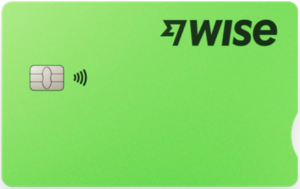
With this card:
- It's very easy to set up and order
- You can receive foreign currency into a multi-currency account linked to the card
- Pay with your Wise card in most places overseas where debit cards are accepted
- Get the mid-market rate for currency conversion
Go to Wise or read our review .
It's not all good news though
- There is a 2% ATM withdrawal fee when you withdraw over $350 during a month
- It takes 7-14 days for delivery
How do I pick the best travel card for me?
Fed up with ATM charges when you travel overseas? Or running out of money when you need it the most? You probably brought the wrong card with you.
It can be tricky to choose the best travel card to use when you travel overseas. The best one for you will really depend on what you need from the card you're using.
You will generally use travel cards to make purchases online, in-stores and to withdraw money at ATMs. All travel cards have these basic capabilities. This means what you should really compare between travel cards are the following:
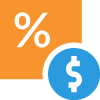
Exchange Rates and Fees
Compare exchange rates and fees

Conditions and limits
Spending conditions and max/min limits

Make sure your money is secure
Best Travel Cards for Australians Travelling Overseas
Wise is our pick for travel debit card.
- You can transfer money to a bank account overseas
- Currency conversion using the mid-market exchange rate
Click here to see the full list of cards and how Wise compares
Read the full review
- No annual fee, hidden transaction fees, exchange rate markups
- Local bank account details in Australia (AUD), the UK (GBP), the USA (USD), Europe (EUR) and New Zealand (NZD)
- It takes 7-14 business days to receive the card
- Can't always access local technical support depending on where you are
- Free cash withdrawals limited to under $350 every 30 days
- Only currently available in the US, UK, Europe, Australia and New Zealand
Revolut - multi-currency travel card
- No purchase fee, load fee, reload fee, exchange rate margin or minimum balance requirements
- Unlike other Travel Cards, its free and easy to use the balance of your currency or convert it back to AUD
- Mid-market exchange rate, they add a mark-up for currency conversion during weekends
- For the free Standard account, there is a 2% ATM withdrawal fee when you withdraw over $350 during a month
- The premium account costs $10.99 a month, which can really add up if you are not using it often
Click here to see the full list of cards and how Revolut compares
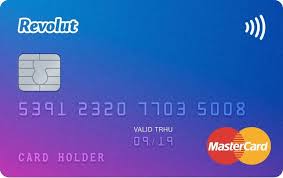
- Very easy to use app
- Free to set up
- No hidden fees or exchange rate mark-ups (except on weekends)
- You can use it to transfer money to a bank account overseas
- Additional fees for using the card on a weekend
- 2% ATM fee once you withdraw more than $350 in any 30 day period
- 3-4 business days before you receive your card
- Ongoing subscription fee for Premium and Metal cards
Citibank Saver Plus - bank travel card
The Citibank Plus Everyday Account - bank debit card. With this card you can:
- withdraw money for free at over 3000 ATMs Australia-wide and overseas
- take advantage of no foreign transaction fees, monthly fees, or minimum opening balance
- transfer money to friends and family anywhere in the world for free
We think this is the ideal debit card whether you're staying local in Oz or travelling to destinations in Asia or Europe.
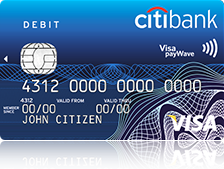
- No international ATM or transaction fees
- Fee-free international money transfers to any account worldwide
- SMS notifications through Citi Alert
- Cash deposits available within 24-48 hours
- Can't have two cards active at the same time
- $5 account closure
28 Degrees Platinum Mastercard - travel credit card
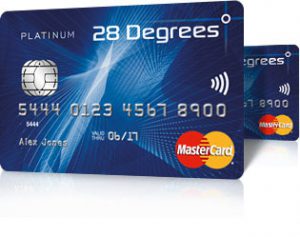
28 Degrees Platinum Mastercard - travel credit card. With this card:
- There are no annual fees
- No overseas purchase fee or currency conversion fee
- You get 55 days interest free on purchases
- Access to free 24/7 concierge service
- Emergency card replacement worldwide
The 28 Degrees Platinum Mastercard has additional benefits including shoppers and repayments benefits cover. For more information read our review .
- Can have 9 additional cardholders
- No overseas purchase fee, or currency conversion fee
- No foreign transaction fee
- Free Replacement Card
- High interest rates after the initial 55 days
- Minimum credit limit is $6000
- No introductory offers or rewards
Learn more about the 28 Degrees Platinum Mastercard
Travelex money card - prepaid travel card.
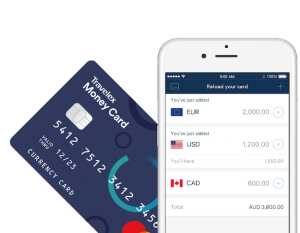
Travelex Money Card - prepaid travel card. With this card:
- There are no ATM fees so you can withdraw cash at no extra cost
- You can access Travelex's online rates
- You can lock in your initial loading cross currency rate
- Ideal for the organised traveller.
- Can load up to 10 currencies including AUD, USD, EUR, GBP, NZD, CAD, THB, SGB, HKD and JPY.
- Smartphone App & Free Wifi Cross
- $0 overseas ATM fees (Australia excluded)
- 24/7 Global Support
- Limited Currencies
- 5.95% currency conversion rate
- $100 minimum initial load
- 2.95% Australian ATM withdrawal fee
Learn more about the Travelex Money Card
What are the other travel card options.
Check our travel card comparison table for a comprehensive list of fees and features for different travel debit and credit cards available for Australians travelling overseas.
*ATM operators will often charge their own fees.
** Up to 5 ATM fees and unlimited currency conversion costs may be rebated if you deposit $1,000 and make 5 purchases per month.
***Account fee waived if you meet eligibility criteria, including depositing $2,000 per month
What are the different types of travel card in Australia?
There are 3 popular travel cards you can take with you on your trip:
Prepaid Travel Card
Travel Debit Cards
Travel Credit Card
1. Prepaid Travel Card
For prepaid travel cards, you're able to load the card with a set amount of money in the currencies you need. Ideally you do this before your trip, but often you can reload them as well.
Most prepaid travel cards allow for multiple currencies to be loaded onto the card. So it's important to know what currency you'll be using on your travels. Airlines also offer prepaid cards so the money you spend can earn you reward points.
With prepaid travel cards you need to be careful, as they can have numerous fees and charges which can make it more expensive than other options. But if you're organised and travelling to multiple cities a prepaid travel card is a good option. Read more of how to find the best travel card with no foreign transaction fees .
If you need more flexibility or you don't want to pay the multiple fees associated with prepaid travel cards, the HSBC and Citibank global accounts are better options.
- Exchange rate margins when you load your card
- Exchange rate margins when you close the card
- Flat or percentage-based fees to load the card
- ATM withdrawal fees
- Exchange rate conversion fee when you use the card
- Reloading fees
- Closing fees
Prepaid travel cards are best if:
- You want to lock in a rate
- You want to stick to a budget
- You lose it/it's stolen
Prepaid travel cards are not great if:
- You want the absolute best rates
- You need to hire a car, make payments on a cruise ship, or pay for a hotel
2. Travel Debit Card
An international card or your bank card offers the convenience of a credit card, but work differently. They draw money directly from your bank's everyday transaction account when you make a purchase. It's designed for everyday money transactions and means that you're not accumulating debt.
A debit card could make you stick to your travel budget, because you can't overdraw money from your account. And for daily purchases, we think a debit card can help you stick to your travel budget, because you can't overdraw money from your account.
We recommend bringing both a debit card and credit card for safety, flexibility and convenience on your trip.
- Currency conversion fee for overseas debit transactions
- Flat fee or percentage-based ATM withdrawal fees
- Foreign ATM owner fees
- Flat fee or percentage fee for debit card purchases via EFTPOS
Debit cards are best for:
- When you have time and you're happy to open a bank account to get one
- Fee-free cash withdrawals from ATMs
Debit cards are not great if:
- You switched from a better account to get one
- Or if you want to switch, but pick a costly travel debit card instead
3. Travel Credit Card
Credit cards have obviously been around for a long time. But now there are specialised travel credit cards. Generally, these cards give you longer to pay back what you've spent but the interest rates after this time can be quite high.
The main advantage with credit cards are the reward points you get in return for your customer loyalty when you spend. But it only works if you pay off the balance in full each month.
Credit cards are great to use for car hire, restaurants and accommodation - larger expenses that are easier for you to pay back over time. Some services only take credit cards to hold purchases so they can definitely be handy while you're travelling.
- Annual and reward scheme fees
- Cash advance fees
- Interest charges
Travel credit cards are best for:
- Getting the best spending rates
- If you have decent credit score and are legible for the credit card
- Frequent flyer points to help you get discounted or free flights
- Low or zero international transaction fees
- Complimentary travel and/or medical insurance offered with a lot of cards
Travel credit cards are not great if:
- Your credit score is poor
- You won't repay in full every month
- Can't afford high minimum credit and annual fees
- Want additional card holders (usually an extra cost)
- Your monthly salary minimum isn't high enough
- For some travel credit cards you have to be a permanent Australian resident
Best travel money card tips
Before you decide which travel money card will best suit your needs, it’s worth comparing a few, bearing in mind these handy travel money card tips:
- Exchange rate - check what rate is used to convert your dollars to the currency needed for spending in your destination. A card which uses the mid-market rate or as close as possible to it is usually the best value
- Coverage - make sure your card covers the currency you’ll need in your destination, as fees may apply if it doesn’t. Picking a card which covers a large number of currencies can also mean you’re able to use your travel money card on future trips.
- Safety - check the card’s safety features. Most cards are linked to an app which allows you to view transactions, check your balance and freeze or unfreeze your card if you need to
- Fees - read through all the possible fees associated with your card before you sign up. Costs may include a foreign transaction fee when spending an unsupported currency, ATM fees, a cash out charge or inactivity fees if you don’t use your card often for example
- Rewards - some travel money cards also offer some nice extras, like ways to earn rewards or discounts, or free wifi when you travel. Travel credit cards in particular have lots of rewards on offer, although you may have to pay an annual fee to get them
Travel card fees
The fees you pay for your travel money card will vary depending on the type of card you select, and the specific provider.
Travel prepaid cards fees can include:
- Fees when you get your card in the first place
- Load or top up fees
- An exchange rate margin when topping up foreign currencies
- Foreign transaction fees if you spend a currency you don’t have in your account
- ATM charges at home and abroad
- Cash out, close or inactivity charges
Read more about prepaid cards here
Travel debit card can include:
- Card delivery fee
- International ATM fees
- Currency conversion charges
Read more about travel debit cards here
International credit card fees can include:
- Annual fees to hold the card
- Cash advance fees if you use an ATM
- Foreign transaction fees
- Interest if you don’t repay your bill in full
- Penalties if you don’t pay your bill on time
Read more about credit cards here
Conclusion - What is the best card to use while travelling?
There’s no single best travel money card - which works best for you will depend on your personal preferences and where you’re heading.
Using a multi-currency debit card which supports a large range of currencies can keep your costs low and allow you to skip foreign transaction fees . Plus you’ll be able to use your card for online shopping in foreign currencies, or for your next trip abroad, with no ongoing fees to worry about.
Prepaid travel money cards are safe and easy to use , and you can often pick one up instantly if you’re in a hurry. You’ll be able to add travel money before you leave or top up as you travel, although it’s worth converting to the currency you need in advance, and looking for a card with mid-market exchange rates to avoid extra costs.
Generally using a credit card will come with the highest overall fees - but you’ll be able to spread out the costs of your travel over a few months if you need to, and you may also be able to earn rewards or cash back as you spend. Use this guide to compare different card types and options, and pick the perfect one for your needs.
Frequently Asked Questions - Best travel cards to use overseas
Which is the best travel card for use in australia.
The Citibank Plus Everyday Account is the best travel debit card for use in Australia. It works as a normal debit account, with no ATM fees at 3000 ATMs across Australia and has no account minimums.
Which travel card is best for Europe?
The best travel card for Europe is Wise . Not only do you get a great rate when spending in Euros, You get a set of bank account details with which you can recieve EUR transfers, as if you were a local.
Which high-street bank has the best travel card?
The best travel card from an Australian high-street bank is either the Citibank Plus Everyday Account or the CommBank travel money card . While Citibank's card offers more as a travel card (fee-free ATM withdrawals and excellent exchange rates), CommBank has far more in-person branches in Australia if you're someone who prefers doing your banking in person.
What is the best card to use while travelling?
There’s no single best travel money card - which is best for you will depend on your personal preferences. Usually having a few different ways to pay is a smart move, so packing a travel debit card or prepaid card, your credit card and some cash can mean you’re prepared for all eventualities.
Which bank travel card is best?
Australian banks offer travel credit cards, and some also have travel debit or prepaid card options which can be worth considering. Which is best for you will depend on the type of card you’d prefer, so comparing a few options from banks - and from specialist providers like Wise or Revolut - can help you find the best deal for your needs.
- Investing & super
- Institutional
- CommBank Yello
- NetBank log on
- CommBiz log on
- CommSec log on
Help & support
Popular searches
Travel insurance
Foreign exchange calculator
Discharge/ Refinance authority form
Activate a CommBank card
Cardless cash
Interest rates & fees
Travel / Travel Money Card
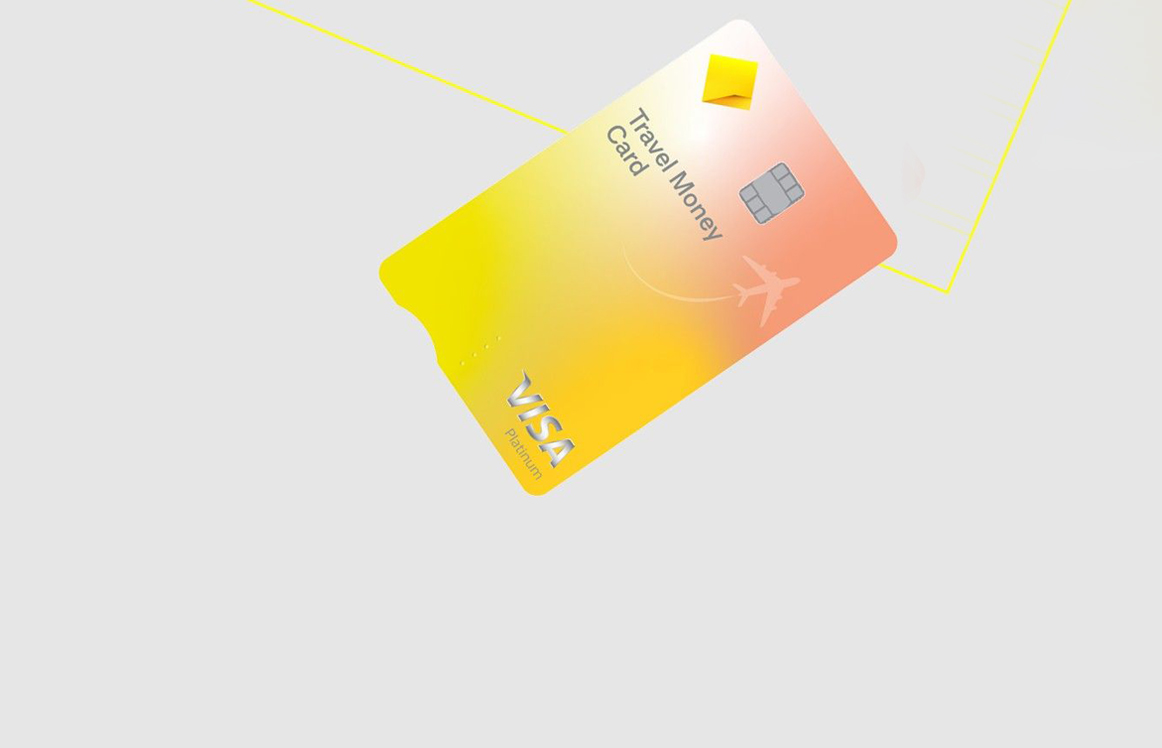
Travel Money Card
Lock in exchange rates and load up to 13 currencies on one account to easily access your money while you’re travelling.
Features & benefits
$0 card issue fee.
Order a Travel Money Card for free in branch or online (search 'Travel Money Card' in the CommBank app or log into NetBank ).
Lock in exchange rates
Load up to 13 currencies on one card before your trip, so you know how much you have to spend, no matter how the Australian Dollar moves.

Spend anywhere in the world
Shop online, in-store, or over the phone wherever Visa is accepted, plus get access to Visa ® travel offers .
Easily manage your travel budget
Manage your holiday money and track your spending via the CommBank app or NetBank.

Your purchases, covered
Lost or stolen personal belongings? We may be able to cover the cost to repair or replace them up to 90 days after purchase. 2
Extra card security
Lost, misplaced or stolen card? Lock it and report it in the CommBank app or NetBank.
- Currency converter
Exchange rates
Load up to 13 currencies on one account
Lock in exchange rates and load up to 13 currencies easily on one account – wherever you are in the world – through NetBank or the CommBank app:
- United States Dollars (USD)
- Euros (EUR)
- Great British pounds (GBP)
- Australian Dollars (AUD)
- Japanese Yen (JPY)
- New Zealand Dollars (NZD)
- Hong Kong Dollars (HKD)
- Canadian Dollars (CAD)
- Singapore Dollars (SGD)
- Thai Baht (THB)
- Vietnamese Dong (VND)
- Chinese Renminbi (CNY)
- Emirati Dirham (AED)
No load or reload fees
You can load up to 13 currencies on your Travel Money Card with no load or reload fees. The exchange rate is the CommBank Retail Foreign Exchange Rate at the time of the conversion.
When you’re ready to pay for something, we will always try to complete the transaction for the country you are in. Make sure you have enough of the correct currency for the country you’re in on your card to avoid additional fees. If you don’t have enough of the local currency, we’ll use the next available currency instead, so long as there’s enough of it loaded on your card.
If you load multiple currencies on your Travel Money Card, you can change the order (the next available currency) anytime online.

Rates & fees
See all fees and charges
Who can apply
To get your Travel Money Card, you’ll need to:
- Be at least 14 years old;
- Be registered to use NetBank, or register online New to CommBank? Sign up to NetBank at your nearest branch ;
- Provide a valid email address; and
- Have an Australian residential address
How to apply
Before your trip.
- Order a Travel Money Card in the CommBank app (search 'Travel Money Card'), NetBank , or at your nearest branch .
- Load at least AUD 50 or the foreign currency equivalent to get started
- Once you’ve got your card, activate and set your PIN online in NetBank, or under Cards in the CommBank app
- Lock-in the exchange rate by loading currency on your card in NetBank or the CommBank app
How it works
During your trip.
- The local currency will be automatically applied when you pay for something, as long as it’s loaded on your card and you have sufficient funds
- Reload in real time , fee-free if your balance gets low
- Stick to daily transaction limits
- The maximum value of purchases per day is unlimited, however no more than your available balance
- The maximum amount you can withdraw from ATMs per day is AUD 2,500 or the foreign currency equivalent. Keep in mind most ATM operators have a limit on how much you can withdraw from an ATM per transaction
- The maximum amount for over-the-counter withdrawals per day is AUD 2,500 or the foreign currency equivalent.
When you’re home
- Got leftover currency? Exchange it for another currency or back into your CommBank account from NetBank or the CommBank app
- Top up your Travel Money Card (it’s valid for 4 years) in preparation for your next trip
- Donate your foreign (and local) currency to any CommBank or Bankwest branch and every cent will go to UNICEF
- How to manage your Travel Money Card
You’ve got your new card – here’s how to get the most out of it.
Find detailed info on getting started, loading and reloading currencies, setting a currency order, checking your balance and tracking your spend. Plus, info on Purchase Security Insurance Cover and access to Visa ® travel offers .
Manage your Travel Money Card

Need foreign cash? Have it ready before you travel
If you’re a CommBank customer, you can buy or sell up to 9 foreign currencies at selected CommBank branches in exchange for Australian Dollars.
You can also order foreign cash in over 30 currencies online – even if you’re not a CommBank customer.
Discover Foreign Cash

Planning an overseas trip?
Discover travel tips to help make the most of your European summer holiday.
See travel tips

Emergency support & tools
What to do if you’ve lost your card or it’s stolen.
If you’ve lost your Travel Money Card, or you think it might’ve been stolen, we can have an emergency replacement card sent to you anywhere in the world.
You may also be eligible for an Emergency Cash Advance, giving you access to cash within 24-48 hours (often on the same day).
Call us in an emergency on:
- 1300 660 700 within Australia
- +61 2 9999 3283 from overseas (reverse charges accepted).
When calling from overseas using your mobile, standard roaming charges may apply. To avoid roaming charges, call the international operator in the country you’re in from a landline and give them our reverse charges number +61 2 9999 3283.
Tools & calculators
- Saving calculator
- Budget planner
- Managing multiple currencies on your Travel Money Card
- Travelling overseas: 10-step money checklist
- Beginners guide to exchange rates
- Online banking while overseas
- Planning an overseas holiday
We can help
Your questions answered
Get in touch
Visit your nearest branch
Things you should know
1 The cash withdrawal fee will not apply to cash withdrawals made in Australia.
2 For more information relating to the complimentary Purchase Security Insurance refer to Travel Money Card Complimentary Insurance Information Booklet (PDF) .
As this advice has been prepared without considering your objectives, financial situation or needs, you should before acting on this advice, consider its appropriateness to your circumstances. The Product Disclosure Statement and Conditions of Use (PDF) issued by Commonwealth Bank of Australia ABN 48 123 123 124 for Travel Money Card should be considered before making any decision about this product. View our Financial Services Guide (PDF) .
To raise a dispute related to your Travel Money Card please complete this form for transactions (PDF) or this form for ATM disputes (PDF) .
Any withdrawal or balance enquiry fee will come from the currency for which you are using your card. If this currency is not loaded on your card, the fee will be taken from the first (or sole) currency loaded on your card. Any SMS balance alert fee will come from the first (or sole) currency loaded on your card.
The target market for this product will be found within the product’s Target Market Determination, available here .
- United States
- United Kingdom
The best travel money cards for Australian travellers
Compare prepaid travel cards, debit cards and credit cards to find the best option for your next overseas trip..
In this guide
Using your debit card overseas
Debit cards with no international transaction fees, best prepaid travel cards to load foreign currency, find a better travel money card, australian travel statistics, 1. new zealand, 2. indonesia.
- 4. The UK, Canary Islands & the Isle of Man
6. Thailand
8. singapore, 10. vietnam.
Travel Money Cards
What you need to know
- The most important features to compare are the foreign transaction fees, exchange rates and usability.
- If you want to withdraw cash, a prepaid travel card or debit card will likely be cheaper than a credit card.
- It is a good idea to have several travel money options in case of loss, damage or theft.
Debit cards allow you to spend the money you have in your bank account, instead of having to pre-load it like a prepaid travel card. There are some debit cards that don't charge any international transaction fees and even some that allow you to hold multiple currencies - like the HSBC Everyday Global Account .
We update our data regularly, but information can change between updates. Confirm details with the provider you're interested in before making a decision.
Learn how we maintain accuracy on our site.
Instead of a debit card, a prepaid card lets you load up on the currency you need before you get there. There are several options for this, but the right one for you will largely depend on the currency you're going to be using.
We've looked at the top 10 most popular travel destinations for Aussies based on the Australian Bureau of Statistics overseas departure and arrivals data and rounded up the most relevant travel cards you could use in each location. From the rolling hills of New Zealand to the bustling streets of China, read on for the travel card tips you'll need for your next holiday.
Australia is a nation of travellers. According to the Australian Bureau of Statistics, there were 8,337,080 resident returns from overseas for the year 2022 - 2023. The most popular reason we travel is for a holiday, and the median trip duration is 15 days.

The land of towering snow-capped mountains, crystal blue lakes and hobbits and elves often tops Australia's list of favourite travel destinations. Conveniently, most Australian prepaid travel cards support New Zealand dollars.
See our New Zealand travel money guide for more tips to help you prep for your trip over the Tasman.
Aussies love the tropical climate, beaches and poolsides of Indonesia. Despite our close proximity to Indonesia and Australia's reputation for frequenting tourist destinations such as Bali, no Australian travel cards currently support Indonesian rupiah.
However, as Visa and Mastercard are accepted in Indonesia, you can still use an Australian travel card when you're there. You can find travel cards that don't charge a currency conversion fee when you spend in an unsupported currency.
Browse our Indonesia travel money guide for more travel money options.
The land of stars and stripes also has a soft spot in the heart of Australian travellers. So, it's probably no surprise that most Australian prepaid cards support US dollars.
See our US guide for the best travel money options for your next trip to the states.
4. The UK, Canary Islands & the Isle of Man
If you're making a Eurotrip to the UK, you'll be glad to know that most Australian prepaid travel cards support the pound sterling.
Use our UK travel guide for everything you need to plan your next trip to the UK.
The Indian rupee isn't supported by any Australian travel cards. So, if you're travelling to the hustle and bustle of India, you might want to look for travel cards that don't charge any currency conversion fees when spending in an unsupported currency.
Thailand is a popular holiday destination for many Aussies seeking sunshine and rich culture, so it's lucky that quite a few Australian travel cards support the Thai baht.
Use our Thailand travel money guide to research more travel money options for your trip.
While the white sands and crystal blue waters of Fiji are a favourite for Aussie travellers, no prepaid travel cards currently support the Fijian dollar. However, as Mastercard and Visa are widely accepted in Fiji, there are still a few options available for holidaymakers drawn to this island oasis.
See our Fiji guide for more travel money tips and tricks.
If you're taking a trip to the Garden City, there are a few travel card options to choose from.
You can find more travel money options for your trip to Singapore with this guide .
Whether you want to bask in the beauty of cherry blossom season or tear up the snowy slopes, there are plenty of travel card options if you're planning a trip to Japan.
See our Japan guide for more travel money tips for your next holiday.
A land of beautiful beaches, Buddhist pagodas and bustling cities, Vietnam makes the list of Australia's most popular travel destination. If you're planning a trip and want to spend in Vietnamese dong, there are travel card options to choose from.
You can find more travel money options for your trip to Vietnam with this guide .
While there's no single best travel money card out there, it's easier to narrow down your search when you know which cards support the local currency you'll be spending in on your trip. Once you've done this, look for any issue fees, ATM withdrawal fees and loading costs to help compare your travel money options and pick the right travel card companion for you.
Latest travel headlines
- Coles iPhone Velocity points hack: Score a free Virgin flight
- Earn Qantas Points with Netflix and Woolworths right now: Here’s how
- Is it worth paying extra on Jetstar to earn Qantas Points?
- Qantas promises improved Frequent Flyer by April
- Woolworths Qantas iPhone deal is back! Get 20,000 Qantas Points
Sally McMullen
Sally McMullen was a creative content producer at Finder. Sally wrote about credit cards for almost 5 years, authoring almost 900 articles on Finder alone. She has also been published in Yahoo Finance, Dynamic Business, Financy and Mamamia, as well as Music Feeds and Rolling Stone. Sally has a Bachelor of Communication and Media Studies majoring in Journalism (Hons) from the University of Wollongong.
More guides on Finder
The Wise Travel Money Card supports over 40 currencies, with free loading by bank transfer and an instant, virtual card. Here’s how its other features compare.
Revolut offers virtual and physical Visa cards, support for over 30 currencies and other travel perks – plus 3-month Premium trial with this offer.
Use finder's interactive world map to learn about variations in beer prices globally. Find out where in the world you'd pay a whopping $15.10 for a pint.
Discover the travel money options available for young people and how to prepare for a trip overseas.
Want to avoid fees and charges when using your card overseas? This guide explains the most common pitfalls when using travel cards.
This guide explains how you can get back any leftover funds from your travel money card after your trip.
Use this guide to understand foreign currency exchange and discover how to get the best deal.
Spend in up to 13 major currencies, lock in exchange rates and manage your account with the CommBank app when you use the Commonwealth Bank Travel Money Card.
Spend in 11 currencies wherever Mastercard is accepted and save on currency conversion fees with the Cash Passport Platinum Mastercard.
Ask a Question
Click here to cancel reply.
You are about to post a question on finder.com.au:
- Do not enter personal information (eg. surname, phone number, bank details) as your question will be made public
- finder.com.au is a financial comparison and information service, not a bank or product provider
- We cannot provide you with personal advice or recommendations
- Your answer might already be waiting – check previous questions below to see if yours has already been asked
11 Responses
I am going on a cruise with stops in India, Singapore, Dubai and Sri Lanka. Apart from getting cash what is the best way to take money there? I will only be in Sri Lanka for one day.
Hello there Ian,
Thank you for your inquiry.
Like the page you’re on, you have travel card alternatives for Singapore and India. However, India does not support Australian travel cards, but rather you can look at your travel card choices that don’t charge currency conversion fees.
In Dubai, you may begin looking at your travel card.
In Sri Lanka, Their Government has tight control over the national money and there are strict points of confinement on the measure of rupees you can get in and out of the nation. Aside from cash, you may look at your prepaid travel cards, debit or credit card choices on our page for Travel guide in Sri Lanka.
You may likewise jump at the chance to consider a Debit Card or Credit Card with low or no currency conversion fees.
I hope this information helped.
Cheers, Asia
Travelling to Mexico and Cuba and don’t know whether there is any card better than a Westpac Global Currency Card all things considered.
Thank you for visiting Finder.
For options in getting the most suitable travel money card for you, you may want to visit our travel money option for Mexico as well as our travel money guide for Cuba. From there you may compare cards and select which one would suit your needs. Once you have chosen a particular card, you may then click on the “Go to site” button and you will be redirected to the bank’s website where you can proceed with your application or get in touch with their representatives for further assistance.
Please ensure you review the relevant Product Disclosure Statements/Terms and Conditions before applying.
Cheers, Joanne
What about Peruvian Soles? Or Chilean Pesos? Do I have to put in USD first?
Thanks for your question.
Currently, prepaid travel money cards do not support the currencies of South American countries. You would have to load them with Australian dollars and withdraw the local currencies such as nuevo sol and peso. However, this will attract overseas ATM fees and currency conversion fees.
If you wish to avoid these fees you can use debit or credit cards. Moreover, you can consider a travel card with no currency conversion fees. Check out our Travel Money Guide to Peru to compare your options. You may also check your travel money options for South America.
Before applying, please ensure that you read through the relevant Product Disclosure Statements/Terms and Conditions when comparing your options before making a decision on whether it is right for you. You can also contact the provider if you have specific questions.
Cheers, Liezl
Travelling to Bali with a Qantas Cash card. I understand I can’t load it with rupiah, however can use it where Mastercard accepted. I’m not clear though on what the currency conversion fee is. Above it says that you can “avoid currency conversion fees when spending Indonesian rupiah with this card.” However you can’t load Rupiah in the card. Can you explain further please?
Hello Jacqui,
The currency conversion fee is when you load Australian dollars on your card and then convert them to Rupiah while you’re traveling in Indonesia. In this case, you are simply converting the currency on a “as per needed basis”, Qantas daily rate for the currency you’re spending in will apply. You can use their currency conversion tool on the website to check the exchange rate daily.
If in case you are interested, please explore different travel money options in Indonesia .
Please take time to download the Product Disclosure Statement of this product to know more about the terminologies and fees associated with use.
Hope this clarifies.
Cheers, Jonathan
What about. Europe comparison for travel cards?
Hi Suzanna,
Thanks for your inquiry.
Here is the page where you can compare Travel Cards for Europe – https://www.finder.com.au/travel-money/europe . It also has a comparison for Travel Credit Cards and Travel Debit Cards.
Hope this information helped.
Cheers, Rench
Hi Suzanne,
You may be interested to check the available option/s for travel cards in Europe on our website. Check that page and you will also find more details about how you use travel money cards in Europe.
I hope this information has helped.
cheers, Harold
How likely would you be to recommend finder to a friend or colleague?
Our goal is to create the best possible product, and your thoughts, ideas and suggestions play a major role in helping us identify opportunities to improve.
Important information about this website
Advertiser disclosure.
finder.com.au is one of Australia's leading comparison websites. We are committed to our readers and stands by our editorial principles
We try to take an open and transparent approach and provide a broad-based comparison service. However, you should be aware that while we are an independently owned service, our comparison service does not include all providers or all products available in the market.
Some product issuers may provide products or offer services through multiple brands, associated companies or different labeling arrangements. This can make it difficult for consumers to compare alternatives or identify the companies behind the products. However, we aim to provide information to enable consumers to understand these issues.
How we make money
We make money by featuring products on our site. Compensation received from the providers featured on our site can influence which products we write about as well as where and how products appear on our page, but the order or placement of these products does not influence our assessment or opinions of them, nor is it an endorsement or recommendation for them.
Products marked as 'Top Pick', 'Promoted' or 'Advertisement' are prominently displayed either as a result of a commercial advertising arrangement or to highlight a particular product, provider or feature. Finder may receive remuneration from the Provider if you click on the related link, purchase or enquire about the product. Finder's decision to show a 'promoted' product is neither a recommendation that the product is appropriate for you nor an indication that the product is the best in its category. We encourage you to use the tools and information we provide to compare your options.
Where our site links to particular products or displays 'Go to site' buttons, we may receive a commission, referral fee or payment when you click on those buttons or apply for a product. You can learn more about how we make money .
Sorting and Ranking Products
When products are grouped in a table or list, the order in which they are initially sorted may be influenced by a range of factors including price, fees and discounts; commercial partnerships; product features; and brand popularity. We provide tools so you can sort and filter these lists to highlight features that matter to you.
Terms of Service and Privacy Policy
Please read our website terms of use and privacy policy for more information about our services and our approach to privacy.
The Best Travel Debit Cards for Australians In 2024
Tom Goward | 27/03/2024
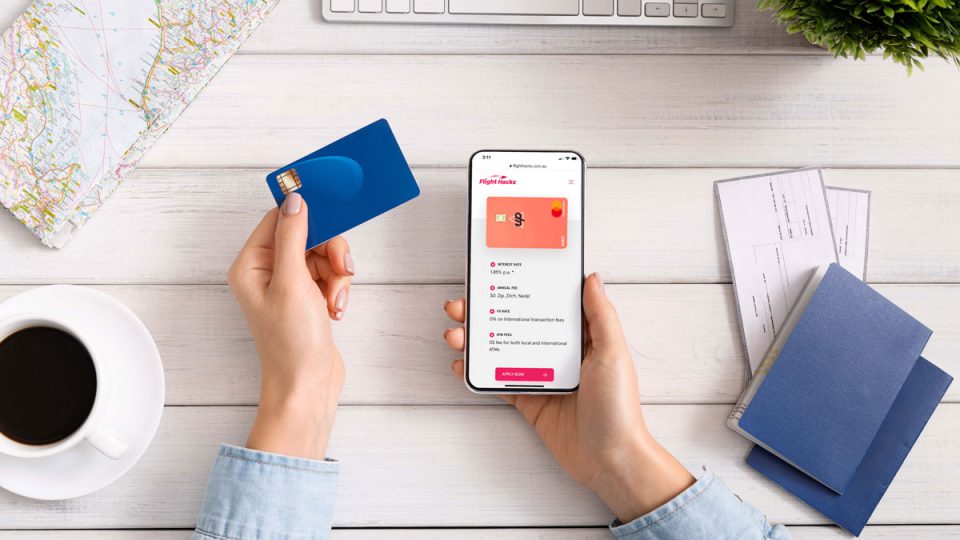
TLDR ; our experts rated Up ($15 free bonus), Ubank ($10 free on with code C7N1TAZ ) & Revolut (Free $15 exclusive Flight Hacks bonus) as the best travel debit cards for 2024.
No matter where you’re going or for how long, making use of a good travel debit card is one of the easiest ways to save money overseas. The problem is that amidst the excitement, the importance of selecting the best travel debit card often slips the minds of many Australians until the eleventh hour. Most novice travellers fail to realise their mistake until arriving home with an overstuffed suitcase and card fees that could’ve been easily avoided.
The harsh reality is that banks and airport currency exchange services will often rip you off, despite their claims of ‘zero fees’ or ‘0% commission’. Think about it, how can an exchange booth afford the insane airport rent if they don’t make a cent from running their business?!
The good news is that Australians have a few brilliant options when it comes time to select a travel money card. While the array of choices can be overwhelming, with a little research and planning, you can save a considerable sum just by using the right card!
WATCH: our video comparing 11 of the most popular travel cards in Australia!
In this post:
What About Prepaid Travel-Branded Cards?
Foreign exchange rates: visa vs mastercard, making a €500 card purchase, withdrawing €500 from an atm, up debit card, ubank debit card, revolut australia, macquarie transaction account, hsbc everyday global account, wise multi-currency account, honourable mentions – best travel debit card, qantas travel money, commbank travel money, travelex money card, nab visa debit, anz plus transaction account, westpac travel money, ing orange everyday, summing up: our expert tips, travel debit cards faqs, global spending: travel debit card 101.
Many amateur travellers will use their day-to-day debit card overseas, simply because it’s easy to use a card that already has your money loaded and ready to go. But before tapping away, it’s important to understand the fees you’ll be in for.
When making international purchases, there are three main fees you should understand;
- International Transaction Rate: Charged when you make a purchase with an overseas merchant, often as a percentage of the total transaction. In Australia, many banks charge a foreign transaction fee of 3% or higher.
- Overseas ATM Withdrawal Fee: Charged for the privilege of withdrawing your own money at an overseas ATM, typically a fixed dollar amount per withdrawal. Sometimes the ATM operator will charge an additional fee for using their ATM. How fun!
- Foreign Exchange Markup: This is where banks are especially sneaky. While you might think you’re getting the real exchange rate, like you’d see searching Google or XE, banks will make up their own rate which includes a hidden fee on top. Of course, you will only be shown the ‘final price’ to hide the fee applied to the real rate.
If you’ve been looking for the perfect card to use overseas, you would have seen big banks and loyalty schemes offering travel money cards. But just because your day-to-day bank offers a dedicated travel card, it doesn’t mean you should get one. In fact, if a card has the word “travel” as part of its name, RUN AWAY while you still can. That is, unless you like being shafted by some of the richest companies in Australia.
Prepaid options like the Commbank Travel Money Card and Qantas Travel Money Card typically offer a portal where you can preload a foreign currency, before arriving at your destination. While it might sound logical to have your money in the correct currency before payment, the fees involved can be astronomical. Despite the promise of “fee-free load options”, there’s almost always a huge foreign exchange markup when you send Australian Dollars to a prepaid card.
The other downside is that you’re forced to lock-in the exchange rate when loading Australian Dollars. While this is marketed as a perk, it’s also a potential disaster if the exchange rate moves against you, after you’ve transferred your entire spending money across. So, unless you have a crystal ball that predicts when the exchange rate is best, I wouldn’t see it as a benefit myself.
Although Visa and Mastercard don’t offer cards themselves, they do have a say in determining the foreign exchange rate you’ll get. While prepaid cards devise their own inflated rates, the best cards, which we will share below, utilise the Visa or Mastercard exchange rate without applying a markup. The difference between the two is almost non-existent, so there is no point in selecting your card based on the payment network.
The table below shows how much Visa and Mastercard offered for 1 AUD as of 27th March 2024. As you can see, the rates are identical, except for JPY where the difference is minuscule anyway.
How Much Can I Save By Using A Good Card?
How much you can save will depend on the fees associated with your day-to-day card, how much you spend and where you spend it. Let’s compare transactions if you were to use the Commbank Travel Money, Qantas Travel Money or Up Debit cards.
The Commbank Travel Money card charges a flat 3% fee for currency conversion on purchases and withdrawals. Qantas Travel Money claims to have “no fee” for purchases in their marketing material, but their foreign exchange rate adds an insane markup.
As an example, say you paid your 500 Euro hotel bill using one of these cards. Based on our testing (on 27th March 2024), Commbank would charge a $24.92 fee, while Qantas slaps a disgusting $47.13 or 5.67% markup on top of the real exchange rate. Remember – the Qantas card has access to Mastercard’s foreign exchange rates, and if they so pleased, could offer the same true fee-free rate as Up’s Mastercard option.
The Commbank Travel Money card charges $3.5 for ATM withdrawals, charged in the currency from which you’re making the withdrawal. Qantas charges a different rate depending on which currency you’re withdrawing, but for Euros, it’s €1.5. Of course, Up doesn’t charge a fee.
As an example, say you need to withdraw 500 Euros from an ATM. The conversion fees are the same as above, but you’d need to pay an additional fee for using the ATM. Keep in mind that the ATM you use could charge its own fee, but this will apply to most cards so it’s the same across the board.
Our Picks: Best Travel Debit Cards In 2024
Now that you understand how critical it is to utilise a good debit card overseas, it’s time to explore the best options for Australian travellers. Not all banks provide the same features, so be sure to shop around and find a good fit for you. We’d also recommend packing at least one backup card in the event your main card becomes lost or stolen.
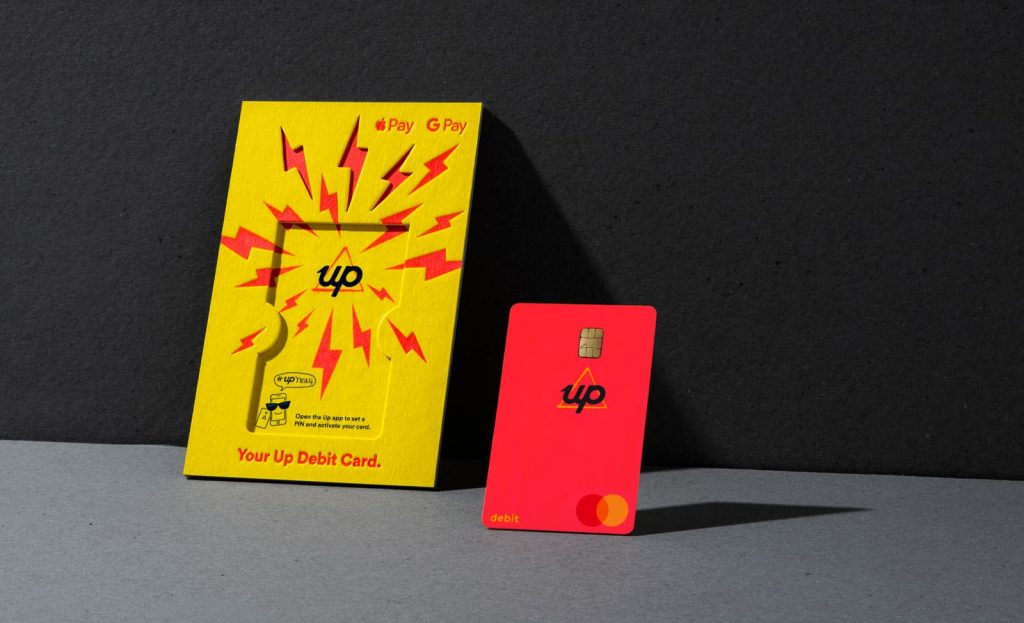
- Payment Network: Mastercard
- International Transaction Rate: 0%
- Overseas ATM Fee: $0
- Account Fee: $0
Sign-Up Bonus: $15 – For a limited time, you can receive a $10 welcome bonus for becoming an Upsider! Join using our Up Bank invite code to score $15 after joining.
Up is a digital bank (owned by Bendigo & Adelaide Bank) that proves it’s possible to love your bank. Setup is a breeze, and of course, Up charges absolutely nothing when you use an Up Debit card overseas. As a neobank, Up doesn’t have any physical branches, with everything easily handled from within the best banking app I’ve ever used. It’s super clean by design and packed full of useful features like payment splitting, the ability to detect recurring charges, easy payments to friends by name and detailed spending insights.
Want the full story? Check out our detailed Up Debit Card Review !
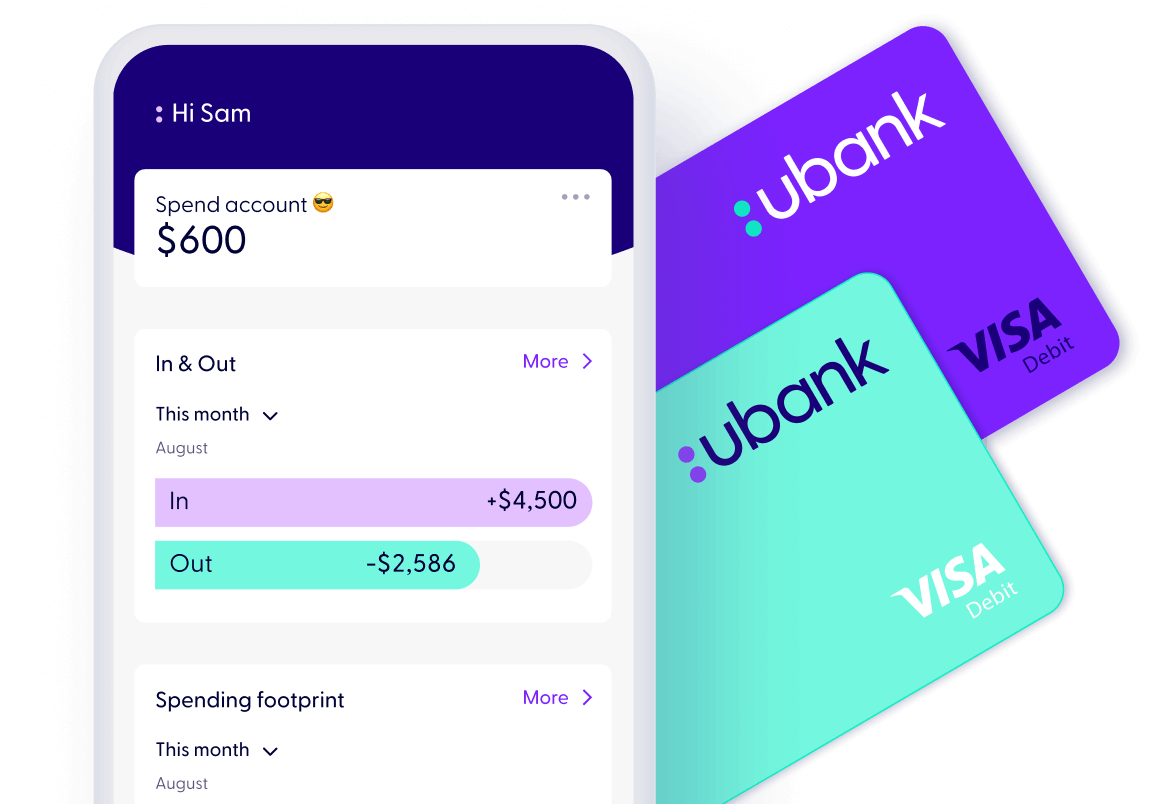
- Payment Network: Visa
Sign-Up Bonus: $10 – For a limited time, you can use our Ubank referral code C7N1TAZ to score $10 in your new Ubank account after making 5 purchases within 30 days of signup.
Ubank is another digital bank with zero fees for using your connected debit card overseas. While the app isn’t quite as fantastic as Up’s offering, Ubank is still a great option. The upside is that Ubank also offers savings accounts that have consistently given some of the highest interest rates in Australia. Not to mention joining takes just a few minutes and they offer a joint account option.
After more info? Read out our complete Ubank Debit Card Review !
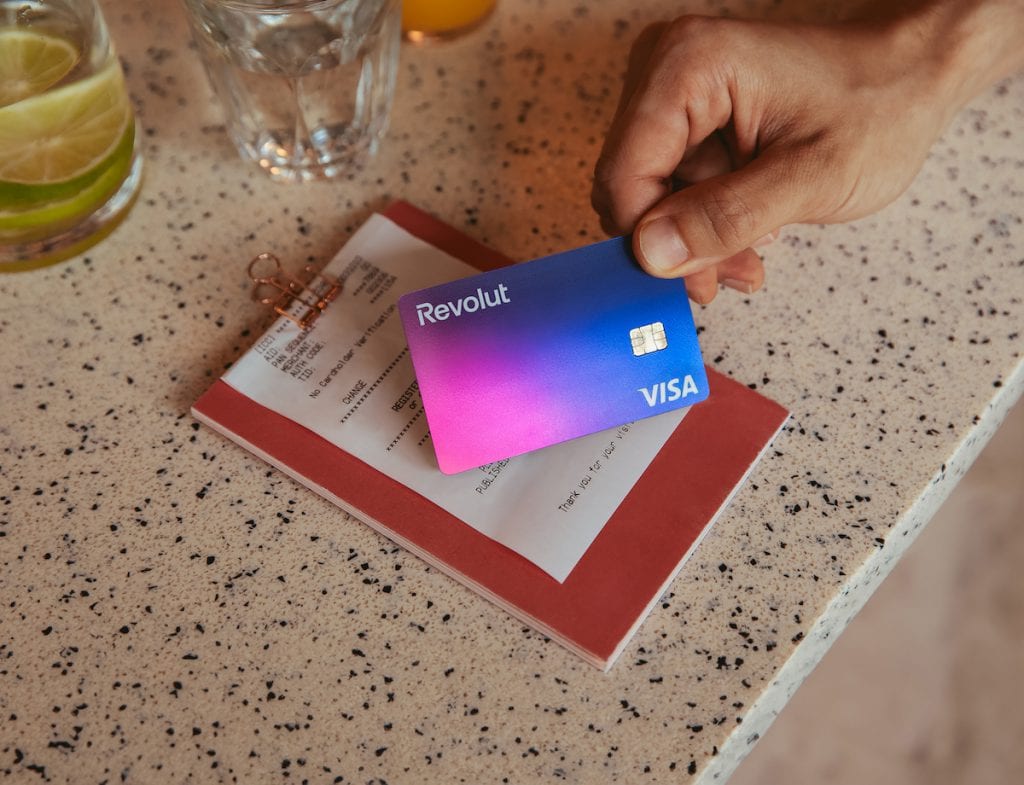
- Overseas ATM Fee: $0 ($350-$1400/m fee-free limit based on plan)
- Account Fee: $0-$24.99/month (based on plan)
Sign-Up Bonus: We’ve partnered with Revolut to offer Flight Hacks readers an exclusive $15 in their new account. Join via this link to score $15 after making 1 transaction within 14 days.
Everything money is accessible with Revolut, from spending on your debit card to investing in stocks and EFTs, crypto, gold and silver. From a travel perspective, Revolut offers minimal fees and the ability to preload your card with one of several currencies or spend using AUD at the current exchange rate. SmartDelay also offers complimentary airport lounge passes for you and up to 3 friends when your flight is delayed by more than an hour.
Revolut is also great for those travelling with anyone aged 6 to 17, thanks to the option for parents and legal guardians to create a linked account for their children. The main account holder gains access to a bunch of insights and controls, while under 18’s can spend their own funds with the same money-saving perks as the main account holder.
In Australia, Revolut offers users a free Standard plan, in addition to increased perks on a Premium ($9.99/month) or Metal ($24.99/month) membership. While also including a solid reinforced steel card, the Metal option offers monthly benefits like three fee-free international payments, unlimited fee-free weekday currency exchange and fee-free ATM withdrawals up to $1,400. Not willing to pay for a full year? You can always upgrade for your trip and cancel the plan once you return home.
Ready to learn more? View our Revolut Australia guide !
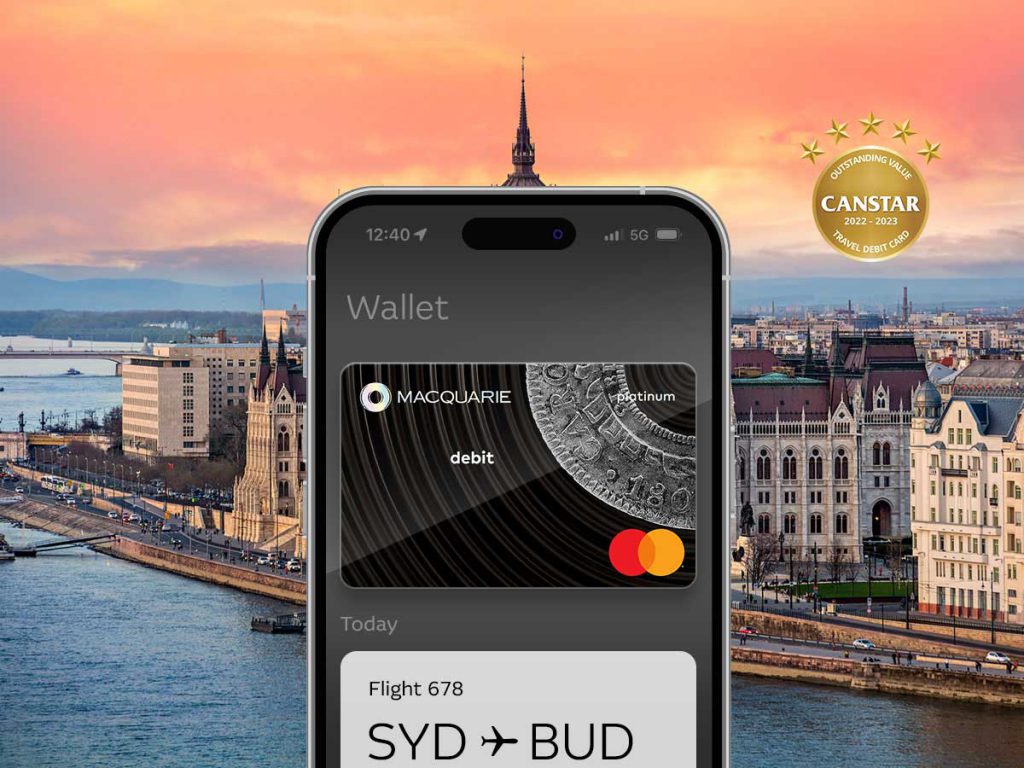
- I nternational Transaction Rate: 0%
If you’re after a debit card for travel from a big bank, but not quite big enough to rip you off, Macquarie has you covered. Although the app and online banking portal are in desperate need of an update, the product itself is hard to fault.
Macquarie also offers a few perks like a luggage return service that will pester the airline on your behalf, if they mishandle your checked baggage. There is a small service fee for this, but if your bag is not returned within 96 hours, you’ll receive a $100 payout per lost bag. In addition, cardholders have access to a concierge service, card purchase cover and wallet guard cover. Considering this is just a debit card, those are some nice benefits to have up your sleeve.
Deposits made on a Macquarie Transaction Account can also earn interest, up to 4.75% p.a (as of March 2024).

HSBC’s worldwide reach makes its Everyday Global Account an attractive offering. If you need to make an ATM withdrawal, you can visit a HSBC ATM to guarantee zero withdrawal fees around the world! The exception is in Argentina, France, Greece, Mexico, Malta and Turkey where there is a small fee.
There’s an option to buy and transfer between ten currencies (AUD, USD, GBP, EUR, HKD, CAD, JPY, NZD, SGD, CNY), although HSBC does hide a foreign markup here by using their own HSBC Daily Exchange Rate. For the best rate, simply load AUD onto the debit card before spending overseas, where the Visa exchange rate will apply with zero markup.
Plus, if you deposit at least $2,000 into your Everyday Global Account before the last business day of each calendar month, you can earn 2% cashback up to $50 per month. You’ll earn cashback on eligible purchases with Australian merchants under $100, when you spend via payWave, Apple Pay or Google Pay. There are a few transactions that won’t be eligible, including public transport, car parking and vending machines.
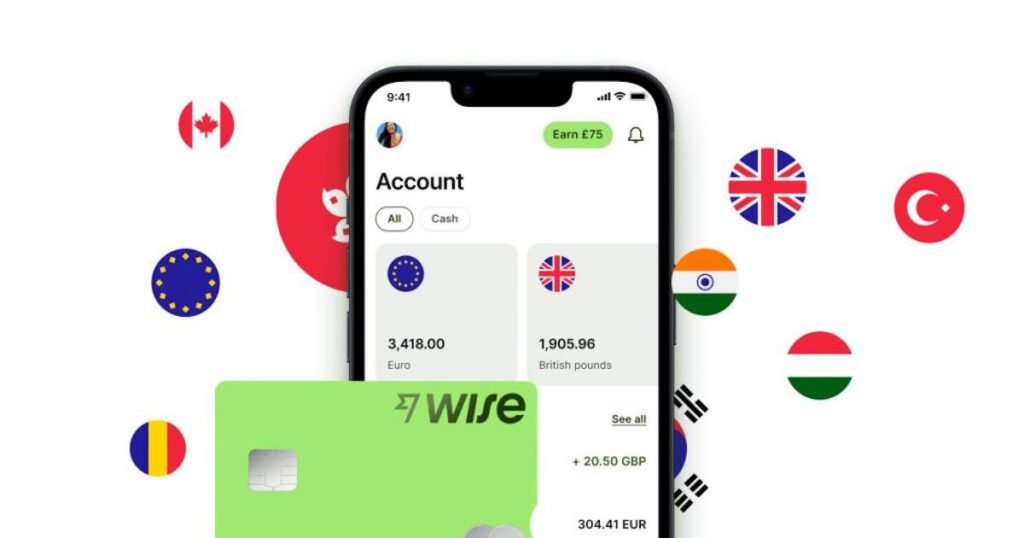
- Overseas ATM Fee up to 350 AUD/month: $0
- Overseas ATM Fee over 350 AUD/month: $1.50 ($1.50+1.75% for 3+ withdrawals)
- Card Load Fee: 0% to 2% depending on currency
- Physical Card Fee: $10
Wise (previously Transferwise) used to offer one of the best cards out there, until moving to an overly complex fee structure that feels very ‘banky’. That includes a $10 fee if you’d like a physical debit card, and high fees for withdrawing money overseas, once you go over the small monthly allowance. We do appreciate that those fees aren’t hidden, and you’ll see the exact exchange rate and the Wise fee applied before completing a transfer.
Because they still offer a real mid-market rate and are one of the best options for transferring foreign currency between friends, Wise still makes our list. They also offer a cool virtual card feature, that can be useful for pesky subscriptions or transactions where you want to cancel your card afterwards, without the consequences.
All up, Wise is a solid option if you need to make a bunch of transfers, but one to avoid if you plan on using overseas ATMs.
Keen on Wise? Why not read our Wise Australia review !
We’d be here all day if we reviewed every Aussie debit card with zero foreign transaction fees and fee-free overseas ATM withdrawals. Our guide above covers the best options for most travellers, but there are a few cards that deserve an honourable mention.
- Bankwest Easy Transaction Account
- ME Bank SpendME Transaction Account
- Suncorp Everyday Options Account
Australia’s Worst Travel Debit Cards Revealed
Many big banks and frequent flyer schemes market travel money cards, but often, these come packed with hidden fees that make them completely useless. Unless you enjoy giving away your money (in which case you should send it directly to us), here are some popular options to avoid;
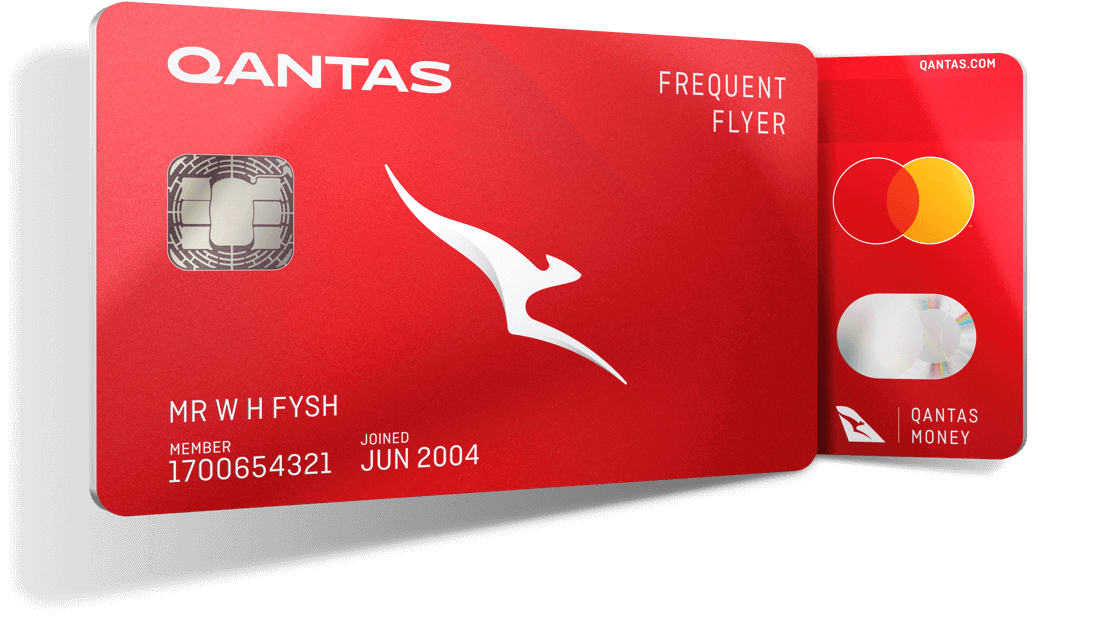
- International Transaction Rate: “free” with hidden markup
- Overseas ATM Fee : approx. $1.95 – $3.00 (varies with currency)
- Card Load Fee: 0.5%
Qantas Travel Money is possibly the worst travel card out there. While advertising zero exchange fees, the ridiculously expensive “Qantas Travel Money Daily Rate” is used when you transfer funds between currencies or make a purchase. For example, in our €500 spend test above, using the Qantas Travel Money would cost a whopping $47.13 more than using a fee-free Up debit card. That’s a hidden markup of 5.67% – and Qantas will still charge an ATM fee!
For international purchases, you can earn 1.5 Qantas Points for every $1 equivalent spent in foreign currency. Even though we love Qantas Points, the insane nearly 6% markup is a complete ripoff and not worth paying to earn points.
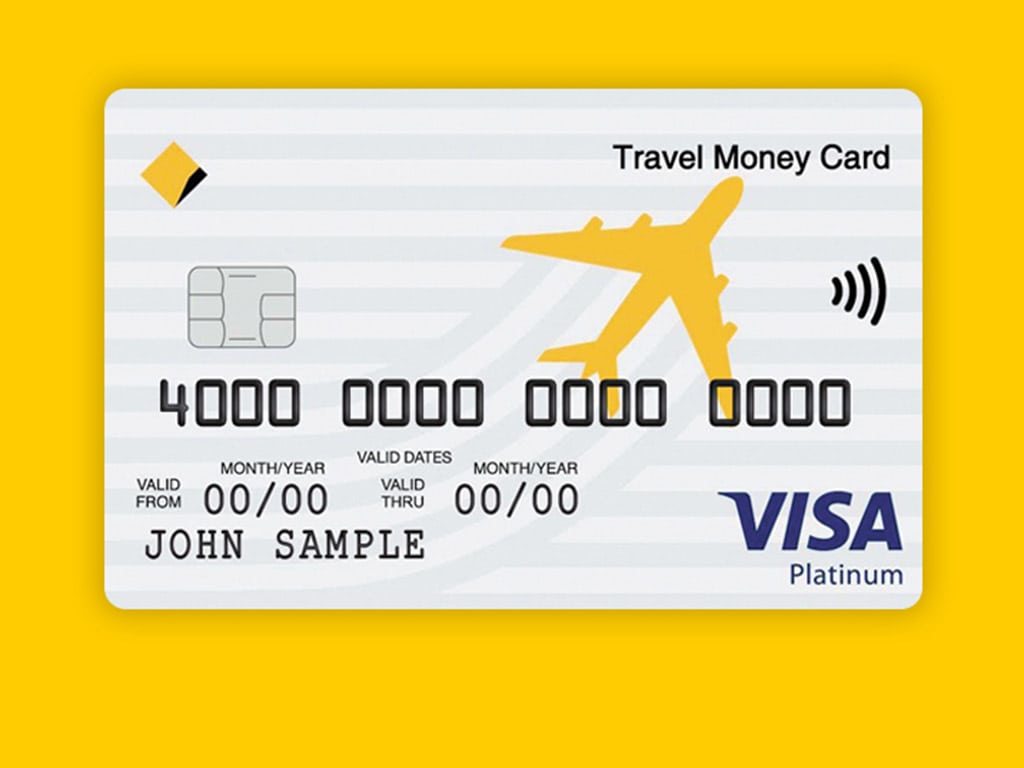
- Foreign Exchange Rate: 3%
- Overseas ATM Fee: A$3.50
- Card Load Fee: “free” with hidden markup
Despite its widespread usage, the Commbank Travel Money Card is another terrible option for overseas spending. That popularity comes from Commbank’s extensive customer base within Australia, with many travellers sticking with the one bank, instead of exploring better alternatives. But the thing is, each of the no-fee options listed above can be funded instantly from your existing Commbank account, so there is no upside to using Commbank Travel Money.
While the card itself is free to hold, there’s a 3% conversion fee applied with each transaction made in a different currency. Additionally, you’ll pay $3.50 for every overseas ATM withdrawal. Commbamk becomes an even worse option once you realise how misleading their advertising of “no reload fees” is. While technically true, Commbank makes up its own exchange rate for card loads, which is approximately 4.4% worse than the Visa rate (at the time of writing). Essentially, this translates to a 4.4% fee when loading foreign currency onto the Commbank Travel Money Card.

- Overseas ATM Fee: $5
- In-Store Load Fee: 1.1% or $15 (whichever is higher)
- Online Load Fee: $0
- Inactivity Fee: $4 monthly (once your card is inactive for 12 months)
- Closure Fee: $10
You only have to read the endless list of fees to realise the Travelex Money Card is about as deceptive as it gets. Travelex does offer unlimited fee-free overseas ATM withdrawals, which is nice, but once you realise the other fees that are adding up and decide to close your account – oh wait, there’s a fee for that! You’ll also need to pay Travelex a monthly fee for the privilege of NOT using your card, once it becomes inactive for 12 months.
Travelex’s PDS says their foreign exchange rate is “set and determined by Mastercard”. What they don’t openly admit is that there is a hidden markup, which is easily spotted when you compare the Travelex exchange rate to that offered by Mastercard.
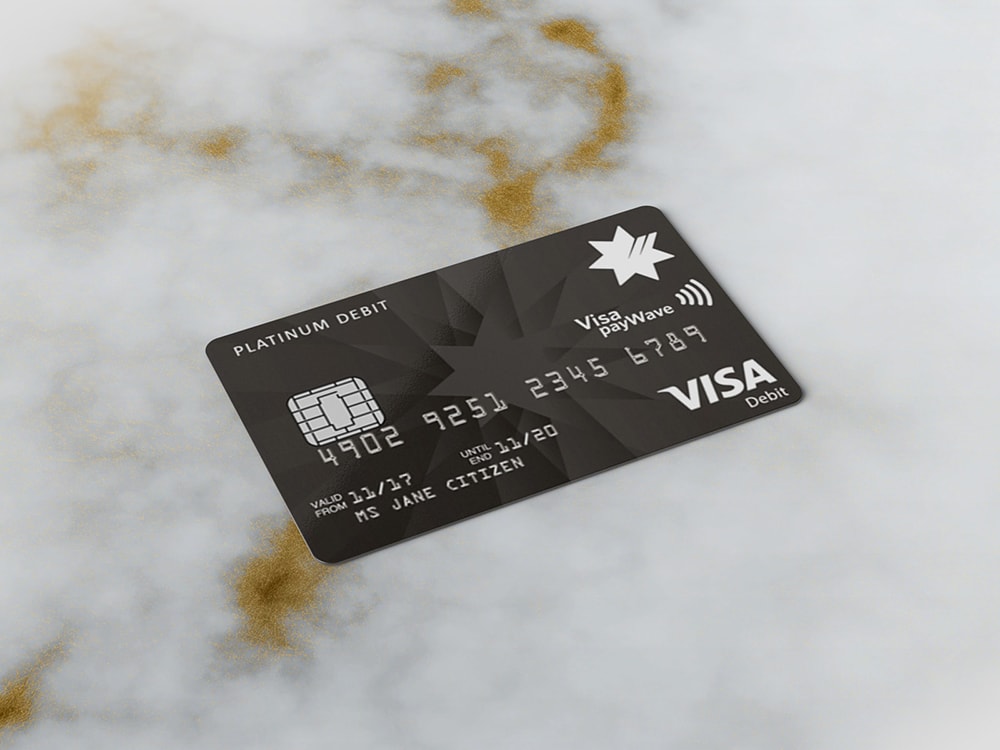
- International Transaction Rate: 3%
When NAB acquired Citibank in Australia, they removed one of the best big-bank travel cards available (the Citibank Saver Plus) and directed new customers to the NAB Visa Debit Card. As far as international spending, this new option is an absolute waste of plastic.
Instead of guaranteed free transitions at Citibank’s enormous overseas ATM network, you’ll get charged $5 at every single overseas ATM – yay! There’s also a juicy 3% international transaction rate, so you’ll pay a fee regardless of how you spend your money overseas.
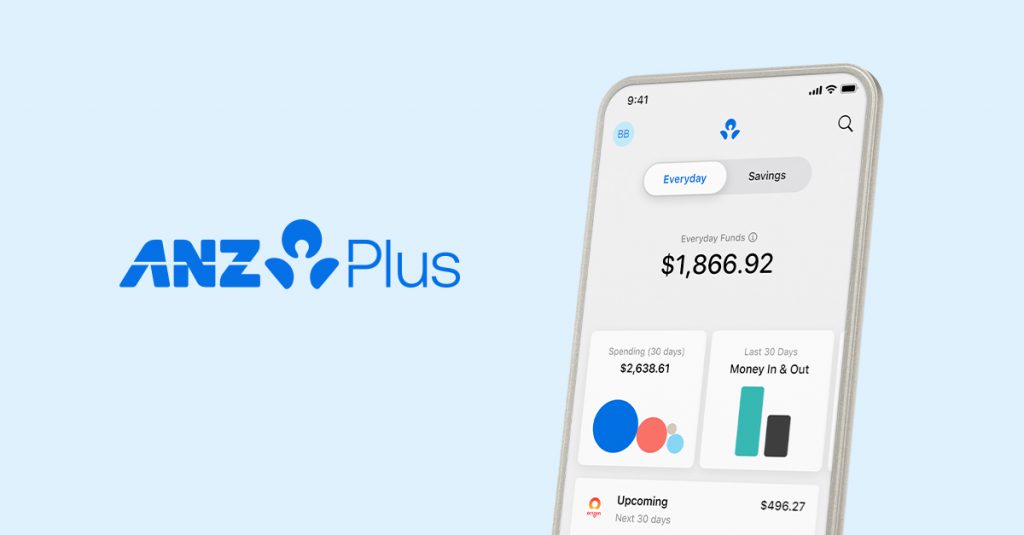
ANZ Plus is ANZ’s new digital banking service that comes with a transaction account and a linked savings account. ANZ and ANZ Plus are like two peas in a pod, except one pea decided to get a snazzy makeover and call itself ‘Plus’. It’s as if ANZ woke up one day and thought, ‘You know what this bank needs? Another version of itself that’s slightly better but nearly identical’.
In all honesty, ANZ Plus is a solid product to use within Australia, with a cool banking app, competitive interest rate and useful insights to help you save money. But the good news stops there, with ANZ’s better version of itself keeping the fees for international use. You’ll pay $5 for overseas ATM withdrawals and a 3% fee on foreign transactions.

- Foreign Exchange Rate: 0%
- Overseas ATM Fee: approx. $1.50-$3.50 (varies with currency)
As far as big-bank travel cards go, Westpac’s Travel Money Card (also known as the Westpac Worldwide Wallett) isn’t quite as terrible as the rest. Although there are still hidden fees when you load your card, as well as when you withdraw money from an overseas ATM. The only reason we say Westpac’s travel card isn’t as awful is that they use the Mastercard rate when spending in currencies you don’t have loaded, without a markup. But overall, this is still one to avoid.
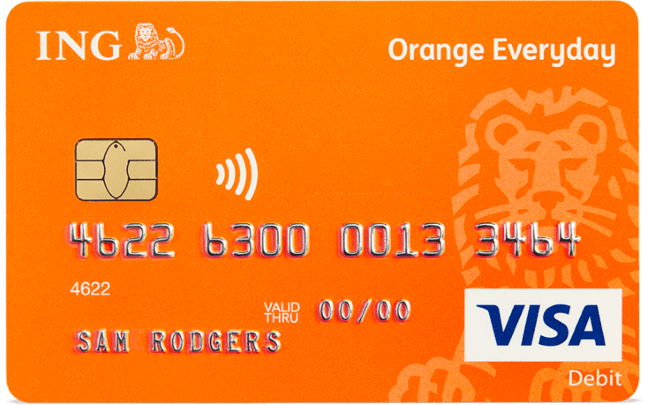
We used to love ING’s Orange Everyday card for overseas spending. But as the card became more and more popular, ING decided to capitalise by introducing international transaction fees, and then raise them even higher.
You can get all international transaction fees rebated, but you’ll need to make at least 5 eligible purchases and deposit at least $1,000 to one of your personal ING accounts every month. The same can be said for overseas ATM withdrawals, of which the first five fees can be rebated provided you make at least 5 eligible purchases and deposit at least $2,000 to one of your personal ING accounts every month.
Because of this unnecessary step to qualify for zero fees, we no longer recommend the ING Orange Everyday for travel.
With so many fee-free travel debit cards available, there’s no reason why you should pay banks every time you need to spend money overseas. With a little research into a travel debit card that suits you, it’s pretty easy to save thousands in bank fees.
Alongside a fee-free card, be sure to employ these tips when spending overseas;
- Never pay in Australian Dollars: It’s one of the biggest travel card scams out there as merchants will make up their own terrible foreign exchange rate, and then charge a fee on top, to convert the local price to Australian dollars. You’ve probably paid with an EFTPOS machine or used an ATM that asks if you want to pay in AUD instead of the local currency. While it might sound like you’re getting a better deal with Australian dollars, this is almost never the case. Be sure to pay in the local currency, using a fee-free card above.
- Check for fees applied by the ATM: While any good debit card will offer zero ATM fees, that doesn’t stop ATM operators from charging their own fees. The machine should tell you before charging a fee.
- Be prepared with multiple card options: In case your card stops working, is stolen or becomes lost it’s a good idea to have a backup card.
- Use your travel debit card for online purchases: Avoid foreign transaction fees when shopping online with overseas merchants by using your card for travel.
I am going to visit [insert destination] – which card should I use?
The cards we recommend above are great for spending overseas. Be sure to consider the features important to you (eg. no ATM fees) when selecting a card for travel.
Which card uses the best currency conversion rates?
We have compared Visa and Mastercard’s spot rates above – there is little difference. Be sure to use a card that uses these spot rates, without applying a markup.
Can I use any Australian debit card overseas?
Nearly all Australian debit cards with a Visa or Mastercard symbol will work around the globe. There are a few exceptions, for example, many cards are currently blocked within Russia and other regions of conflict.
Should I tell my bank where I’m going?
It’s not something we regularly do, but it doesn’t hurt to notify your bank that you’ll be travelling overseas to avoid international purchases being mistaken for suspicious activity.
Why shouldn’t I transfer a bunch of AUD to the currency I will be spending?
It’s a bad idea to convert money ahead of your trip unless you have a crystal ball and know which way the exchange rate will move. If the exchange rate changes in your favour, you could lose out big time. The most accurate rate is achieved with a fee-free card loaded with AUD, using the payment provider’s spot rate
Can I use any frequent flyer credit card overseas?
While your Australian credit card will work overseas, most will charge a 3% fee when spending in a foreign currency. If your card earns a high number of points per dollar, that fee could be worth paying. It just depends how many points you’re going to get, and what fee you’ll be charged.
Which travel debit card is best for international travel?
The best travel debit card is going to have low or no international transaction fees, as well as the features that best suit you. Be sure to check out the best cards listed in this guide.

Chief Operating Officer & Aviation Nerd at Flight Hacks
Off to Singapore and KL in October, got the BankSA Worldide Wallet card. Unsure whether I’d be better off using a card like the Up debit card instead.
Seems like an “ok” product but they charge for ATM withdrawal, in Europe 2 euros per transaction, 2USD in the US and 1.5GBP in the UK unless you use one of their partner ATMs. I’d say use UP if you’re unsure about whether the ATM you’re about to use is affiliated with Bank SA to save on the fee.
Hi Emmanuel, with the up debit card an u bank card , can you load the money from central america on there to take out? and or can you use the card over there anyway?
No, you can’t. If you want to load a foreign currency, I’d use Revolut or Wise.
Re: unbanked & up – both are digital banks so when I go overseas to Europe how do I notify these digital ‘banking institutions’ of my overseas travel dates so they don’t block my cards?
Hi Jefr, digital bank only means they don’t have a physical branch you can walk into. Personally, I can’t recall the last time I went into a physical bank. As for letting them know you’re travelling, I’ve never done this with either Ubank and Up and have had zero problems. When it comes to fraud, 99% of happens online so they do have a function where you can turn on or off international payments within the app. When you’re traveling and shopping, most of the banks now are smart enough to detect genuine transactions and don’t block you.
I have the Citibank one, it’s fantastic I find. Good rate which I locked in before travel so I know exactly how much I have to spend, I am even in Hawaii at the moment and even though the ATM operator says it charges $4.35USD per withdrawal, my card has not charged it.
I think it’s a mistake to lock in rates before you travel unless you have a crystal ball and know which way the FX market is going to move. Personally, I prefer to convert on the spot which gets you the best rate each time.
Not sure why Wise (previously known as Transferwise) makes on the list but HSBC Everyday Global Account didn’t make the cut. They also offer $0 ATM fees (no cap on withdrawal per month) and 0% overseas transaction fee.
Hi JW, it’s definitely not a complete list and HSBC is a pretty good product as well. I’ve got an HSBC Everyday Global Account but don’t use it because the app is a pain.
how about Bankwest https://www.bankwest.com.au/personal/bank-and-save/bank-accounts/easy
Also not a bad product, does pretty much the same as Up/Ubank etc.
what do you think is the best travel card for Moldova? I know not many people go there, but being a non EU country whose currency isn’t in much demand, I think we get stung when withdrawing from an atm. I’m using the QANTAS travel card. It was many currency wallets, but no Moldovan Leu. In Chisinau, Moldova seems to default to taking US dollars. I get the feeling we are double converting. AUD to USD and then to Leu. Ouch!
Do you know any other alternative?
Hi Ben, one of the debit cards listed here will work just as well. You should never convert money beforehand unless you have a crystal ball and know which way the FX markets will move 😀 The Qantas travel debit card isn’t a great product as they take a much too large percentage on every transaction or conversion you make. I would just use a debit card (or credit card) that doesn’t charge FX and let your bank do the conversion on the spot, much easier.
Thanks for a very interesting article about these attractive products. However, a doubt remains – how do these cards make money out of you? That is, what they do not take with one hand, must be taken by the other.
Hi Tom, most products listed above are not advertised as a “travel card”; why is that you may ask? It’s because the features they offer don’t make them much money, sure they might get a cut from the Mastercard or Visa spot rate but that’s not their main breadwinner. These products offer these specific features in the hope that you will move away from your traditional bank (think Westpac, Commbank, ANZ) and do all your everyday banking with them.
What do you think is better the citibank card, ubank or travelwise? 🙂 Tossing between those 3.
I’d go with Ubank since they are an actual Australian bank and the limits of Transferwise are somewhat limiting (no pun intended). Citi is also good but the app and website are not user friendly IMO. Bonus of Ubank is that they give you $20!
Could you please elaborate more on what the limits are for the Transferwise?
No limits for card payments but there is a very restrictive limit for ATM withdrawals which is $350 a month with max 2 cash out transactions. After that, they charge a fee.
JEN, Citi have withdrawn from the multi currency markets since they where purchased BY NAB. SAD, they were a great card
I have been researching some of the reviews on the cards, some adamantly say don’t use ING because of poor customer support when something goes wrong. Do you know of any that standout as having a good track record for customer support?
I’ve used ING in the past, and didn’t have a bad experience. That said, I’ve never been in a situation where I would need real customer support. For what it’s worth, Up bank has a chat feature within the app so that’s handy when you need a replacement card or something.
Can confirm support is not great, had several issues lately. Call centre times 20-30+ minute wait minimum, which especially sucks while overseas. Need to use Skype, etc or request a call back which can take days. Trying to resolve via messages is useless, appears they are unable to authorise anything this way.
On the plus side only ones that refund ATM fees so unfortunately still recommend them, have saved me a significant amount. Make sure you have several backups, to be honest have all the cards recommended – no fees and no stress if issues occur.
Hey Immanuel, Which is the better of Ubank and Up and why, especially considering you say Mastercard gives better rates than Visa? Thanks in advance!
Also between those and Travelex which I keep reading about?
Maybe times have changed but Travelex offers the worst travel cards/services IMO. As a general rule it’s safe to avoid anything that has the word travel in its name.
I found out that Travelex have competitive rates on their card – and the fees are $0 from our point of view. We can’t protect ourselves from the other side, but at least we can protect ourselves from the Australian point of view.
Plus, you can talk to a physical person in store about it. You can’t do that with the others – I’ve tried wise – and you do a chat – which i hate. I prefer the customer in person approach – especially if things go wrong – you can talk to a person in person and over the phone – and they have toll free numbers around the world for help.
Rates and fees are one thing – BUT HELP AND SUPPORT is a big factor for me when using a Travel card overseas.
Hi Miguel, I would argue the opposite. Travelex makes some of the worst products on the market, that said they do offer convenience (exchange money at the airport). For this, you’re paying a conversion fee of 3.65% (based on the Visa spot rate AUD-USD calculated today), this might not sound like a lot but it’s a rip-off in my book. Up, Ubank, Revolut, Citi Bank, ING etc. offer far superior products with full support (they have a banking license) and best of all they don’t charge fees, on top of that they’re just everyday bank accounts which is an added bonus. The physical people you talk to at Travelex are just salespeople, I’m not sure what sort of support you would need/expect from them? Personally, I carry multiple (free) cards with me so if one gets blocked for whatever reason (which has never happened) I just switch to the other one. Cheers, Immanuel.
Both are pretty much the same, bonus is that you get $20 with Ubank. For rate difference between Visa and MasterCard to matter much you would need to spend a lot of $$, instead, I would prioritise ease of use.
Going to US in 2 weeks. Just wanted to check your advice please. You mentioned “You should never convert money beforehand unless you have a crystal ball and know which way the FX markets will move”. Does this mean I should load up a Ubank Card with AUD and use this for both direct purchases and ATM withdrawals & rely on spot rates? It seems from the discussions above that foreign exchange occur at the UBank end. Is this a correct understanding?
Hi Geoff, your understanding is spot on. Converting currency in advance, hoping you will get a good deal is the equivalent of gambling, nothing wrong with it but the chances you get it right are just as good as the chance of getting it wrong. Ubank is just like any other Australian bank account, free to have money in your account and once you pay with your card it will be converted on the spot by Ubank.
Is there a conversion fee when you buy on the spot with a Ubank or Up card? Also can i book accommodation here in Australia and then just pay at the hotel using the Ubank card and it will just convert with no transaction or conversion fees?
Ubank is an Australian bank, they issue a free debit card (just like any other bank in Australia). You can’t have any currency other than AU$ on it so yes, your account will always have AU$ and it will be converted on the spot to pay for any transaction in any currency that’s supported by Visa, as per our article there’s 0% conversion fee imposed by Ubank (that’s why we like it). The card and bank account have no fees so of course you wouldn’t be charged a fee for booking accommodation using this card either.
Thanks for the article. Do the recommended cards offer travel insurance?
Hi Raymond, for cards with travel insurance you can check out our frequent flyer credit cards here , I can’t think of any debit cards that would offer free travel insurance. Since insurance is very personal, I can’t give you a recommendation as I don’t know your circumstances. However, I can tell you which one I personally use. For me I rely on Amex Business Platinum travel insurance as it’s activated even if I don’t use the card to purchase my flights, it also covers additional card holders so anyone I have listed on my account is automatically covered.
Amex non business credit card don’t give you travel insurance unless u buy your ticket with their card. The issue is if you buy a points flight, which is only technically paying tax, not actual flight, they won’t cover you with travel insurance when u claim as haven’t actually bought a fight. Hard lesson to learn.
ANZ Black or Platinum give you 6 months travel insurance per trip ( including family traveling with you) plus 6 months income protection of $1700/month(may be more $ now, they paid that much in 2017). As long as you spend $250 of your trip eg accommodation on your ANZ card and have a return ticket which can be a points bought one before leaving Australia. Also any auxiliary card holders are entitled to this insurance cover if travelling independently from you. Both my adult children used this to cover them on international trips at great savings. Also earn the most points / $ spend with ANZ black of any credit card except maybe business AMEX card. I never paid for travel insurance and have saved heaps over the years with this. Non cover you for extreme sports though or riding motor bikes if don’t have a bike licence in Australia or illegal to in the country you are riding eg Vietnam. Also can get a certificate prior to leaving saying they are covering you in certain countries of travel if needed.
Hi Immanuel I have a 15 year old daughter going on a 3 month student exchange to Italy at the end of this month. A number of travel websites recommend paying in cash in Italy so regular ATM use will be expected. She will be staying in a smalll village in Tuscany so may not have access to some of the “international/fee-free” ATMs. She will likely be spending around $600 per month (which exceeds some of the monthly fee-free ATM limits). A lot of the recommended debit cards have restrictions for under 18s. What do you recommend for her? Thanks
Hi Stephen, I believe all of these products have an age limit of 16 or older, not sure why but no doubt has something to do with government legislation. What I would do is open an account in your name and just give her the card to use and app login to manage her money. Paying by card is much more popular in Europe now than it ever was and it’s especially usefull when adding the card to a mobile wallet such as iPhone/Samsung etc. Ubank and Up are both very much geared towards young people so I think those would be good options to try out.
Great discussions. Thanks all. How about these cards Westpac – http://www.westpac.com.au/international-travel/travel-money-card/ Commbank Travle money card – https://www.commbank.com.au/travel/travel-money-card.html?ei=prod_TMC
Please advise. Thanks once again.
Westpac is alright but they charge ATM fees so I’d pass for that reason alone. Commbank, avoid unless you want to pay 3% on your transactions. The problem with these cards is that they want you to load it up with foreign currency, however, unless you’re a successful FX trader by profession, the chance of you timing the markets is slim. So essentially you’re gambling on the idea of currency either going up or down, if you were to just let your card convert it on the spot, you would always pay the market price which would then average out over time.
Thanks Immanuel, great discussions. How about wise card and what’s your opinion about it.
Also good but the limits are somewhat prohibitting.
Do you know if you need to convert currency with the Westpac worldwide wallet? I’m travelling to Vietnam and it’s not a listed currency. I would like to withdraw cash.
Hey Mae. Yes, Westpac Worldwide Wallet would require you to convert AUD before using the card, essentially gambling on the exchange rate. While that could work in your favour if the exchange rate worsens, you could also lose out big time. Westpac Worldwide Wallet does not currently support VND. Because of this and the extra fees Westpac charges, you might prefer the UBank or Up cards as mentioned above. Happy travels, Tom.
What is the best travel card for ATM withdrawals. We intend to pay for most things such as meals, taxifares and public transport by cash in the UK and Ireland. Is this the most cost effective method or are we better off just presenting our card when paying for goods and services. TIA
Hi David, Ubank and Up both don’t charge ATM fees so that would be my pick. When paying, it might be easier by card as then you don’t have to convert any leftover currency back but it depends where you go. Small towns in Europe for example sometimes don’t have card facilities so it’s just easier to pay in cash.
Hi Immanuel.
Just confirming, is the link below the ‘travel’ card for UBank, as it is coming up as a ‘transaction’ account rather than ‘travel’ card, so I want to make sure it is the right one?
https://www.ubank.com.au/banking/transaction-account
Any other advice regarding using this card (if the correct one) or UBank’s travel card (please send link) would be greatly appreciated.
Kind regards
Hi Joe, they only have 1 type of account as far as I’m aware. The product isn’t advertised as a “travel card” because they don’t really make money from it. That said, it makes an excellent travel card because it doesn’t charge fees, it’s easy to manage, free and they give you $20 for joining. As previously mentioned, by warry when a product brands itself as “travel” related; there are usually fees associated.
Hi, I was just wondering with up bank do I have to create another account with wise. Just a bit confused. Thanks
Hi, no you don’t unless you plan to send money to family/friends via international transfer. If you just want to use the debit card to pay for stuff and take money out of the ATM, you don’t need to do anything.
Hi Immanuel, Do you know which card would be best to take to Bali? My son will be taking AUD cash as well to change over there for a more favourable rate but lots of cash is a risk.I’ve also heard that ATM’s charge their own fee (randomly) and when making purchases using a credit or debit card a 3% fee is charged. Can you confirm or deny? 🙂 Thanks
Hi Jenny, I wouldn’t take cash, the rate you would get from a vendor will most certainly be worse than what you can get at an ATM. The debit cards listed above such as Up, Ubank etc don’t charge any fees. If an ATM charges you fees, it will always disclose this before you proceed with the transaction, most often it’s a fixed amount. Always use reputable bank ATMs and you will be fine 🙂
Hi Immanuel, thanks for the advice above.
Which is the best card for us?
My partner is heading of the the USA, Canada. Then we are flying across to meet her in Netherlands, then Scotland followed by a trip to Italy for a holiday.
She likes the Wise Travel, I like the Macquarie. I think the limit on withdrawals from atms is a pain in the wise one. She thinks the Wise one has a better currency conversion rate since Macquarie uses Mastercard rate.
What are your thoughts? It’s hard to find detail on ubank and what their currency conversion rate is.
If you plan to use the ATM a lot, I’d stay clear from Wise as they are very limited on withdrawals. If the cards are free, get both that way you always have a backup. Personally, I take an Up debit card and Ubank debit card, if one gets blocked or I lose it somehow I have a backup and it takes seconds to transfer funds from one account to another.
Hi. Just trying to understand how you transfer money if one card has been lost/ stolen, wouldn’t every transaction be blocked ??
You can just lock the card it self. This means you can still use the account.
I just wanted to come here to say thank you Immanuel, so much information – exactly what I wanted to know and have been agonising over! The fact you are still answering the questions a few months after the article was written!
Hey Chantelle, thanks for the kind words! We’re actually planning to add more products to this article soon to expand the comparison for people.
Ditto from me – your info has been really helpful to me to choose the right card for travelling o/s. Just got word from Citibank that they will be closing down their travel card that I have used for last 10 years, so I am in the market for a new one. This article and the follow up discussions have been invaluable. I’m tossing up between UBank & Up Bank. Thanks again for a very informative article and more importantly, the follow up discussions.
Thanks Lisa! Both Ubank and Up are pretty much identical when it comes to real world use. It will come down to which app you find easiest to use. Try them both, it’s free after all 🙂
Totally agree!! How often do we find a site with an article and ability to comment…only to never hear from the author…way too often!
I travel internationally on occasion (Australia bound next month) and I think this discussion is incredibly valuable!! I’ll be getting both Up and Ubank as there is really only an upside to both.
Thanks for the feedback Bryan! When readers take time to comment, we take time to respond. It’s also very useful for others reading this article as it adds information that might not have been clear or mentioned in the main content.
Hi After reading all this I’m still not too sure. I’m traveling to UK and USA in December 22 and have applied for a Revolut card, what do you think? Regards Elly
Hey Elly, Revolut is also really good. You might even want to consider switching to their premium product for the duration of your travel as it might be worth it 🙂
Hi, Interesting article on paying for things overseas! One question/comment. I think it is necessary to advise the bank that your card will being used overseas? Otherwise the bank may put a stop on the account in case it is being used illegally.
Hi Neil, I personally don’t advise them and haven’t experienced any issues (with debit cards that is)
Hi Immanuel, we are travelling to Thailand next year. My sister uses Latitude 28 Degrees Global Platinum Mastercard. Is this any good? Otherwise, I’ll go with the Ubank card. Thanks for some great advice. Regards, Melissa
Yes, it’s good, no FX fees but it’s a credit card so not good if you want to take cash out. Ubank is a debit card/bank account so it’s perfect for taking cash out of ATMs etc.
Hi Just want to which debit card is best for Switzerland? I am traveling from Australia
Hi Ali. Any of the six cards we have listed above will suit your travel to Switzerland.
Im going to europe this year, ill be using card a lot, dont think i need to use atm much. Im considering either UP, wise or NAB platnium. I have considered the NAB platnium because they offer free travel insurance. Do you have any more advice, which would be best for me. Thank you.
Hi Karla, if you plan to use the card a lot it should work out ok since they charge $10 a month account-keeping fee which can be offset by the cashback rebate of up to $10 per month. Just make sure you read the T&C of the insurance to make sure it’d adequate for you.
Hi Immanuel going to Bali and if I get the UBank card do I just put aud in it, and when I pay at restaurants does it just convert to IDR then or do I have to change my Aud to idr.
Hi Chrissie. Good choice! Just load your UBank card with AUD and when you pay it will convert to IDR automatically. Blue skies, Tom.
Hi, thanks for providing such great information it’s really helped narrow down the search for the best debit card to use for our honeymoon. We are travelling to Cancun Mexico and considering either Citibank Plus or HSBC Global account. Do you think we will be fine with these cards?
Hey Adele. HSBC is a good product, although the app needs some serious work. Citi will serve you well along with the other cards listed here. Happy travels, Tom.
Am going on a six month trip – 3 months total in Morocco and Tanzania, and then 3 months in Europe. Am agonising over how to do the money thing – don’t want to carry wads of cash and don’t want to pay loads of fees if I pay by card or make frequent atm withdrawals. Would the Ucard be a good option for me if I just load it up with AUD before I go?
Ubank, Up, Revolut… all good options and will do exactly what you need.
Choosing a card is really hard as the reviews are not that great with any of them. Want to get a card which offers security for my money and easy access to it. I am planning to go to Europe and am worried I wont be able to use my card because its blocked or funds have disappeared (comments in a few google threads). Are all these cards covered by the government guarantee? Are these cards supported by large banks with good customer support should something go wrong?
Many thanks
Hi Diane. We have listed the best cards for travel above, you may wish to consider these for your trip to Europe. Under the Financial Claims Scheme (FCS), deposits of up to $250,000 are protected at licenced banks in Australia. As for the neobanks cards above, Up is backed by Bendigo Bank and UBank by NAB. In my experience, their customer support is fantastic. Cheers, Tom.
Hi Diane. We have compared Visa and Mastercard currency conversion rates above – there is little difference here. As long as you are using a card with zero foreign transaction fees, these are the rates that will apply. Cheers, Tom.
Thank you for the article. My concern is how long will it take for money to be transferred from another bank account onto these Travel Cards so that funds are available? Are you better off getting a travel card from your current bank to get the instant transfer?
Hey Poppy. If your current bank and the the card you will use for travel both support Osko, deposits will be instant. You can check what banks support Osko by clicking here . Cheers, Tom.
Surely ING is worth a mention? As far as I know they’re the only one that offers ATM fee rebates. Unfortunately they’ve recently limited this to 5 per month (whether domestic or international), but depending on the country this could still be worth ~$50. If you only withdraw cash once a week or so while travelling this really isn’t an issue. It’s saved me 100s of dollars in the past while travelling so I’m happy to deal with some sub par support!
Hey Jordan. We did have the ING Orange Everyday card listed when putting this guide together a few years ago. ING was since removed after the benefits became slightly more restrictive, although it’s still a worthy contender for travel. Blue skies, Tom.
We’re going to Argentina in January, which is a money minefield! – with the official dollar rate via banks vs the blue dollar that is worth nearly twice as much when exchanged for USD cash. Apparently the govt is in the process of introducing blue dollar (or better) rates for tourists using foreign cards, so that makes taking a debit card instead of wads of USD cash much more feasible. Are you aware of this? Do you have any advice at all? If not, we’ll take a chance on one of your recommended cards and hope that it works over there. Thank you!
Hi Diane, yes Argentina isn’t your typical country haha the “blue dollar” is the black market exchange rate for USD to the native peso and indeed, you will be much better off bringing USD (make sure you get the newer bills) as everyone in the country wants them. You will still be able to use a debit card at ATMs but when doing so you will convert at the official rate which as you stated is far from favorable. Are you transiting via the USA before getting to Argentina? In this case, I would get USD cash from US ATMs using an Australian debit card, this way you will get the best exchange rate, then take the cash to Argentina and exchange it to Peso on the black market.
Thanks so much for your reply and advice Immanuel. We are flying direct from Sydney to Santiago and from there to Buenos Aires, so no opportunity to use a US ATM I’m afraid. We’ll continue to watch the situation (with a sceptical eye) and assume that USD cash is still the way to go. Sigh.
Hi Diane, if you use Western Union they give you the Blue $ exchange rate. Initially I thought this was only with US $ but according to a discussion on Travel Advisor, it works for other currencies as well. By setting up an account and have Argentina as your home, you can apparently transfer au $ to Pesos while you are in Argentina. Although sometimes hard to find a WU office that hasn’t run out of $, and not always an instant transfer. Apparently you can play around on the WU site to check your exchange rate before doing this. If you already have USD in $100 bills, all very new and clean, you can go to an Arbollito on Florida St and exchange. Remembering the Blue rate does fluctuate.
Cheers Annmarie
link to recent TA conversation if you want to read info https://www.tripadvisor.com.au/ShowTopic-g294266-i977-k13815837-o30-How_to_get_dollar_blue_exchange_rates_through_Western_Union-Argentina.html
Hi there, I am travelling to the UK and Europe for 4 weeks and tossing up between two options which I can’t choose from. Is it better to use a fee free card overseas (Up in particular) and convert on the spot and cop the varying exchange rate, or preload a travel card so I have converted funds, but risk the fees from ATMs and conversion fees when I need to do so? Cheers
Hi Michael. Check out our section on travel-branded cards above. It is just as likely to lock in a bad exchange rate as it is to lock in a good one. It’s up to you, but seeing I don’t hold a crystal ball I avoid gambling on the exchange rate. Once you pay in foreign currency using Up it will be converted to AUD at the current rate with no fees or markup. Cheers, Tom.
Thanks mate, I’ve made the decision to use Up and even going to change my regular banking there cause I love it! Thanks again
Signed up for the U Bank card, used the code – it appears that actually the referrer gets the $20 credit, not the new signed up customer. I used the code C7N1TAZ as mentioned above.
Hey Dinny. To score the $20 you will need to be a brand-new UBank member and make three card purchases. Cheers, Tom.
Hi! Im travelling to the UK and Europe for a month is December and would prefer to use a travel card as opposed to cash. I’ve looked at all of these options but the reviews are a little worrying. Have you used any personally? What would you suggest? Im ideally trying to not spend a whole heap on fees and things and I dont plan on taking much out at an ATM if at all. Also looking for a card that wont cost be a fortune to put the left over money back into my bank account once ive returned. I was originally going to get a qantas card but once again reviews arent very good. Thanks
Hi Hunta. We have tested and would recommend any of the above. Up or UBank might be your easiest option. Cheers, Tom.
Hi there! How about the Macquarie debit card? seems as good as Ubank!
Yes just as good but you don’t get free money for signing up haha! Also, I’m not sure if their application process is as straightforward. Both Up and Ubank instantly activate your digital wallet while you wait for a physical card.
Thanks for the detailed articles team, I’ve always used cash when I travelled in the past but after reading this article I’ll use debit card instead.
Quick question though, would you recommend using Australian credit card overseas? I understand there’re fees (1-5%) but it earn points in return. Still tossing if points are worth the additional fees.
Hi Daniela, most Australian credit cards will charge you a 3% fee on each converted amount. It’s pretty high but if you earn points it can somewhat offset the cost. There are some credit cards that have no fees and earn points but the earn rate is generally pretty bad + they also have annual fees which might outweigh the benefit of saving 3% Macquarie Platinum Qantas, ANZ Travel Adventures, and Bankwest are a few you can look into.
Hi Immanuel, My 15 year old daughter is going to Japan on exchange for a year. I am a bit worried about sending her with a card in my name in case she is questioned (why she has a card in another person’s name). Other kids are going with CommBank as kids 14 and over can use it but I don’t like the sound of their fees. Any suggestions? Thanks
hey Elizabeth, to play it safe you can always have a Commbank account as a backup. Transferring money from Australian banks is instant via Osko so in theory you could give your daughter a card in your name (to take advantage of the low fees) and have a Commbank card as back up if it should be required. That said, you can also use mobile wallets to store Up, Ubank etc for contactless payments, this way the name on the card isn’t shared or displayed.
If I already have a Ubank account (for savings), will this suffice for using on overseas trip? Don’t have a card attached to it, but daresay I could apply for one. Travelling in the new year to UK and France. Thanks
Hi Denise, yes the Up savings account you got now is what you can use overseas. If you don’t have a physical card, you can order it via the app. It usually takes a week or so.
Which is the best card for recieving overseas payments like the japanese yen, etc. ?
Hi Zara. Any of the above cards can receive overseas payments, but Wise was designed especially with regular international payments in mind. Cheers, Tom.
Hi Zara – this is an excellent site and your advice much appreciated. My 19 year old son is going to Japan for working ski holiday next week for 7 weeks. He will need to use cash Yen in most places and hence, a number of ATM withdrawals. From what I read above, he would probably be best off just using his existing Bendigo Bank debit Mastercard – as he can use for payments as well as ATM withdrawals. Do you agree? Thanks in advance – Ian
Hi Ian, Bendigo bank charges 3% on each converted transaction overseas (that’s very high). Since your son is 19, he would be much better off switching to a bank that doesn’t charge those fees. Up bank, Ubank, Revolut, ING etc all offer better banking features and no fees.
Hi Immanuel, I plan to use Macquarie debit card for my upcoming overseas travel. How does Macquarie debit card compare to Citibank? And would Aud convert to other currencies automatically when I pay with my debit card?
Hey Linh. Your Australian Dollars will convert automatically for all cards listed above. Both Macquarie and Citibank offer good products with zero fees, although I’m not a fan of their mobile apps. At least Citi has a worldwide presence. Cheers, Tom.
Hi, I’m travelling to Vietnam, I have the 28 degree MasterCard but need a debit card to withdraw cash. What are your thoughts on Westpac worldwide wallet? I don’t want to lock in a currency.
Hey Mae. I wouldn’t recommend the Westpac Worldwide Wallet as you will pay extra fees compared to any of the cards we have listed above, for no reason. You would also need to lock in the currency, plus the card does not support VND. The 28-degree MasterCard is also one I would avoid, as you can’t make fee-free withdrawals and they apply a markup to overseas transactions. You might prefer the UBank or Up cards as mentioned above. Happy travels, Tom.
Just fyi – ubank is no allowing joint accounts at the moment. Very annoying as all their marketing says they do, but you get to the “new account” section and get a weird error message. Only after 50mins on hold to the call centre did it all become clear.
The argument is that they are being used for phishing which seems odd/unlikely – each of the joint owners need to give over ID but after Optus etc who knows.
I’ll be checking out some of the others – thanks for the tips!
Interesting, I didn’t know! Any benefit to having a joint account?
I’m hoping to take advantage of the exchange rate for japAn before it drops, I have a trip booked in April.
Can you please advise which travel card would be best. I want to transfer $2000 across as a piggy bank. And then continue to use my up account for purchases once this $2000 is gone.
Would it be better to do this or go to a cash exchange in Australia and change money before I leave as a lot of purchases will be in cash?
How do you know the Aussie will drop against the JPY? If you know for sure, why only bet $2,000? Jokes aside, Revolut would be my #1 choice for converting currency.
I feel that when you recommend these cards you take customer service into account. UBank has been in the news of late for poor service and I wouldn’t have believed it unless I experienced this myself. My daughter is in Rome with a UBank card, that we got for her because we read this review. They did an upgrade last night during the early hours of the morning AEDT but that was peak time in Europe. She was not able to use her card and then when they came back online, she still can’t use the card. I was in a queue for over two hours, which is minimum for them, no chat option, which is terrible for a bank. I spoke to someone and they assured me they would fix it and they still haven’t. Luckily her friends are with her and they are paying for her items, but this is a terrible bank it really is. Please factor this into your reviews and don’t worry about the referral fees, think about the people this affects.
Hi Bill. Sorry to hear about your daughter’s poor experience. I have never had an issue using my UBank card overseas, including getting through on the phone. In my experience their customer service is fantastic, but perhaps following the NAB takeover this is no longer the case. Of course, we would always recommend having a few good travel debit cards at hand, in the event that one card is stolen or stops working. Limiting yourself to a single card is undoubtedly risky, hence why we have listed several above. All the best, Tom.
Hi, I’ll be traveling to Germany and Denmark at the start of next year, all of these cards look viable. Is there a specific one that you would recommend…maybe location-wise? Thanks
Hi David. I am a fan of Up Bank for their outstanding customer support and ideal app layout. But yes, all of the above could work for your travels. Cheers, Tom.
Hey Tom, just opened both an Up Bank and Wise account for my Europe trip , thanks for your help there. If I understood correctly, if I tap and buy something with the Up Bank card, it converts the Australian dollar I have in my account at the Mastercard rate and if I tap and buy something using the Wise card, it converts using the Wise Transfer rate? (assuming I haven’t preloaded the Wise card with Euros already)
Hi Tom So is this correct? I miss my choice if card(atm between Up, UBank & Wise) with AUD and use it to pay for things OS (Canada). Therefore I won’t be charged any fees and the money is converted to CAD at the time of transaction? If I choose to withdraw actual cash OS then I may incur a fee of over $350 is withdrawn for the month?
Hi Jo, each card is different: Up, Ubank don’t have withdrawal limits, Wise & Revolut do have limits on free withdrawal, go over and you will incur a fee. Hope that helps?
Hi Immanuel Yes thanks so if I’m mainly using the card as a debit card and not to withdraw cash, then any of those 4 would be ok? If I want to withdraw cash – more than $350 a month- (I’m assuming it’s withdrawn as CAD) then Up & Ubank are best? Is this correct?
Hi, Im going to Europe for 2 months next year which would be the best travel card with the lowest fees? as i will only be using euros and pounds for the trip. My last pre- covid trip I used an ANZ travel card but they dont offer them anymore.
I would go for either Ubank or Up if you want unlimited ATM use with no fees. If you won’t take out much cash but prefer to pay via card, go with Revolut .
Hi Immanual, I’m travelling to Mexico and Hawaii in feb for the whole month and I’m stuck on which card to get. I’m unsure if I should get a prepaid or a debit card. Do you have any tips? I assume in Hawaii I’ll be using eftpos (transaction) more, whereas Mexico I think cash. But I’m really not sure, I’m just going off what people have said in travel blogs. Thanks!
Hi Ava, the answer to your question is in the article, but in short: pre-paid travel cards suck. Get a debit card or if you want to convert currency before your trip, get Revolut. Pro tip: get 2 accounts, that way you have a backup in case you lose a card or it gets blocked.
Can you sign up to revolut as an Australian? I was looking into Up too. What would be better?
I’ve got HSBC, Revolut, Wise and Qantas. Don’t know why people criticise the HSBC website and app, I’ve never had any issues. Exchange rates are pretty good and there’s 2% cashback on paywave purchases under AUD$100 (not sure if this applies OS). Revolut and Wise have the best exchange rates. Revolut Metal plan offers more ATM withdrawals. Lounge access is nothing special (slightly below normal fee unless there’s a +1 hour delay). Wise has no subscription fee. Qantas exchange rates are terrible, points bonus kicks in for overseas spending. I think Wise is the best all-round option if you don’t need many ATM withdrawals.
Hey John. I find the HSBC app outdated and clunky, but if it works for you that’s great. The HSBC 2% cashback will only apply to purchases made in AUD. Personally, I feel Wise and Revolut are far superior as above. Cheers, Tom.
Hi Emmanuel Travelling overseas first time to Europe for five and half weeks. Spain, France, Italy and Greece. I’m looking at both of these, Up Mastercard Debit card and UBank Visa Debit card, as you said have a back up. 1- I have a westpac bank account, how do I transfer money onto these cards from westpac, will I be charged any fees for transferring? 2- For security is it best to have a seperate westpac account with x amount $ in it that is for transferring onto these two debit cards while over seas? 3- Reason I ask about seperate westpac account, if scammed or the debit card is hacked can the scammers get into my main westpac accounts? 4- Do I transfer onto both cards or just one at a time? 5- Would I only have one as back up with no funds on it, and if needed can I transfer while in Europe? 6- As you mentioned, if the card I’m using eg: Up Mastercard Debit card is stolen, lost or blocked can I automatically transfer the funds on that card to my back up card eg: UBank Visa Debit card? Or because it’s compromised I wont be able to transfer those funds to my back up Debit card? 7- If that happens are my funds gone/ lost. Or will the banks that back these cards reinburst me for funds lost? 8- Is Up Mastercard Debit card backed by Bendigo Bank and UBank Visa Debit card backed by NAB bank? 9- With any funds left on these two cards once back in Australia can all the funds be transferred back into my westpac accounts, is there fees to do this? Thanking you in advance for your reply to all my questions.
1 – You can make a bank transfer the same way as any other bank account/debit card. 2 – Personally I don’t worry about this. 3 – No they are separate banks in the same way Westpac and Commbank are separate. 4 – Up to you, but it can be nice to have a backup. 5 – It is good to have a backup loaded with enough cash to get you out of trouble, but it is very easy to transfer in a pinch. 6 – Yes you can transfer funds and lock the card. 7 – It depends but you might be protected under the FCS. 8 – Yes. 9 – Yes you can transfer AUD back with no fees.
Cheers, Tom.
Hi my grand daughter is travelling to the U.S.A, For sport competition, what would be the best travelcard for her as she is a minor.
Hi, the Revolut card will be the best option as you can set up a free sub-account for a minor. See our full review for more details on this feature: https://flighthacks.com.au/revolut-australia-review/
Hi Immanuel I’m travelling for the fist time overseas to the Pacific Islands of Fiji for a 2 week holiday with family and kids. What card would best suit me? I do have accounts with Commonwealth and ANZ if it matters? Regards Mick
Hi Mick. Any of the cards we have covered in this article could work well for your trip. Enjoy Fiji! Blue skies, Tom.
I’m off to Nepal and Bhutan shortly. What is your opinion on the NAB Platinum Visa Debit Card? I believe it’s targeted at o/s travel but I wonder why it hasn’t made your recommendation list. Cheers
Hi Simone. We haven’t included the NAB Platinum Visa Debit as there are better cards out there (eg. Up Bank, UBank and Revolut). NAB charges a $10 monthly card fee, $5 per overseas ATM withdrawal and $1 per overseas ATM balance enquiry (in addition to what the ATM itself charges). You might be better off with one of the cards mentioned in this article, as many won’t charge these fees. Cheers, Tom.
Hi Tom, We are going to the Maldives in Feb and Europe in June/July, it looks like UP or Revolut are our best options. We are with HSBC which doesnt have OSKO. Would we be best to open an account with these other banks for easy transfer. Do you know if you can get multiple cards for the one account with UP & Revolut?
Hi Heidi, I find that transfers from HSBC usually take 1 business day so while it’s not instant like it is with Australian-based banks, it’s also not that slow. You can only get 1 card for your Up/Revolut account but both options also allow you to generate digital cards which you can generate as often as you want.
Hi – I am curious about the markup fees on these cards. Upbank clearly states they don’t do forex markup fees, but I cannot find information on the others. HSBC Everyday Global Rewards does have a forex mark up fee for the currencies you can load into the card for example. What about Ubank?
Hi Alee, HSBC charges a markup if you exchange money within your account; there’s no fee if you exchange it using the spot rate by paying or using your card in a foreign country. As I’ve said many times in these comments: there’s no benefit in exchanging money beforehand UNLESS you have a crystal ball and know what a currency will be worth at the time that you need it. So I never exchange money, all the cards we listed here do that automatically when you pay or use an ATM and do so without any fees.Ubank doesn’t have any exchange fees for the fact that it doesn’t have the option to convert currencies ahead of time, it simply converts based on the best spot rate as stated above.
Hey! Firstly this is the greatest thread regarding travel cards! Thanks for the replies!
I am travelling to Europe in June with my partner, we are heading to Denmark, UK, Greece, Croatia, Albania, UAE, Italy, France, Macedonia and Lebanon (just over 3 months).
I was originally considering Wise, however I see your point on withdrawal caps without fee.
Tossing between the Citibank plus, Wise, HSBC global and now the UP and UBank (open to others)
What would be your best recommendation for no fees and best exchange rate for these countries?
Could I get 4 best card recommendations for;
1/ Exchange rate and fees? 2/ Exchange rate, fees and atm withdrawal 3/ Atm withdrawal 4/ A extra card to carry to withdraw USD dollars to take to Lebanon (don’t want to be carrying a large amount of cash that I need for my last destination)
Thank you in advance! 🙂
Hi Faydi, personally, I use Revolut, Up and Ubank. Mostly because I like the apps they have; my issue with Citi and HSBC is that the mobile applications are somewhat clunky and not as user-friendly. When it comes to rates, all the cards we’ve listed here either use Visa or Mastercard spot rates (these are the best you can access as a consumer), all the cards listed above have no fees. In any case, I would made sure to have at least 2 debit cards (they are free anyway) so you can transfer money between if one stops working for whatever reason or if you lose a card. With Lebanon, from what I hear, it’s best to avoid ATMs because they will exchange your money at the official rate, since the people there want USD, there is a “black market” rate which is much more favourable but this would mean you have to carry some USD with you.
Hi Emmanuel,
Regarding withdrawing USD to use in Lebanon, my plan was to withdraw the USD in a different country (possibly from Macedonia) so I’m not carrying the cash for 2 months around Europe.
Any cards that are best for withdrawing money from ATM’S?
There’s also ING Orange everyday card? Similar product/benifets?
Thank you for taking the time to hear me out. What would be your best recommendation as I am trying to do a lot of research on what would be the best debit card to use for overseas this year. Travelling through to Italy, Spain, Portugal, Greece, Malta, London and Dubai. Would probably mainly try to use the debit card mostly for purchases if that’s what would be best recommended and do minimal cash withdrawals from the ATM. What would be best for saving money on 0 fees and also what would offer the best exchange rate? Secondly would you recommend to load whichever card with AUD and then spend overseas and then apparently when I go through the eftpos machine select the purchase in euro option or exchange the AUD to euro before travelling? And lastly with taking out cash in euro or gbp would you recommend to take out at an exchange rate or public ATM when overseas or exchange it in AUS before travelling ?
Hi Nicholas, in the article, we have listed all our favourite cards. These are the best you can get (in our opinion). While features and fees might vary slightly, it’s negligible. If you plan to mostly pay using the card, I’d go for Revolut as the app is my favourite. As a backup, take Up or Ubank. You can’t go wrong. As for loading money: ALWAYS load AUD. Unless you like to be ripped off. Your card will do the conversion for you at the ATM or eftpos machines. And yes, always chose to pay in local currency overseas, never let the machine offer you a converted AUD rate. As for ATM, again, always take out cash at your destination if you can. This way, you will avoid the fees.
Hi. In regard to using an ATM with an Australian account, do I press the debit or credit option using a debit card??
Debit card because that’s what it is 🙂
Hi there. You mention… many of our top picks use either Visa or Mastercard’s exchange rates, without applying any markup. which ones are these?
All the cards we mention in this article 😀
Between Wise and Revolut which one do you think is better? and why?
Revolut, as they have no fees and the app is better/more functionality.
Hi Immanuel, What a great article! Thank you so much. Can I ask how you think the Mastercard rate compares to the mid-market rate offered by Wise? Thank you.
Wise has a variable fee of 0.44, so the Mastercard spot rate is still better. I’m planning a real-life comparison between all the cards so that should interesting 😀
Hi there. I’m slightly confused with all these options. I have been flying to EU in past and using INg.. would UBank compare? What do I go for? Thank you.
Hi Irena, nothing wrong with ING; it’s actually a really good travel card. The only reason we haven’t listed it is because in order to get the benefits out of ING it takes a lot of requirements to maintain. In our opinion, it’s too annoying to keep track of. Ie: in order to get the fees waived you need to make 5 purchases a month and deposit $1000. This is ok if you use it all the time but it’s too much work if you casually use it as a travel card.
How would you compare the Qantas Frequent Flyer Card thet can be loaded with dollars and used overseas
We have a whole section in the article dedicated to this product and even compared it with the spot rates, did you read it?
hello , we are travelling from AUS to US and staying in multiple hotels and conscious of the Hotel pre-auth holds whilst using Debit cards – could you recommend the best travel credit card for first time users
Hi Ren, there are a few credit cards that don’t charge 3% on top of each converted transaction but the downside is that they have poor points earn rates, and usually they also have high annual fees. Personally, I have Amex Platinum but also use Macquarie Qantas Platinum Visa (only because I get this product fee free). Key ones to look at are Bankwest Platinum & World Mastercard, ANZ Adventures Visa, and Commbank Ultimate Mastercard. There are probably some others I’ve missed but these are the main ones that earn points. I avoid credit cards that don’t offer rewards as they have no purpose other than to create debt. One exception might be 28 Degrees as they have a fee-free card with no annual fee.
Thank you for your reply , totally on your same page about not wanting to get a credit card either but unsure on other options when hotels will take large holds which can take some time to be released , have you used debit cards previously ?
Regarding withdrawing USD to use in Lebanon, my plan is to withdraw the USD in a different country (possibly from Macedonia) so I’m not carrying the cash for 2 months around Europe. Any cards that are best for withdrawing money from ATM’S? Thanks! 🙂
Hey Great article! I am travelling to Japan and Mexico in a month and was wondering what cards I should use while travelling and why. I have the following transaction accounts/cards already Up, Ubank, ING and Commbank debit. I also have a Westpac altitude black credit card. Thanks
Hi Wade. Glad you enjoyed the article. Check out our six cards listed above as we have outlined what you should use while travelling. Cheers, Tom.
Hi thank you this article was very useful for me as I was planning on using a travel money card with preloaded converted currency. I will be travelling to Europe soon, I currently have a Bankwest Easy Transaction account. They do not charge international transaction fees or ATM withdrawal fees. However I don’t know whether they charge any hidden foreign exchange markup fees. Would you recommend this card for travelling.
Hi Fiona, the Bankwest debit card is actually another good one! They also use Mastercard spot rates, so it will be comparable to the likes of Ubank/Up. They have no hidden fees from what I can see. One thing I didn’t like about BW in the past is their somewhat clunky mobile app, but maybe this has been updated since? In any case, make sure you have a backup card of some sort; transferring money from a Bankwest to another OSKO-supported account such as Up, Ubank etc, would be instant.
Thanks for this article, it is really helpful as we try and narrow down our best option. Do you happen to know if the UBank one lets you have a joint account for the times my partner and I are not together ? I will control the app (not his forte) but I would prefer we both have a card we can load to Apple Pay so we can go our own ways at times.
Hey Karen! Yes, they do offer a shared account, you can choose this option during the sign-up process. It will also give you 2 debit cards (one purple and one aqua) to keep it simple to manage. Both of you will need to download the app to verify your identity etc.
Great article – I got the Ubank card without fuss and it has worked without hassle – at a good exchange rate too (way better than i could get cash pre departure).
Only concert is in Apple Wallet you have to choose between Visa, eftpos Savings, eftpos Cheque. Neither of the first 2 worked, i didn’t try Cheque, but the physical card worked. Don’t know why this would be
Hey Alex, thanks for the kind words! As for Apple pay, sounds odd? Which country did you experience the issue? I’ve got Ubank added to apple pay but never had an issue.
Hi Great advice. I am travelling to America, England and Switzerland this year. I will mainly use a card for tap and go purchases what would you suggest. With the CHF is it costing me twice as it appears most options is Euro and not CHF. Thank you
Hi Sarah, both CHF and EUR are very much on par at the moment. Nor sure why it would cost you double? If you don’t take out much cash, I would go with Revolut.
Hello. What would be the best card to use in New Zealand (I am in Australia).
Thanks in advance.
Hi Chris, all the cards we mention here are our favourites. You can’t go wrong with any of them. Personally I use Ubank, Up and Revolut.
Hi! Great article! Have planned a trip to Japan and Korea for March and this is exactly what I needed do THANKS. I’m thinking of getting the Citibank and the UBank cards — thoughts on these for Japan and Korea? I’d be interested in hearing your thoughts on the Citibank card since they have been acquired by NAB. Or do you have any other recommendations on top of the previous ones in the article?
Additionally, along with my current NAB debit card (for emergency, if the previous two cards fail), would you recommend bringing a credit card as well? Thanks again!!
Hi! Yes, Citi is now part of NAB, but NAB also owns Ubank. The key difference would be in the user-friendly side of the apps. Personally, I’m not a big fan of the clunky Citi mobile app. Also, Ubank gives new members $30 with zero strings attached… might as well have a free beer in Japan at their expense 😉
Hi, I’m travelling to Hawaii in a few months and need a new travel card. I’ve always used the Virgin one which was great, but it’s now closed. I’ve been looking at the Westpac Worldwide Wallet, just keen to here your thoughts? They seem to have no fees and the best conversion rate at the moment. The downside it seems is I have to be a Westpac customer. I’ve had poor customer service with uBank before so I want to steer clear of them.
Hi Sam, it’s an “OK” product; however, they do charge ATM fees which we’re not a huge fan of. In Hawaii, you’d be stung US$2 each time you take out cash. As for the exchange rate, it’s a MasterCard, so the spot rate will be identical to Up & Ubank (owned by NAB) and all other debit cards that use Mastercard for their product.
Hi, is it true that Wise has one distinct benefit for travel….it allows purchase verification codes via the app….not SMS? This would be a game changer for me when using o/s sim in phone.
Hi Gary, yes both Wise and Revolut use the app for the verification of payments (usually happens when you make a purchase online)
Hi Immanuel,
I’m travelling to Europe and with NAB – and they don’t seem to have a free option! I’ve clicked the link to Up included in your article. I just followed the prompts and now have a digital card – am I now free to use the digital card on my phone in Europe and incur no fees? Thanks so much for this article by the way!
Hi Micaela, yes that’s correct! You can use the digital card with your phone to tap and pay without fees. Make sure to always pay in the currency of the country you’re in. Sometimes (actually most of the time) the machine will prompt you to choose between Euro or Australian dollar. Always chose Euro as otherwise, you’ll pay 5% for no reason. Up should get you a free physical card within a few days as well though.
Is the westpac worlwide wallet able to be used in unsupported countries such as Denmark? Will it just convert the aud in the account at the time of a purchase?
It will just convert at time of purchase using Mastercard spot rate with no markup. The card is ok but we don’t rate it highly since they charge ATM fees for taking out cash overseas.
Thank you for the article and recommendations. I have been leaning towards the Citi Debit Card to use alongside the Latitude 28 degrees credit card for my 6 weeks overseas trip to Italy in May. This was because the Citi Debit Card has essentially no fees and a worldwide presence (although I am concerned about the constant reference to non user-friendly app). I have just read that NAB will cease sign up to new Citi accounts from May 20th 2023 but will still support active Citi accounts which were opened prior to that date (I’m guessing they are trying to move customers to their UBank product???). Sounds to me that there would be extra risk going abroad with a Citi debit card and it seems from posts by your readers, that there is some question surrounding recent customer service with UBank. I plan to use the Latitude card for most of my purchases and the Debit card for incidentals and ATM withdrawals where necessary. This will be my first foray into the world of internet banking and as such I’m still uncomfortable with the idea of a ‘digital bank’. I will therefore hold my savings in my regular bank account and transfer money from there to my ‘travel debit card’ and my Latitude 28Degrees account. I am thinking to get another debit card as a backup for my Citi card and to cover bases am thinking to go with a Visa network card. I have read your article in Flighthacks re: Revolut Premium. I note that the Standard card does not have 24/7 customer support and I am not keen on paying the monthly account keeping fees when I return to Australia. Could you suggest a pair of Debit cards that can team with my Latitude card to see me comfortably through my travel?
Hi G, digital bank just means they don’t have a physical branch, apart from that they have to comply with all the regulations like any other bank. For example Ubank is just a brand from NAB but geared to a younger audience which means everything can be done via their mobile app. I can’t recall the last time I visited a bank branch. As for support, I have all of these cards and travel frequently. Not once have I had to get support, so for me, it’s not a priority. As always, when it comes to feedback regarding banking support, you will be able to find negative comments on every bank… it’s simply because people don’t complain when everything works as it should. For me the priority for a travel debit card is that it A) has no fees and B) user user friendly app where I can check balances, make transfers and do things efficiently on to go. As for Citi, nothing wrong with it but it’s pretty much the same as all the other products we mentioned with the key difference being an outdated app that will probably lose updates and supports going forward as NAB attempts to integrate these into their own ecosystem. In any case, it’s always smart to have 2 debit cards (since they are free) incase something happens with one you can transfer money to the other one.
I have read most of the comments and will go with one of your suggestions for sure. Only question I have is that I have a few grands of EURO in cash from my last trip and I don’t want to carry it on with myself to spend it. Is there anyway that I load that money to one of the above cards so that I can use it in Europe?
Hi Sam, no you can’t. There’s no way to load Euro to an Australian account without converting it twice. If you were to deposit it, it’s always going to get converted to AUD first. I’d just keep it in cash, alternatively lose a few % and convert it back to AUD at a currency exchange.
Hi there, we have Citi and 28 degrees and have always found them to have the best exchange rates when paying local currencies overseas. Has this changed at all in the last 3 years since we’ve travelled? I did notice on Citi with the new feature to add a global wallet, the exchange rate to lock in a transfer now seems quite a bit lower than the wholesale rate. Is this the new rate that Citi uses even for on the spot transactions overseas?
Citi just uses the Mastercard spot rates so it’s the same as all the other ones that use Mastercard. Exchanging currency within a wallet is always a bad idea, the spot rate will give the best rate on the date as no one can predict FX movements.
Hi Can you tell me if there is a daily withdrawal limit for both Up & Ubank cards.
It’s $1000 for Up and $2000 for Ubank
UBank and Up Bank have appalling review on ‘Product Review’ website, mostly related to customer support and account accessibility. I had personally experienced that with UBank when trying to open a term deposit account and ended up giving up. If one has difficulty, stress, time pressure and frustration getting customer support at home in your comfort zone, imagine what you will experience if you need customer support while overseas. I am sure it will spoil your holidays or might end your holidays with a fatal heart attack. Very afraid and concern about given UBank anothergo and Up Bank ago. I believe online and/or neobanks have less than satisfactory and acceptable customer support. One may also say that customer support by most business are substandard and not meeting consumer expectations and neeeds.
From what I read and understand, Up Bank is not actually a ‘bank’ and not listed as an ADI by APRA but a brand of Bendigo and Adelaide Bank Limited covered by it.
Relating to the above mentioned, do you have any comments or advice regarding other products mentioned in your article or any others not mentioned such as Bankwest, HSBC or Suncorp? Are you aware of any credible and sizable database review by real people using these or any cards while travellig overseas particularly in Europe and ASIA?
Finally, I complement Flighhacks for a well presented article on the topic and so glad that I came across it. Your ongoing discussions and support to readers via this forum is highly commmendable. The fact that I joined the discussion group speaks for itself because I rarely do so. It has been tremendous help and I thank you. I am sure my appreciation is shared by all your readers. Keep up the good work. If banks and businesses are as good and committed as you guys, the world would be different.
Hi Bill, I do my business banking with Commbank. Normally I can do everything online but the other day I got locked out after entering a wrong password. After being on the phone for 2h waiting for “Australian support” the guy told me he couldn’t help because they were also doing a system upgrade. Annoying… yes. Will I run off to “product review” to leave a negative review, probably not but a lot of people would. In any case, my point is that whatever bank you use… sometimes you will run into a less-than-ideal experience. It’s wort noting that Product Review is full of people who are pissed off and want to vent their frustration, people that are happy don’t tend to bother writing reviews about these kinda services so take it with a grain of salt as reviews are skewed to the negative side. I’ve been with Up (Yes they are owned by Bendigo Bank) for 3 years and 10 months. Never had an issue. Customer support is done via their app chat system which for me is super convenient. The only time I’ve hat to reach out was to request a new debit card after mine was stolen. Apart from that it just works… I’m not sure what your issue was opening a Ubank account but I’ve also been using them and had no issues. Bankwest, HSBC, Suncorp also offer similar products. I’ve actually just signed up to Suncorpt to test out their debit card as it has no atm fees and no FX markup which is good for what’s a bigger bank.
Are there any advantages of Ubank over Citibank??
From a fee perspective, no. The only difference: you get $30 for signing up for a free account + the app is lightyears ahead of Citi so it’s just more user friendly.
Hi there. I’m off to Japan in May and I’m considering using the Westpac Worldwide Wallet. I’ve seen your comments about not recommending this option because of ATM withdrawal fees but according to the Westpac website there are no ATM withdrawal fees. Just wondering if I’ve read it wrong.
Hi Tom, Westpac only allows free ATM use when you use a “Global Alliance”. There are no such ATM’s in Japan, so you will be paying the fee. While you did read it correctly on their product page, you should also read the fine print as that’s where they tell you about all the fees.
Hi there, I’m 18 and going to be travelling around europe for 2 months. I’ve read all the comments and it seems like Up or Ubank is the way to go… is there much difference between them which could help me decide what to pick? Would getting both cards be a good idea incase one has issues (lost, not working, etc)? Thanks heaps
Not a huge difference. I think Up is easier to deal with because you can message them in the app. But otherwise just as good, both are free and offer a welcome bonus to sign up 🙂
Im heading to Europe for 2 months and will be in countries that use the pound and euro. What would be my best option regarding what would be the best travel card to take, I’ve been looking online and there is so many options that its kind of confusing me (wise/revolout/aus post/travelex just to name a few) and are travel cards the best option to take?
Just wondering what your opinion would be for the best options, thanks!
Hi Ash, all the products we’ve listed in this article are very good and will suit your purpose. Avoid Aus Post and Travelex unless you want to pay fees for no reason. As I’ve mentioned a few times, personally I use Revolut, Up and Ubank.
Hi Tom, I am going to Europe for 7 months. I have got the basic Revolut plan with the cards. I have already put some Aud and Euro on the card. I have added the Revolut card as my payment card on booking.com and Airbnb. If I choose to pay this accommodation now using this card will they take the money out in Euros or Aud( as I have both on my card?) Also, for a longer stay trip like this should I upgrade my plan? Thankyou for all your advice Leanne
Hi Leanne, it depends on what currency AirBnb is going to charge you in. For example, if AirBnb says AUD$100, you will be charged in Australian Dollars so long as you have enough of that currency in your account. If you had AUD$0 and EUR$200 on your card, you would be charged in EUR as it is the only currency loaded to your Revolut card. As far as upgrading your plan I can’t provide financial advice but can suggest you work out how much you plan to spend, and then compare the fees on a Basic and Metal account. Hope this helps, Tom.
I will be doing some travel in Europe (Malta, Greece, Spain, France etc) before living and working in the UK for a couple of years, paid in GBP. Do you think I should open a local UK bank account to get paid or will one of these travel debit cards work for me as a good allrounder? If yes, which would work best. Just looking to keep it simple.
Hi David. If you are looking to keep it simple and will be in Europe for several years, you might as well open a UK account. You can also get a travel card for when you travel. Cheers, Tom.
Great article / recommendations 🙂
I’m travelling from OZ to the UK, stopping at potentially some European countries (for a few days) I have a bank acc in the UK so can transfer money there (and use UK card in UK where I’ll spend the majority of my time) I’ll probably use the travel card to pay for all bills if possible (rather that use cash)
I’m tossing up between UP card / U Bank?
Any advice from yourself on a preference, and can I get an additional card linked for my partner or do I have to get a separate card?
Thanks in advance for your help 🙂
Hi Matt. Both are good options but I think the Up app is superior, plus the customer service is better and you can message them directly from the app. Both are free and offer a welcome bonus to sign up. Cheers, Tom.
We are a family of 4 (2+2) going to be travelling in India for 1.5 months. Just wanted to get your thoughts on what’s the best card to carry to cover our expenses in India (ATM withdrawal, paying for restaurant/shopping etc.).
Hi Alap. Please read the article for a list of the best travel debit cards. Any of these would work in India. For ATM withdrawals and general spending, I like my Up Debit Card. Cheers, Tom.
Hi I’m travelling to Europe in June for a month with my husband and I’m wondering if wise or Revolut would be best to use? Not sure which one is better but they seem to be very similar, or do you have any recommendations on any other cards Thanks!
Hi Rebecca. Both Wise and Revolut offer a cheap way to spend overseas and you are right in saying they are very similar. The major difference is when you go to make an ATM withdrawal. Both offer AU$350 equivalent of fee-free ATM withdrawals per month before Wise charges 1.75% plus AU$1.50 where Reolut charges 2%. If you subscribe to Revolut Metal for AU$24.99 per month (cancel anytime), you can withdraw AU$1,400 every month before that same fee kicks in (remember the ATM itself might charge a fee). Personally, I like the Wise app more, and use my Up card for unlimited fee-free withdrawals. Safe travels, Tom.
Hi there Thanks so much for this article , it was so helpful I opened a Citibank currency card but they are now closing . I’ve got an Ing orange everyday card which I’ve used before I’ve traveled to japan. Apart from the other comments saying about the bad customer service If you needed to call . And keeping in mind the 5 withdrawals fee free . Do you think it’s on the same level as one u bank ? Much of a muchness ? I won’t be missing out on much if I just take my ing card for convenience sake ? Thanks again
Hi Kath. My preference is UBank has a superior app and more features. Cheers, Tom.
Im travelling Europe later in the year and was wondering with the UP bank card do you convert AUD currency into (euro/pound) or is it payed in AUD? so would you just transfer AUD currency to the card and it withdraws from that?
Hi Jessica, the card automatically converts the money for you using the spot rate. If you use a product that allows you to convert currencies, you’re essentially betting on FX rates going either up or down. Unless you can predict the future, it’s probably smarter to average your FX rates at the time of transaction.
Hi im traveling to Malta soon .Im i better off to use u bank or Up .
Same same really. I use both 🙂
Hi Immanuel, Thanks for the great article and all the chat.
We’re going to France for 10 weeks in late June. We’ll want to be able to pay for some things by card and also withdraw cash. I note you recommend Revolut for paying by card and Up or Ubank for withdrawing cash from ATMs. Is it not possible to pay for things using a debit card? For example, could I pay for hotel accommodation, or some clothing using an Up debit card for example?
We’ve not had a Debit card before, always just had one credit card (NAB Platinum). When travelling in the past we used a NAB travel card and if necessary we used our credit card and accepted any fees that applied. A couple of questions:
1. If we open an Up or Ubank account should we just open it as an individual account for one of us rather than a joint account?
2. You suggest having more than one debit card. Would it be worth getting both an Up and a Ubank debit card or would we be better to get a Revolut card, and either an Up or Ubank debit card?
As we are in WA we might also look into a Bankwest account with a debit card. Thanks.
Hi Michelle, Revolut is a debit card as well. I just like the app interface and they have some extended functionality. It’s definitely possible to pay for things with a debit card. If you have a bank account in Australia, you also have a debit card. Joint or personal… it’s up to you. It would depend on how you like to manage your money. You can try both Up and Ubank and see which one you like the best. The difference would come down to how easy you find the app to use, apart from that they are pretty much the same. As for Bankwest, their debit cards are also pretty good. Just avoid Travelex and Commbank Travel Money card and you’ll be fine 🙂
Thanks for responding Immanuel. I got an Up in my name and my husband got a UBank in his. We haven’t got the physical cards as yet and we haven’t tried the Apps yet so not sure which one we will find the best to use. I think two debit cards will be sufficient so I probably won’t worry about Bankwest. It seems easy to transfer funds from our NAB account to the cards so it should work well overseas. We now just need to decide how to manage internet access whilst out and about in France! Any hacks on best e-sims for data when travelling in Europe?
Hi Michelle, perfect! Yes, you’ll have no issues funding either account from NAB as it’s all instant using the OSKO protocol. For eSim I’ve used Airalo in the past, they are one of the biggest providers. We actually partner with them and we have a discount code for 10% off all their plans with code “HACKS10”. If you do sign up, consider using our affiliate link 🙂
- https://flighthacks.com.au/recommends/airalo/
I am wanting to go overseas and currently have a 28Degrees, Up and Citi account.
With the recent cyber attacks on Latitude would you still use the card while overseas? Would you recommend getting another card together with the Up and Citi or will these two cards be enough.
Also with Citi not taking new customers from May 23 am concerned there will be issues with this card as well.
I am worried as I do not want to be without access to funds should I go overseas?
Appreciate any suggestions you may have.
Thanks so much.
Hi Alisha, I think the Latitude issues only revolve around them exposing your personal information (which is bad), however it shouldn’t affect their credit card product. Up has been great for me and hasn’t skipped a beat. My understanding with Citi bank is that they will be closing down account sometime in the future since NAB now owns them and they are probably not getting much money out of the debit card side of the business.
Hi, what is quickest way to get a travel card in Australia- Westpac travel card any good as believe I can pick up one in person at bank? Thanks RA
We recently did a test and the Westpac Worldwide Wallet card came out as one of the worst options, from our tests you would be 4.6% worse off compared to using the Up debit card. Most cards take about 1 week to arrive so I would go for Up, Ubank, ING, Macquarie, Revolut or Wise. I’d say from all of them my Revolut was the fastest one to get to me.
Hi Immanuel, As we are tight on time, and only travelling to NY for 10 days we would only use the Westpac card for direct purchases (ie: no ATM use as we’ll take a little cash). Would that be a feasible option? Kind regards RA
Hi Immanuel, When comparing the Ubank Visa Debit foreign exchange rate versus the Wise mid market rate + Wise exchange fee, which provides a better exchange rate usually for UK and America? Or is there a general trend, where one is just better than the other?
They are pretty much the same, on the test we did, Wise came out slightly worse. We cashed out 10k JPY, Wise converted that to AU$114.98 and Ubank converted it to AU$114.76 (all fees included). If you’re sending money overseas, the contenders would be Wise and Revolut.
Hi Immanuel, Thanks for the reply. May be a bit of a silly question, but are you saying, if I want to pay by card when overseas, Ubank is marginally better, whereas if I want to send money overseas, Ubank can’t do that, and you recommend Wise and Revolut?
Thanks so much for doing the real world comparison between wise and ubank. I read right through the entire thread to find it after you suggested you might do one. I have to say your responses are outstanding and it’s a rare thing to see an author so committed to sharing useful information.. Also I would like to commend you for your polite manner in the face of so many people asking questions that could easily be answered by actually reading the article and your previous responses. That must be very frustrating. Impressive!
Thank you! I really appreciate it : )
Hi Immanuel, thanks for your dedication to this post and the discussion thread – both insightful and incredible! I’d be grateful for your opinion on the best card for travelling through Taiwan for a couple of months. I expect to be able to pay with a card at most places in the city centres (Taipei, Taichung, etc) but many places only accept cash. So I’ll need the occasional ATM withdrawal facility, preferably with a bank that has a strong local presence in Taiwan. I’d be grateful for your recommendations. Thanks in advance Tony
Hi Tony, any of the card we’ve mentioned here will work perfectly fine for you. Visa/Mastercard are some of the most accepted worldwide and in Taiwan. In our recent test, both Ubank and Up came out on top in terms of the best rates.
What are your thoughts on the ING Everyday Debit Card for travel in The UK and Europe?
Great card, as long as you meet the minimum spend requirements and funding requirements each month. The reason we don’t list it here is because if you are a casual user, the ING Everyday debit card actually works out very expensive. FYI; you need to make 5 card purchases each month as well as deposit $1000 each month to get the benefits.
Hi Immanuel
My partner and I are travelling to Spain/Portugual/Morroco in June. We would like to usE a combination of ATMs (take out a larger sum of money) and travel cards. We also current customers of Macquarie Bank. My partner is a little hesitant in using banks/travel cards of merchants she’s not heard of. Should we contact Macquarie and use one off their Visa cards or get a travel card. Any advice would be great
Hi Scott, yes the Macquarie Platinum Debit card is just as good as Up/Ubank etc. Only difference is that it doesn’t come with free $$ to open one 😀
I was about to open up a CBA Travel Money Card (Visa) and a Westpac World Wide Wallet (Mastercard) today with foreign currencies pre-loaded, but fortunately I stumbled across your site and I’m now going to open up 2 debit cards instead because they have $0/low transaction/international fees. I do like taking both a Visa and a Mastercard overseas in case one of them is not accepted. I’ll probably be applying for an Up Bank (Mastercard) debit card and a UBank (Visa) debit card. Many thanks for your advice.
Glad to hear that David! We’re currently working on a video comparing 11 different debit cards and so far CBA came out as one of the worst options on our real-world test taking out money and spending on the card.
Hi, Great content here and advice – thank you! Quick question though – Have you evaluated the different fx rates between Wise, Ubank or Up at one point in time? Considering either one of these and leaning to Ubank or Up given no ATM withdrawal fees but are there rates worse than Wise?
Hi Adam, yes we have! I’m actually making a video about it but it’s still being edited. We tested both ATM withdrawals overseas and in-store transactions for 11 different cards. Up & Ubank both came out on top with the same rate for cash out at ATM and also the same rate for in-store purchases. Wise came out slightly worse but only by 1c ($1.34 vs $1.35). For cash-out, 10k JPY converted to $114.57 for both Up and Ubank and $114.98 for Wise. Hope that helps!
Hey, I’m off to Japan in a few weeks. Last year when I went to South Korea I got a Wise card/account which is still active. I’m also a Westpac customer and while at the bank today mentioned I’m going to Japan and they gave me a Worldwide Wallet pack with the two cards (why two cards?). What would be the better option? Sticking with Wise, or going Westpac WWC?
They give 2 cards in case you lose one or it gets eaten by an ATM machine or stolen etc. Westpac Worldwide Wallet is one of the worst products we’ve tested. I’d avoid it. Your Wise card is exponentially better.
Hi, just about to go travelling to Europe and came across your article which is very helpful – thank you. I will now be getting an Upbank and U bank debit card based on your recommendation. I was also wondering if you could recommend a good credit card for large purchases when overseas. I currently have a CW platinum Visa. TIA
Hi Colette, for credit cards the ones that don’t surcharge overseas usually have a poor earn rate for reward points. In general, I never recommend credit cards that don’t provide rewards as there’s no real benefit. For reward-earning cards with no 3% surcharge: Commank Diamond, ANZ Adventurers, Bankwest QF Platinum & World Mastercard, Macquarie Qantas Platinum Visa (that’s all i can think off top of my head).
We are travelling to USA/Canada in a few weeks & are still unsure whether to take cash & a credit card or cash & travel card (currently have Stgeorge World Wide Wallet).Any advice would be appreciated TIA
Hi Michael, why would you take cash? Just leave it in your bank account and use an ATM when you’re in the USA/Canada to take out cash when you need it using one of the travel cards we suggested. Converting your AUD to USD in Australia (or US) in an exchange is a rip-off.
Thanks Immanuel – Great advice
Thank you for this article. I am frequent visitor on your website. Always great content. Just a quick question, I have had Citibank card for decade and have enjoyed benefits while travelling overseas. Since they have been bought by NAB and they are changing product services one by one. Have their transaction account been affected as well or they still offering same benefits? Website doesn’t give clear information either.
Hi Manish, from what I understand they will be closing down the free debit card at some stage this year. Personally, I’ve switched to Up/Ubank for my ATM cash-out needs overseas and Revolut for sending money internationally as they have the best rates.
Hi Immanuel, Just wandering if there is much difference between using my standard Suncorp debit card while travelling Europe in comparison to actually getting a travel card like UP? thanky ou
I don’t think there is, I’ve been wanting to test Suncorp as they also offer no fees but I’m yet to receive my debit card after waiting a month!.
I have the Westpac worldwide wallet travel card that I have loaded money into. I was told it is fee free. So I hope that’s true. I also have the Qantas cash card, but the exchange rate is not as good as the westpac card.
Both are pretty bad. We recently did a test of 11 of the most popular debit cards in Australia and Westpac Worldwide Wallet came in 7th place. Their rates where 4.63808% higher than what Up Bank charged. Qantas Money came in 19th place…
Hi, tossing up between UBank, Up or Wise debit card? I can’t decide, which one would you go with? And, was looking at getting the BankWest Breeze Platinum Credit Card? Is this a good credit card to use when travelling in Europe? Lastly, is it best to order Euros before i travel (was going to order thru S Money) or use an ATM in Italy with my Debit card? Many thanks 🙂
Hi Mel, I’ve just posted a video today which answers all your questions. We tested 11 different debit cards to see which one came out best: https://youtu.be/5KjgrNJTe1s
Firstly let me say this site has been extremely helpful and your recent video comparing 11 cards in Japan was also very informative.
A big thank you for creating this site and spending time to make things easier for travellers who need clarity around this topic.
I am about to travel to Europe and thanks to your post have both an Up and Ubank account. I understand there are no fees from these banks to use these cards overseas however I have been told I will still be charged fees by the overseas banks when using their ATMs to make withdrawls and making overseas instore card purchases? What are these fees? Is there any way these fees can be avoided?
Ideally I dont want to pay any fees to banks while I’m overseas and would like to maximise my funds while on my holiday.
Appreciate your time and advise
Hi Dianne, there are no fees charged by Up/Ubank but the owners of the ATM you use will generally charge a fee (that’s how they make money). It varies, for example for the video we made the ATM charged us AU$1.25 for taking out cash. My tip would be to use the ATM of big brand banks as their fees will be reasonable. The fee is always displayed on the screen and the machine will prompt you to accept it or deny. If you deny, your card comes out. There’s no fee for making in-store card purchases with these cards, your AUD is converted on the spot by Mastercard or Visa which is the best rate you can get as a consumer using a card to pay.
Thanks for this awesome up to date review and the video – so helpful. I’ve been reading up the last few weeks in prep. for our next trip knowing you have to be organised well ahead.
I’ve been a UBank and ING customer for years and was planning on using ING for Cash withdrawls on our next trip but was reassessing because they dropped the ATM reimbursement.
I’ve always used 28degrees Mastercard for purchases thinking it would be a better exchange rate than UBank or ING – I don’t know whether they are or not.
Anyway, reason I’m commenting because there are many many articles online saying how good Wise is. Unfortunately, last night, before reading your article and watching the video I joined Wise and was charged $10 for the Card. I paid before reading this article and am really annoyed about it. I paid because I thought they were way ahead on exchange rate so thought overall I’d be better off. But it seems ING and UBank are as good if not better and their cards don’t cost anything.
I’m thinking of cancelling my Wise card – in principle.
What do you think ?
Did you know there was a $10 fee to get the Wise Card ?
Hi Barbara, thanks for the kind words! Your 28 Degrees credit card will use the same Mastercard spot rate used by Up for example. Therefore I’d expect the conversion to be pretty much the same. Wise is really good for sending money overseas but I feel their debit card (although it’s also one of the best) is somewhat lacking compared to the free options out there. My key concerns with them are: card fee for ordering a card as you mentioned, limitation to cash withdrawal and as per our test their conversion rates on in-person payments and ATM cashouts where beaten by Up and Ubank which are both free and have zero limitations.
The Westpac World Wide Wallet card will cost you hundreds of dollars. Westpac claim no fees, but their exchange rate is always poor and slow to change. I have already lost hundreds of dollars converting to Euros. My cousin has one, and he consistently gets a higher exchange rate than myself, because he has more money in his Australian account than I do. I complained and was blown off, my cousin’s higher exchange rate wasn’t even addressed. I wish I’d read some reviews before blindly accepting their lies. There are better cards out there, you might pay a fee, but the better exchange rate will save you a lot of money.
Absolutely! It was one of the worst cards we tested. The best cards are actually free, for our tests Up and Ubank came out on top: zero cost to get it!
So confused with debit cards, travel cards, varying reviews on which one is best and worst. Please help.
Travelling to Europe for 7 weeks in June and we already use a NAB visa credit and an AMEX card so do we need yet another card?
I understand we have fees to tap and use at places and also for atm withdrawal etc but from what i can find its not a lot of $ but guess over 7 weeks it will add up.
Should i get a NAB Ultimate or Mastercard debit card or just use our current visa amex cards? Thanks for any help in advance everyone. Thank you
Hi Chris, this article is mainly focused on debit cards which you’ll need if you want to take money out of an ATM. Credit cards are good for in-person payments but you’ll get charged cash advance fees if you use credit cards to take money out. Also, keep in mind that a lot of credit cards will charge a 3% fee on the converted amount (if you’re earning reward points this is somewhat offset by the value you get back). As for debit cards, we’ve compared 11 of them in our latest video: https://youtu.be/5KjgrNJTe1s
Thank you for the link to video and very informative. When you check out reviews of both Ubank and Up however there is more unhappy customers than happy. Again my confusion grows as to whats best and who actually tells the truth about these cards.
Currently a ING customer. Travelling to Greece,Crotia and Italy. Looking at Up & UBank any preferences on either? Will be hopefully using card most of the time. Should I look at other options? Should I get hung up on currency conversions that HSBC and Wise offer?
Thanks again for the article
Hi Grant, we compare them all in our video so you’ll see that the difference between the top cards is pretty negligible vs the worst offenders. Personally, I’d go with whichever app/website you prefer. https://youtu.be/5KjgrNJTe1s
Hi Immanuel, the Bankwest Debit card seems to offer no fees for international transactions. Is this a good option for travelling overseas, paying and also withdrawing?
AWESOME REVIEW! Just what we’re looking into right now. What do you think would be the best option for travel to the UK.
I previously used the Qantas Cash Card but that was a disaster
Hi Steven, any of the cards mentioned here or in our video will be exponentially better than the Qantas Cash one and will do the job just fine.
Hi I intend travelling to Europe late next year and want to start saving now by putting a certain amount in a card monthly now. I will probably lean toward the ubank option because of their benefits. Is it too early to apply for a card now
Hi Gordon, it’s a free bank account so there’s no such thing as too early 🙂
Hi Immanuel, your article and answers here are incredibly useful. Thank you so much! I will be touing in Morocco for 2 weeks, and of course will have to buy things!. What is best card for me to use please? I have a Wise card already. Should I get another one as well? many thanks
Hi Christina, Wise is great but they do limit how much money you can take out. From our tests Up and Ubank had the best conversion rates.
Hi Immanuel, My wife and I are travelling to Europe for 3 months and whilst we already have Cash Passport cards pre-loaded with some Euros from last year, we are considering debit cards, but need one that provides 2 cards for joint access to the one account. Any suggestions? Thanks.
Hi Kym, from our tests, Cash Passport came out as one of the worst in terms of fees and conversion rates. As for joint account, it’s probably much easier to open a new account for your other half. Up/Ubank both use OSKO which means transfers from 1 account to the other are instant. From what I know, Ubank does offer join accounts during sign up.
Hi there We are travelling to UK/France/Italy next month. Originally we were going to get the card from Travel Guides TV show LOL travelmoneyoz.com/travel-money-card – after reading the comments and your article would it be safe to say the UBank option would likely be better as i think you have to preload the currency onto the Travel Guides one?
Hi Dan, from what I can tell it’s pretty much the same as AusPost and the likes. The giveaway is in their name “travel money oz”, golden rule is to avoid any company that really advertises the travel aspect of their product as the best cards don’t really advertise or push these features (because they don’t make much money from it). You will 100% be better of with Ubank, Up, Wise, Revolut etc.
Hi, thank you for the advice above. As yet, I don’t think anyone has asked about cards for India and Nepal. Do your suggestions of Up, UBank and Revolut still the best for these countries. They do prefer cash in many places so am guessing atms will be needed regularly.
Same rule applies for all countries where mastercard/visa are accepted.
Hi, great review. The one thing I am not clear about is the difference between the VISA or MasterCard exchange rates vs the mid point rate that WISE provides. Can that be a big difference? Also not clear which rate Revolut uses
Hi, Wise uses Visa so to convert transactions on the spot, the mid point rate you refer to only applies when you’re converting money within your Wise account. However, it’s always smarter to convert on the spot. From our tests, the Mastercard spot rate is slightly better than Visa at the moment but it’s negligible. You can check out our video where we test 11 travel debit cards: https://youtu.be/5KjgrNJTe1s
Presently in Japan on vacay, and signed up for the UP BANK, thanks for the referral bonus. As a digital card in Apple Wallet it works well, except a lot of places (regardless of store size) here “no touch, insert card only.” So if coming to Japan, grab UP’s physical card as well. The SUICA travel card is also available in Apple Wallet, and is easiest topped up from your UP BANK. This reduces your need for cash. The exchange rate for UP BANK Mastercard is so much better than CommBank Visa, and am only using the Visa when paying with the phone is not accepted. UP will probably end up being my default bank when we get back.
Hi 🙂 I’m heading off to Singapore in Sept/Oct, in which you can use mostly debit but I will likely withdraw small amounts of money. I already have a ubank card (from back when they were 86 400). I am looking to grab a backup card. Do you think the Wise or Up Bank, and would you suggest 1 VISA and 1 Mastercard to cover all bases? Thanks so much, Bianca
Hi, Up Bank came out on top during our tests. Probably a good back up (no pun intended!).
My partner and I are going around Europe for a month during December and a deciding what cards to take over with us. Based off your article and the majority of the comments I have read through I am thinking the Up or Ubank will be the way to go and also easiest as we won’t have to worry about have lots of different curriences or enough of each currency like a travel card. I also have a Suncorp banking debit card that has no international conversion fees I can take as a backup.
We are just wondering about security deposits for hotels that are paid when checking in- I have read that using a debit card for these can be a disadvantage as the money is withdrawn and can take a while to come back into your account after checkout, leaving you down a few hundred dollars in the meantime. Do you think it would be beneficial to have a credit card for these type of situations? Or would all associated fees make it better to just cut the losses with the debit card and factor in that “missing money” when planning budgets.
Hi Keely, looks like you got it sorted for debit cards! Personally I try use my credit cards as much as possible in order to earn points and have added benefits of not having to touch your own funds as well as the insurance benefits etc. However, I do understand that a lot of people don’t like using credit cards for whatever reason which is one of the main reasons this article exists 🙂 I use my debit cards to take out cash mainly as doing this on a credit card would attract cash advance fees and currency conversion fees. As for credit cards, there are a few that don’t attract foreign exchange fees but their annual fees might make it a not so attractive proposition. I mainly rely on my American Express (Platinum) and Macquarie Qantas Platinum Visa for daily use. I don’t hold any cards that don’t earn points but if you’re after a fee free card that doesn’t earn points but also doesn’t charge exchange fees, 28 Degrees by Latitude is an ok option.
Hi, is one better than the other hsbc vs ubank? Looking at switching from Citibank.
HSBC uses Visa so it would be mostly a Visa vs Mastercard thing. Difference will be minimal but from our testing, Mastercard is currently slightly better. One other downside of HSBC is that they don’t participate in OSKO so if you transfer money it usually takes 1-2 days.
I am travelling to Japan in couple of weeks and interested to hear what debit card is best to use in Japan? Hoping to be able to get actual physical card within a coming week.
Appreciate all your insights, so amazing is come across this article!
Hi Dragan, we answer this exact question in our video, you can check it out here: https://youtu.be/5KjgrNJTe1s
Hi Immanuel, I’m travelling to Egypt in October, and trying to figure out how to handle my money there… This is a great article and has given lots of good info, but wondering if these recommended cards would be OK for travel in Egypt?
Hi Zelly, the same rules apply in Egypt. The Egyptian pound is what they use there and Visa/Mastercard are widely accepted so you shouldn’t have any issues taking out the local currency via an ATM.
I’m travelling in October and was researching cards and saw your site. I was sold on Ubank but not only can’t I complete registration on the App which is so frustrating , I also checked out Customer Reviews on various sites and nearly all the reviews weren’t only bad, they were horrendous. Confused but definitely no longer confident
Hi Deb, with many review sites people are usually incentivised when something goes wrong. That said, I can only speak from personal experience. Having banked with Up since 2019, I have had zero issues. What a lot of people do is just transfer money from their “everyday bank” for example, Westpac, Commbank etc. to Up, Wise, Ubank etc when they need the money for overseas use and just transfer as much as you need.
Hi Deb, we have been with UBank for a very long time with multiple accounts – including travelling overseas very recently. They have been awesome. Hopefully this gives you some confidence, cheers Barbara
I saw ‘Revolut’ on the list above and I wouldn’t touch them with a bargepole. They hold the accounts of, in particular, the Microsoft Scammers. I stupidly got scammed and wrote a VERY bad review on Trustpilot and Revolut responded with a link to address the issue and reimburse the money but the link didn’t work and I never got a refund.
If you get scammed it’s hard to put the blame on anyone other than yourself… not exactly the fault of Revolut.
Update 23 October – Singapore, Spain and Portugal
sorry, some of this might be a repeat of what you have already provided:
I’m not sure where is the best place to put this up to date information as of October 2023: Have just been to Singapore, Spain and Portugal. I hope this information is helpful. Full disclosure – I am allergic to Bank Fees.
Cash – Good News: before leaving Australia how to obtain cash in a cost effective way took a lot of effort searching the internet and I still wasn’t sure until actually travelling and testing ATMs whether we would be successful keeping fees to a minimum.
First Rule: in case you have not read this before – Do Not Use any ATMs associated with Euronet – ever! The charges are outrageous. And Euronet are everywhere, outside convenience stores, restaurants etc… so very tempting – I cringed everytime I saw someone at an Euronet.
ATM machines – Debit Cards (hopefully you know not to use your Credit Card at a ATM) UBank Debit Card & ING Card were equivalent to each other with no fees and the same fair exchange rate: ING has more rules – but I was already used to their rules and managed to do my 5 transactions at the beginning of every month to meet the requirements. If that is too difficult – UBank is awesome. I used UBank and kept ING as my back-up. You need a back-up.
ATM machines – countries Singapore – one ATM was going to charge 8SGD we walked around the corner to Maybank (yellow colour) and it was zero fee. Suggest google the nearest Maybank to your accommodation – there might even be one at Changi. I took out $20 with ING, UBank and Wise to test their exchange rates (fee free so it was a worthwhile exercise as I was travelling for 66 days). All 3 were similar. I don’l like Wise because they charge you to move your money around. UBank and ING are truly fee free.
Spain – The first banks we tried charged Euro8 or more; the 3rd bank we tried was Deutsche Bank, charged Euro3 on a withdrawl maximum of Euro300, and we went with that. I would google Deutsche Bank and go to the nearest one to your accommodation.
Portugal we used Multibanco – Caixa Geral de Depositos and got charged zero fees. Apparently all Multibancos do not charge a fee – but we stuck with the same brand after having success at Caixa Geral de Depositos in Lisbon. We found that brand everywhere in Portugal.
The maximum withdrawl at one time was Euro200. It didn’t matter because 3mins later or after someone else used the ATM or using a different card accessing the same account you can get another Euro200. We got Euro600 out at a time, (3 times) because in Portugal they appreciate cash – and some smaller businesses only accept cash – fair enough.
Note that during the process the ATM asked if we wanted to accept their exchange rate and we pressed Decline, then it asked a second time in a different way, like do you want to lock in the the exchange rate?, we pressed Decline again – then it processed the withdrawl at our banks exchange rate – which is many many Euros better than the rate offered by the ATM – for us anyway as we were using a Debit card with Australian UBank and Australian ING and both give the best exchange rates on offer.
Credit Card – Lattitude 28 degrees: for good exchange rate and no fees is still the best Credit Card for overseas travelling – in my opinion. Unless you are a points gatherer the best fee free / no points earning credit card. As a couple we have an account each and each of us has an additional card with the others account. We use one card / one account all the time – it’s easier to track our transactions using only one card – and therefore to know quickly whether there is a fraudulent transaction. We have the other card as our back-up. You need a back-up. Travelling alone I would either use my UBank Debit Card for everything and keep the 28 degrees Credit Card as back up – or the other way around.
I hope this is helpful
Thanks for sharing such a detailed report!
Thank you for all this information. I have poured over all the posts several times. For three weeks in EU countries, making ATM withdrawals where we have to pay cash (local transport costs mainly, I guess) but mainly using a card to pay for expenses, am I correct in thinking that UBank or Up would be the best options? I read that you personally use these two, but then I also saw that you recommended Revolut for card payments, with UBank or Up as backups (for ATM withdrawals, I assume). I have poured over your comments and exhaustively researched other sites, but I cannot find out why you would use Revolut as your first option for card payments. They seem to offer the same exchange rate as UBank and Wise, whilst Up seems to offer a very slightly higher rate (MasterCard rate). Would you mind telling me what would be the advantage of using Revolut (or Wise) ahead of UBank or Up as your main payment option please? I am not concerned about ATM withdrawal fees in relation to Revolut or Wise, as we would use UBank or Up for these. I am just trying to figure out whether we should open both a UBank and an Up account and nothing else, or whether we should open either a UBank or an Up account and then also get a Revolut or Wise card – two bank debit cards OR one bank debit card and one travel money card? I would really value your advice! Thank you.
Hi Julie, you can check out our video review of 11 of the most popular cards. Up and Ubank do come out on top, I have accounts with all of them (cause it’s free). I use Revolut mostly for sending money overseas (it has the best rates for that) and also as a back up. If you go for their Metal plans they do offer cash back as well overseas which can be handy.
We currently have Commbank Travel Cards, a friend said she tried the Ubank and UpBank cards and said they were good no fees, but can you load more money onto them whilst you’re away? Can the Citibank one be loaded as well.
Hello Fay. You can load money onto a debit card when you have an internet connection, reguardless of your location. Cheers, Tom.
Thank you for this article- I’ve since decided on an Up card for my travels! Out of interest have you encountered many places that only accept Visa and not MasterCard or vice versa?
I don’t think i’ve ever found a place that only accept visa or only mastercard
Went to sign up to the Ubank Debit Card and followed the link, and it says it’s $10 sign up bonus.
Is it now $10 or is it actually $20 if you enter the code?
I can confirm that the $20 bonus is no longer, it is only $10 from FlightHacks.
Money landed in my account this morning.
Citibank Plus account is gone now, except for those grandfathered in who got given a special version of the a NAB account with no forex/ATM fees.
Hasn’t been taking new applications for months, and will close for existing customers in the coming months (except for the aforementioned NAB account, which isn’t available to new customers, afaik).
Thank you for the comprehensive replies and generosity of info provided. It seems Wise & Revolut have the advantage of international money transfers over and above their use as a debit card. However there is little mention of whether fees are charged moving money in or out of these accounts?
I have a number of cards similar to your good self. I also find the Macquarie card of a high standard. Moreover they have an Authenticator app that may be useful if there are issues with a transaction and you don’t have an internet connection
Thanks again for the invaluable advice
Why is Citibank Plus still on this page? It no longer exists. Sadly.
Not to worry! We’ve got a big update to this article coming out soon 😉
Hi. Will your update be available by mid April? I am hoping so as I am off overseas from the 1st week in May.
Hi Jen, we just updated this article a few days ago 🙂

Leave a Reply Cancel reply
Your email address will not be published. Required fields are marked *
Save my name, email, and website in this browser for the next time I comment.
RELATED POSTS

Immanuel Debeer | 28/03/2024
Revolut Australia Review - Best Travel Card?
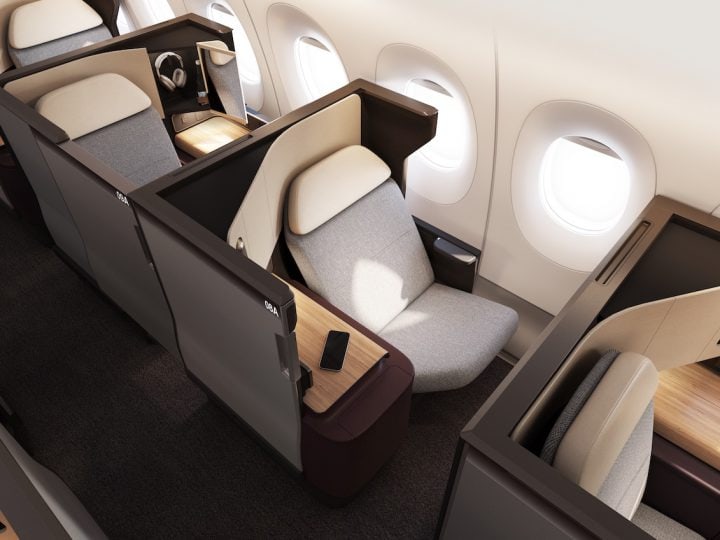
Tom Goward | 24/03/2024
Business Owner? Here’s How To Book Business Seats At Economy Prices

Immanuel Debeer | 13/03/2024
Buy Velocity Points With 30% Discount
- Join CHOICE
Travel money cards with the lowest fees
We look at seven travel money cards from the big banks and airlines..
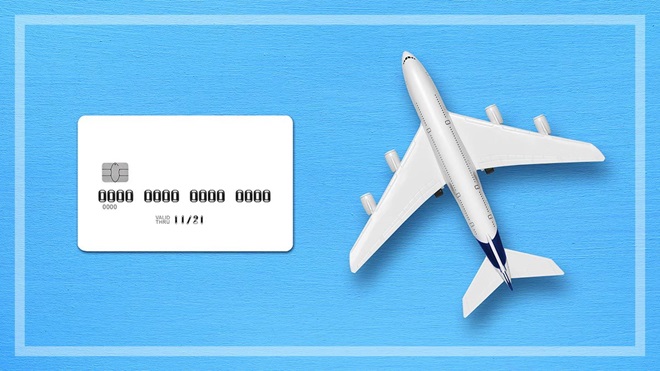
Prepaid travel money cards are offered by major banks, airlines and foreign exchange retailers like Travelex. Before travelling overseas, you load money into the card account, which locks in the exchange rate for foreign currencies at that time.
You can then use the card for purchases and cash withdrawals just like a debit or credit card, usually wherever Visa and Mastercard are accepted.
You can reload money on-the-go via an app or website, and if the card is lost or stolen, it can be replaced (usually at no cost to you).
Prepaid travel money cards also give you assurance that you're not handing the details of your everyday banking account to merchants you're not familiar with, and they provide easy access to cash when you want some, says Peter Marshall, head of research at money comparison website Mozo .
CHOICE tip: Travel money cards are best for longer trips. They're usually not worth your while if you're only taking a short trip, as some have closure, cash out and inactivity fees.
Travel money card fees
A major difference between prepaid travel cards and debit or credit cards is their fees. Some costs aren't immediately apparent, such as hefty margins built into the exchange rates.
And although fees have come down since we looked at these cards two years ago, you still need to watch out for:
- fees to load the card – either a percentage of the total or a flat fee
- ATM withdrawal fees
- a cross currency fee or margin when you use the card in a currency you haven't preloaded
- further fees if you close the account or haven't used the card for a period of time.
Travel money card with the lowest fees and best exchange rate
Westpac worldwide wallet.
Westpac closed its Global Currency Card in July 2021 and offers its new card in partnership with Mastercard. It's also available from Bank of Melbourne and BankSA.
Currencies: AUD, USD, NZD, EUR, GBP, SGD, THB, JPY, HKD, CAD, ZAR.
Key features:
- No loading, reloading, closing or inactivity fees.
- Free to use it in network ATMs in Australia and partner ATMs overseas in a range of countries including the UK, US and New Zealand.
- A charge applies at non-Westpac and non-partner ATMs in Australia and overseas.
- Best exchange rates for the US dollar, the Euro and GBP in our comparison.*
- The only card that lets you preload the South African rand.
Other travel money cards
Next to the Westpac Worldwide Wallet, there are six other travel money cards available.
Australia Post Travel Platinum Mastercard
Available online or at post offices.
Currencies : AUD, USD, NZD, EUR, GBP, SGD, THB, JPY, HKD, CAD, AED.
- Fee to reload the card via BPay, debit card or instore, but free via online bank transfer.
- Closure fee.
- Fees for ATM withdrawals in Australia and overseas.
Cash Passport Platinum Mastercard
It's issued by Heritage Bank and is available online and from a number of smaller banks and credit unions (like Bendigo Bank and Bank of Queensland) as well as travel agents.
- Fee to reload with a debit card or instore, but free via BPay.
CommBank Travel Money Card
CommBank Travel Money Card (Visa)
As NAB and ANZ have closed their travel money cards, this is the only other travel money card available from a major bank. This card has the largest variety of currencies that can be preloaded.
Currencies : AUD, USD, NZD, EUR, GBP, SGD, THB, JPY, HKD, CAD, AED, VND, CNY.
- Fee if you make a purchase with currencies not preloaded.
- Fee for withdrawals at overseas ATMs.
Qantas Travel Money Card
Qantas Travel Money Card (Mastercard)
The only travel money card offering from an airline. It can be added as a feature to your Qantas Frequent Flyer card, so you don't need a dedicated card, and you can earn points using it.
- Free to reload via bank transfer or BPay, but there's a reload fee if using debit card.
Travelex Money Card
Travelex Money Card (Mastercard)
Travelex is an international foreign exchange retailer. In Australia, it operates more than 140 stores at major airports and shopping centres, across CBDs and in the suburbs. It was the card with the best exchange rate for New Zealand dollars.*
Currencies : AUD, USD, NZD, EUR, GBP, SGD, THB, JPY, HKD, CAD.
Fees :
- Load fee instore, but free via Travelex website or app.
- Reload fee instore or via BPay, but free via Travelex website or app.
- Closure fee and monthly inactivity fee (if not used for 12 months).
Travel Money Oz Currency Pass
Travel Money Oz Currency Pass (Mastercard)
The Travel Money Group is owned by Flight Centre and is a foreign exchange retailer.
- Reloading the card via an online bank transfer or instore is free, but there's a fee if you reload via BPay, debit card or credit card.
- Cash out (closure) fee.
Travel money card tips
- Make sure the card allows the currencies you'll need, and also consider stopovers. For example, the South African rand is only supported by the Westpac card.
- Try to load your card with the right currencies and amounts on days with good exchange rates.
- Make sure you know how to reload your card if you run out of funds while overseas.
- It may be more convenient to choose a card that has an app that can be linked to your bank account.
- Avoid loading more money than you'll need as there may be fees and exchange rate margins to get the unused money back.
- Remember to cancel the card once you're finished your trip, especially if it has inactivity fees.
- Be mindful that you still may need a credit card, as travel money cards may not be accepted as security for hotels and car rental agencies.
Stock images: Getty, unless otherwise stated.
Join the conversation
To share your thoughts or ask a question, visit the CHOICE Community forum.

- Travel Money Card
Get our best rate on the award winning Travelex Money Card
Buy currency, top up card.
Rate last updated Tuesday, 09 April 2024 12:07:43 PM AEST. Please note that these are the Travelex online sell rates.
[fromExchangeAmount] [fromCurrencyCode] Australian Dollar
[toExchangeAmount] [toCurrencyCode] [toCurrencyName]
Enter the card number of the Prepaid Card you would like to top up. The number of the Prepaid Card you are topping up must be the Primary Card Number and must have been originally purchased from Travelex.
Card number confirmed
Select the currency you would like to top up to your card
Enter how much you'd like to top up, either in Australian Dollars, or in the foreign currency amount for the currency you have selected.
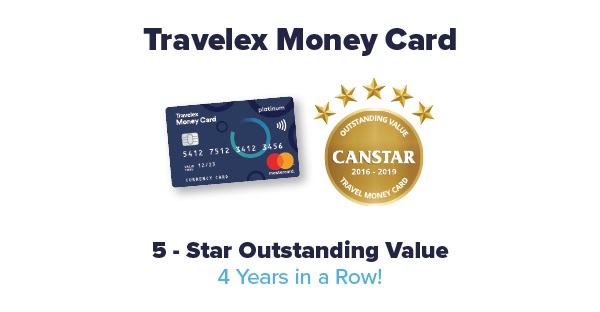
This section is optional on mobile
E!am commodo accumsan scelerisque. Quisque posuere laoreet lectus a elementum. Mauris euismod, lectus sed gravida dictum, magna orci iaculis ligula, quis blandit lorem enim at magna.
The Travelex Money Card
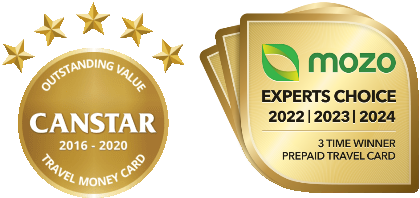
Travel Card Exchange Rates & Currencies
Choose your currency, $0 currency conversion fee when spending a currency not on your travel card:.
The below calculator is a handy tool to help you estimate the applicable exchange rate for your transaction 2 :
Spend Calculator
You can use this calculator to see what your spend would look like for your trip. It will help you estimate the applicable exchange rate for your transaction.
- Netherlands
- Vatican City
- Czech Republic
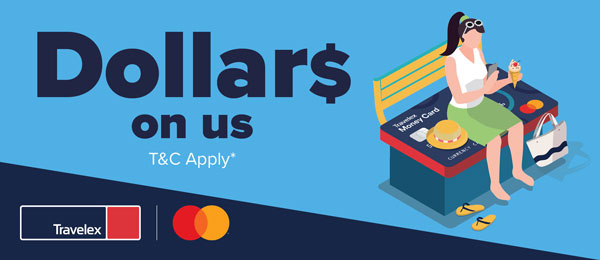
Get Dollars on Us!
Load more, save more with the travelex money card.
- Save up to AUD $240! View all available discounts codes here .
- Available online, in-store, or via the Travelex Money App. Ends 28 April at 11.59pm AEST. T&C Apply.
Save with the Travelex Money Card
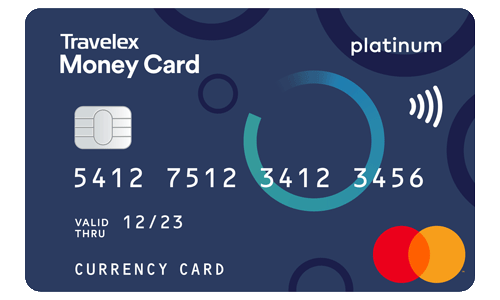
$0 Eftpos Fees
$0 atm fees 1, $0 currency conversion fees ^, $0 online shopping fees*, $0 free delivery to your home, special offer, load aud on your travelex money card and save when spending in the below currencies.
- Free Online AUD Load and Top-Ups
- $0 International ATM Fees
Features and Benefits
UNLIMITED FREE overseas ATM withdrawals 1
Highly competitive exchange rates
NO fees when you buy online $0 Currency conversion fee ^
24/7 Global Assistance
Convenient Mobile App Download it here
Shop at millions of outlets wherever Mastercard is accepted and on international websites with the local currency
Buy online, collect in-store or get it delivered to your home (allow up to 7 days from when payment is received)
5 ☆ outstanding value award winning travel money card
Exclusive offers with Mastercard Priceless TM Cities
No account or membership required
How our Travel Card Works
Order your travel card.
Order your Travelex Money Card online or in-store (passport or driver's license required)
Get your travel card
Collect from a Travelex store or delivered FREE to your home (allow up to 7 days from when payment is received)
Download the App
Download the app from the Google Play and Apple App stores
Register for My Account
Simply activate your card by registering your account via the app or online
Manage and check your balance online and on your mobile
Exchange leftover currency
After your trip, exchange leftover money for another currency, transfer into your bank account or withdraw in-store or at an ATM.
Fees and Limits
NO fees online $0 Currency conversion fee ^
Withdraw daily up to AU$3,000 (or currency equivalent)
Maximum Card limit of AU$50,000
Free initial and replacement card
The following fees and limits apply. Fees and limits are subject to variation in accordance with the Terms and Conditions. Unless otherwise specified, all fees will be debited in AU$ Currency
If there are insufficient funds in AU$ Currency to pay such fees, then we will automatically deduct funds from other Currencies in the following order of priority: AU$, US$, EU€, GB£, NZ$, THB, CA$, HK$, JP¥, SG$.
• Online: FREE via travelex.com.au or the Travelex Money App • In-Store: FREE for loads of foreign currency (loads of Australian dollars (AUD) incur a fee of 1.1% of the amount or $15 whichever is greater).
• Online: FREE via travelex.com.au or the Travelex Money App • In-Store: FREE for top-ups of foreign currency (top-ups of AUD incur a fee of 1.1% of the amount or $15 whichever is greater). • BPAY: Top-ups not made via travelex.com.au or the Travelex Money App incur a fee of 1% of the amount. - MasterCard Biller Code: 184416 - Reference No: your 16 digit Travelex Money Card number - Funds will be allocated to your default currency. To check your default currency login to your account.
FREE (note: Some ATM operators may charge their own fees or set their own limits)
- Charged at the start of each month if you have not made any transactions on the card in the previous 12 months
- Unless your card is used again, or reloaded, this fee applies each month until the card is closed or the remaining card balance is less than the inactivity fee.
AU$4.00 per month
- Charged when you close your card or withdraw from your Card Fund. This fee is set and charged by Mastercard Prepaid.
- This is applied when you move your funds from one currency to another currency.
At the then applicable retail foreign exchange rate determined by us. We will notify you of the rate that will apply at the time you allocate your funds from one currency to another.
- Applied when a purchase or ATM withdrawal is conducted in a currency either not loaded or sufficient to complete the transaction and the cost is allocated against the currency/ies used to fund the transaction.
FREE* *The Spend Rate will apply to foreign exchange transactions in accordance with the Terms and Conditions.
AU$350 or currency equivalent AU$100 or currency equivalent
AU$50 or currency equivalent
The maximum amount you can load on the card at the time of the initial online purchase is AU$5,000 equivalent.
to a maximum of $10,050 per single top-up; and to a maximum of $10,050 top-up value over 24hrs; and to a maximum of $20,000 top-up value over 21 days.
AU$3,000 or currency equivalent
AU$15,000 or currency equivalent
Other Important Information
Please read the following information about your Travelex Money Card carefully:
- Your Travelex Money Card does not generate any interest or any other similar return. You do not earn interest on the amount standing to the credit of the Travelex Money Card Fund accessed by the card.
- Although the issuer of the card is an authorised deposit-taking institution in Australia, the Card is not a deposit account with the Issuer.
Important Information about Fees & Limits for loads/top ups made online:
- If you are making a purchase or topping up the Card online via www.travelex.com.au (i) the initial load and top up fee may differ to (but not be greater than) those contained in the “Fees and Limits Table” of this Product Disclosure Statement; and (ii) the limits may differ to those contained in the “Fees and Limits Table” of this Product Disclosure Statement. Travelex may also charge a card surcharge if you pay with a credit or debit card. Please refer to the relevant online terms and conditions available at www.travelex.com.au for details of the applicable fees and limits.
- AU$ cannot be loaded or topped up onto a card online via www.travelex.com.au
Terms & Conditions
Download the travelex travel money app.
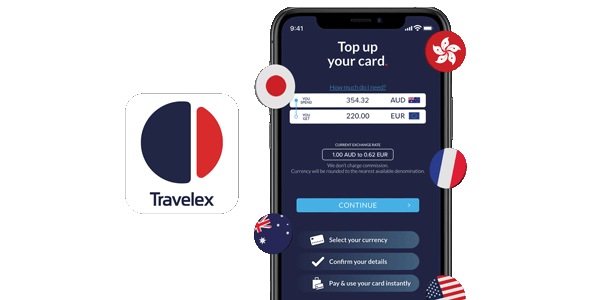
Convenience on the go
- Top up your Travelex Money Card
- Check your balance
- Quick touch log in
The app requires Android 5.0 and up or iOS 10.0 or later. Compatible with iPhone, iPad and iPod touch.

Other Ways to Get Foreign Currency
All the easy options to access foreign currencies with travelex.

About Travelex Money Card online and in-store

- Travel Insurance
Discover more of the world with travel insurance by your side

All you need to know getting foreign cash with Travelex

Get foreign cash from an ATM in Australia

About Your Destination
Browse our Destination Guides
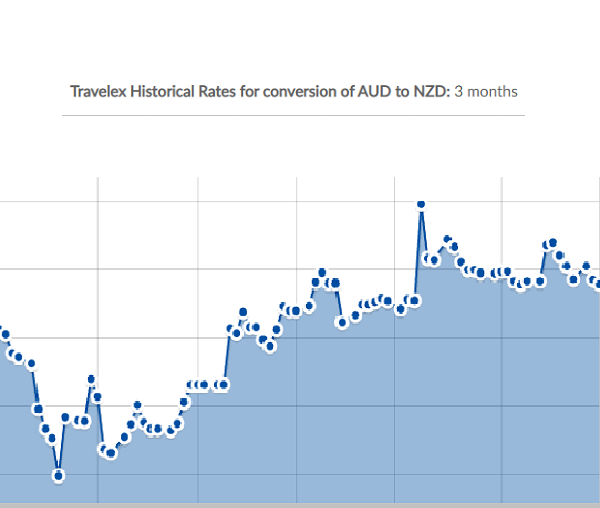
Historical Rates
Check out current and historical AUD to FX Travelex rates
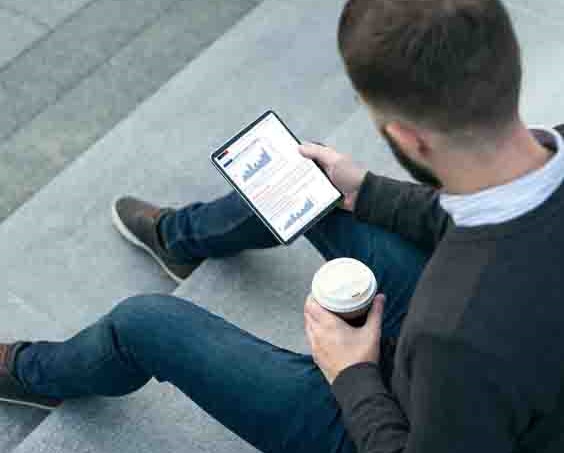
Track Currency Rates
Receive an alert when your selected foreign currency has reached your desired rate
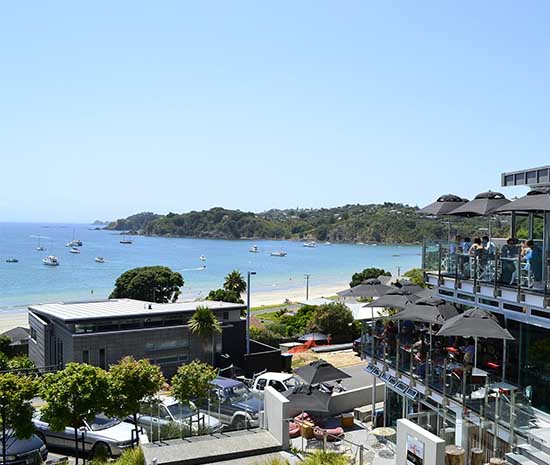
- Find a Store
Purchase cash, a Travelex Money Card or transfer money in-store
Travelex Travel Card Currency Information
Travel card faq links.
Getting Started
Using the Card
Topping up the Card
Travelex Money Card FAQ
You can only hold one card in your name at any one time.
Top-up via the Travelex website
Note that you must use your unique reference number when paying or the transfer may be delayed.
Top-up via the Travelex Money App
Move currencies on your card, instantly.
If you have AUD (or any other currency) already loaded on the card, you can move your funds to another currency within the Travelex Money App. Instant top-up!
Top-up in a Travelex store
Direct top-up via bpay:.
Top-ups not made via travelex.com.au or the Travelex Money App incur a fee of 1% of the amount. You must make payment using your own account.
MasterCard Biller Code: 184416 Reference No: your 16 digit Travelex Money Card number
Funds will be allocated to your default currency. To check your default currency login to your account. Top ups will generally take two business days to be processed however may take longer if the payment is not made before 2pm on a business day Australian Eastern Standard Time.
Yes, travel money cards come with a host of advantages that can save you money when travelling. These include the ability to load multiple currencies at a fixed and competitive exchange rate, and the capability to make purchases in-store, online, and at ATMs worldwide with no overseas ATM or withdrawal fees.
- Locking in fixed foreign currency exchange rates and avoiding foreign transaction fees before you travel
- The ability to load multiple currencies onto one card, similar to a travel debit card
- The ability to spend money conveniently and comfortably overseas
- No overseas ATM withdrawal fees
- No fees when making online purchases
- Travel money cards can be ordered online and collected in store next day (when paying by debit/credit card).
- Just walk in store. Cards purchased and loaded in-store are active and ready-to-use on the spot. We will automatically transfer funds between currencies complete your card transactions.
- Home delivery within 5-7 business days (from when payment is received).
Most common questions
The best travel money card for Australians is the one that caters to the currencies available at your destination, removes ATM withdrawal and foreign purchase fees, and has the best exchange rate. The Travelex Money Card is a prepaid travel card and has been awarded the best prepaid travel card by Mozo two years in a row.
A travel money card is a global currency card that allows you to load several foreign currencies into a personal account at a prevailing exchange rate . Like debit and credit cards, a travel money card can be used to make purchases in stores, online, and to withdraw cash at ATMs while travelling. You can buy currencies and add or reload them into your travel money card account via a mobile app whilst abroad.
One of the best ways to use the Travelex Money Card is with the Travelex Money App. The Travelex Money App makes ordering, transferring, and checking currencies quick and simple on your travel card. You can also use the Travelex travel exchange rate tracker to check currencies in real time.
You can order a travel money card online or purchase one directly from a Travelex store. Find a store near you.
- Travel money cards can be ordered online and collected in store next day.
- Home delivery within 5-7 business days.
The Travelex Money Card is a Mastercard travel card, meaning it is free to make international withdrawals at ATMs displaying the Mastercard acceptance mark. It is also free to obtain cash over the counter and to make online purchases with a travel money card. However, some ATM operators may charge their own withdrawal ATM fees. Be sure to check with the ATM in question prior to making cash withdrawals.
Similar to any bank account, you can withdraw money from your travel money card at ATMs worldwide. When withdrawing cash, select the “credit” option on the ATM machine screen to access funds. You will not be charged credit card fees by selecting this option. If the “credit” option does not work, try selecting “debit” or “savings”. The maximum withdrawal amount is 3,000 Australian dollars each 24 hour period. Bear in mind that some ATMs may also have their own ATM fee, adding a cost to your withdrawal.
The Travelex Money Card is a multi currency card that can be used in most countries around the world. Widely considered the best travel money card for overseas travel, the Travelex Money Card can be used in the US, Europe, Japan, Canada, Hong Kong, Singapore, Japan, New Zealand, and many more countries.
The initial card fee is free, subject to minimum load amounts. Please see the fees and limits section for more information. There are fees associated with the way you use your card e.g. the type of transaction, the currency you use, and when you move currencies on your card. Limits also apply to top up amounts and method of top up. Please see more information on applicable fees and limits section.
Activity on your Travelex Money Card is monitored every day to detect unusual behaviour, and if something is spotted you'll be contacted to check your transactions. There are also things you can do to help keep your travel money secure: • Sign your card as soon as you receive it • Check your transactions regularly and report anything unusual to Card Services immediately • If you print statements from the internet, keep them safe and shred them when you've finished using them • Never give your personal details to someone on the phone • Don't give out your details in response to unsolicited email • Be wary of anyone who asks for common security details like your mother's maiden name, passwords, date of birth, or information about your work • Never give your PIN to anyone, even if they claim to be from your card issuer • Don't let yourself get distracted when using cash machines or point of sale terminals - somebody may be trying to find out your PIN
Mastercard Prepaid Management Services Australia Pty Ltd (ABN 47 145 452 044, AFSL 386 837) arranges for the issue of the Travelex Money Card in conjunction with the issuer, EML Payment Solutions Limited (‘EML’)(ABN 30 131 436 532, AFSL 404131). You should consider the Product Disclosure Statement for the relevant Travelex Money Card and Target Market Determination available at www.travelex.com.au , before deciding to acquire the product. Any advice does not take into account your personal needs, financial circumstances or objectives and you should consider if it is appropriate for you. Mastercard and the circles design are registered trademarks of Mastercard International Incorporated.
* Transacting via some online merchants may incur a surcharge.
- Join our Mailing List
- Price Promise
- About Travelex
- Best Ways to Buy Foreign Currency
- Travelex Money App
- Currencies Available to Buy
- Currency Converter
- Rate Tracker
- Sell Your Currency
- Travelex Travel Hub
- Australia Post
- Become an Affiliate
- Other Services
- International SIM Cards
Travelex Info
- Business Services
- Product Disclosure Documents and Terms & Conditions
- Website Terms of Use
- Privacy Policy
- Fraud & Scams
Join the conversation
Customer support.
Online Order Queries:
- Tel.: 1800 440 039
- Email: [email protected]
- Map: Suite 45.01, Level 45, 25 Martin Place, Sydney NSW 2000

Disclosure: Privacy Australia is community-supported. We may earn a commission when you buy a VPN through one of our links. Learn more.
Best Travel Card for Australians
By Will Ellis
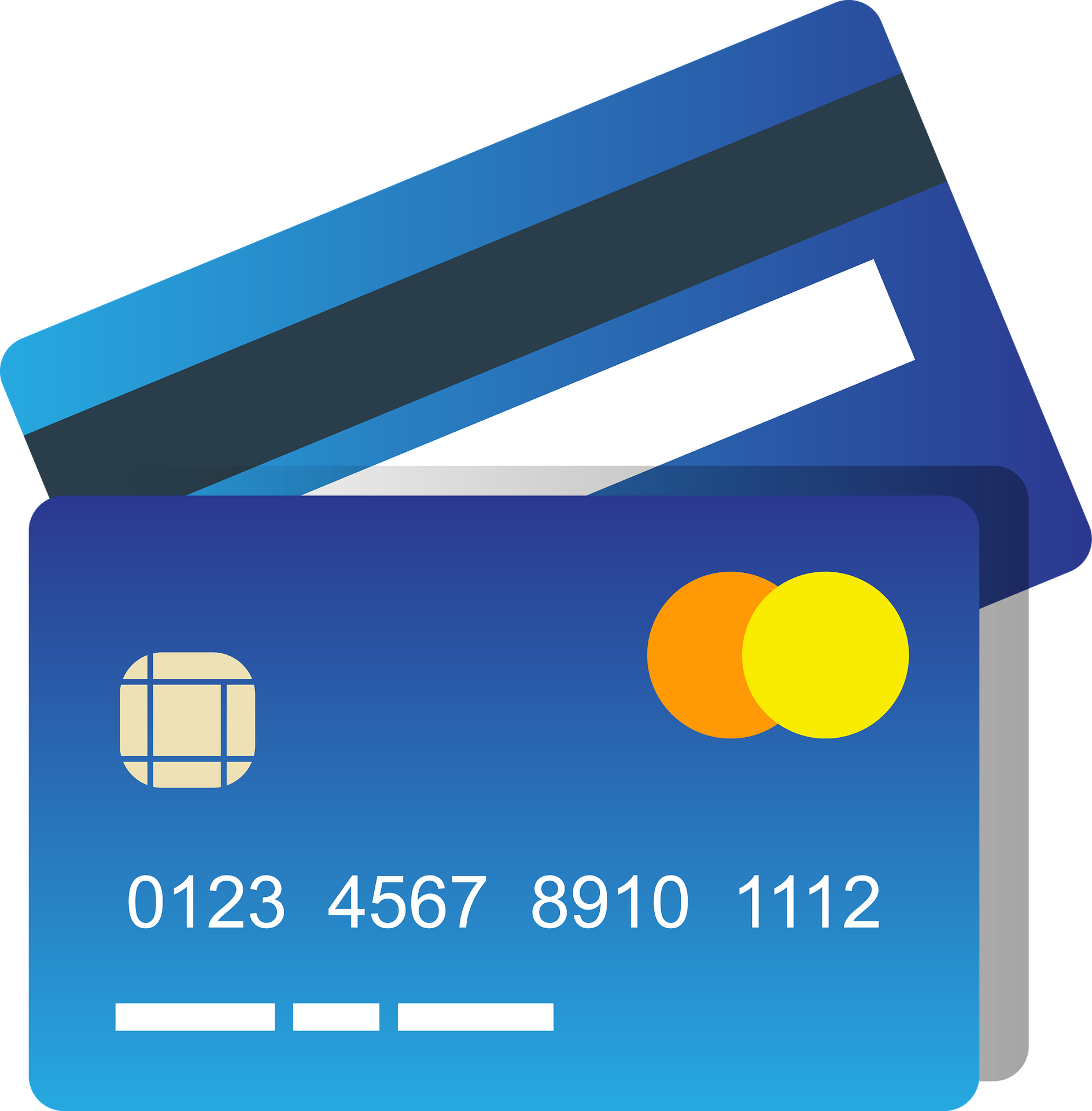
When you spend money abroad, the fees can quickly make the trip more expensive, especially when using your regular debit card and bank account. T
here are usually foreign currency fees and additional fees when you withdraw money and the exchange rates, too. Using a travel card can reduce the cost of fees when you use one for spending money outside of Australia.
There are three types of travel cards: prepaid travel money cards, travel reward credit cards, and travel debit cards. In this article, you’ll learn all about travel cards, and we’ll introduce you to the best ones on the market.
Table of Contents:
- What Is a Travel Card
- Travel Cards: Pros and Cons
- 1. Travelex Money Card
- 2. Australia Post Travel Platinum Mastercard
- 3. Qantas Money Travel Money Card
- 4. Wise Travel Money Card
- 5. Revolut Travel Money Card
- 6. HSBC Everyday Global Account Debit Card
- 7. Bankwest Breeze Platinum Credit Card
- 8. ING Orange One Low Rate Credit Card
- 9. 28 Degrees Platinum Mastercard
- The Verdict
What Is a Travel Card? 💳️
A travel card is a card that is specifically to be used when someone is planning to travel outside of their home country. Travel cards allow you to spend money abroad with lower fees than expected with your everyday bank account . Most travel card providers will tell you about the currency conversion fee, interest rates and other fees before you make a transaction so you know exactly how you could spend abroad on fees.
You can use different types of travel cards; each will depend on your spending needs and financial situation. Before diving into the best travel cards on the market, we’ve provided a list of all three types of travel cards.
There are three types of travel cards:
- Prepaid travel card: A prepaid travel card is a card you load money onto. You can use a prepaid card wherever Mastercard is accepted. You can use it like your everyday debit card, but it helps you shop safely and stick to a budget, as you can’t spend more than the balance allows. You can load more than one foreign currency onto the card, so it’s perfect for travelling overseas. You simply need to bank transfer money across to the prepaid debit card.
- Travel debit card: A travel debit card is part of a travel bank account, usually known as a multi-currency account; you can use it just like your everyday bank account, but it’s for travelling. If planning a long trip, you may benefit from opening a travel bank account.
- Travel credit card: Travel credit cards are similar to credit cards you can apply from your main bank provider. However, they usually offer better currency conversion fees and reward you with travel points or perks for using the credit card and repaying the balance on time. Travel credit cards typically require a good or excellent credit score.
Travel Cards: Pros and Cons ➡️
You may be unsure if a travel card is the right option, so we’ve compiled a list of all the pros and cons of using one for travelling overseas.
- Cheaper foreign transaction fees: Travel cards typically have lower foreign currency conversion fees. Plus, you won’t be charged as much as you were if you used your everyday bank account.
- Easy access: You can apply for and access your travel money card online. Most prepaid cards allow you to reload money onto the card via an app on your phone.
- Hold multiple currencies: When you have a travel debit card, you will get a multi-current account, which allows you to hold multiple currencies on one account. You can use this bank account for spending abroad; currency conversion fees are usually the lowest with these types of accounts. Prepaid travel cards also allow you to hold and use multiple currencies on one card.
- Earn reward points: When you use a travel credit card, you can earn reward points when you use the credit card for spending. You can use the points for travel perks, discounts, cheaper flights, and lounge access.
- Helps to budget: With a prepaid card, you can only use the balance as there is no credit option. So, if you’re trying to stay on a budget, it’s easier when there is no temptation of an overdraft or credit balance.
- Locked-in exchange rates: Most prepaid cards have a locked-in exchange rate, so you don’t have to worry about fluctuation of exchange rates when transferring money into a different currency. Some companies may use a live exchange rate; always check with the provider about fees before you use your card abroad.
- Use just like a debit card: A prepaid debit card allows you to spend and pay for things like your regular debit card. If you choose a prepaid debit card, it will be attached to a bank account that works like your everyday account.
- Backup card: Most prepaid card providers will send you a backup card if you lose or damage the first one. They will send you two cards together, so keep one separate from the other for safekeeping so you don’t lose them both together.
- Currency conversion: When you use a travel card overseas, especially a travel debit card, the provider will automatically transfer funds into the currency you’re paying with.
- Potential reload delay: Sometimes, there can be a delay in reloading prepaid cards. To prevent potential delays, try to transfer all the money you need before you travel so you don’t have to worry about it whilst you’re away.
- Travel money card fees: A travel money card has its own fees, such as account fees, reload fees, and inactivity fees. Some travel credit cards have monthly fees.
- ATM fees: Depending on the country you visit, there may be overseas ATM withdrawal fees and which ATM operators are used. Some ATMs charge fees when you withdraw cash, so you should look out for that.
Best Travel Cards: Reviews 🔎️
As there are three types of travel credit cards, we’ve provided a list of the top three of each type so you can pick which card suits your needs the best.
1. Travelex Money Card: Award-Winning Prepaid Travel Card
- Exchange rates: Locked-in exchange rates that vary between foreign currencies
- Currency conversion fees: None
- Loading money fee: Free online AUD load and top-ups
- ATM fees: There are no ATM fees outside of Australia

With the Travelex Money Card, you can load up to 15 currencies onto the card, including AUD, GBP, EUR, UDS, NZD, CAV, TJB, SGB, JPY and HKD. There are no fees for cash withdrawals overseas. However, you may be charged for withdrawals in Australia using this card. The prepaid card is accepted at millions of locations worldwide; look out for the Mastercard logo, and you can use your prepaid card at that location.
There is currently an offer online that offers free online AUS load funds and top-ups. If you apply for a prepaid card in-store, there will be a 1.1% fee of 1% of the transaction amount for adding AUD. However, if you load a foreign currency, the top-ups are free. If your prepaid card is inactive for over 12 months, there will be AU$4 monthly inactivity fees.
The minimum top-up amount is AU$50, and the maximum you can load on initial purchase is AU$5,000 so if you want to add a large sum of money to the card, you will have to do it once you’ve applied for the card and already have funds on it. The maximum balance during any 12 months is AU$75,000.
Benefits of this prepaid card include free Wi-Fi worldwide; you can reduce your data usage without worrying about roaming fees with on-the-go internet access using free Boingo Wi-Fi. If your card is lost or stolen, Travelex offers 24/7 global assistance to help replace the card or provide emergency cash so you’re not stuck without money when travelling. You can also add an optional additional emergency card at checkout.
2. Australia Post Travel Platinum Mastercard: A Low Fee Prepaid Travel Card
- Exchange rates: The exchange rate will vary between each foreign currency
- International transaction fees: None
- Loading money fee: Free for bank transfer, but there is a 1.1% for instore and 1% for BPAY
- ATM fees: $3.50 for international cash withdrawals and 2.95% for domestic cash withdrawals

The Australia Post Travel Platinum Mastercard is a prepaid card that allows you to load with 11 different foreign currencies and easily switch between currencies as you travel. There are fixed exchange rates, but they may vary depending on the currency you’re converting. You can manage and load your prepaid card on the go by accessing your ‘My account’ on the website or using the Australia Post Travel Platinum Mastercard app.
There is no direct link to your bank account, and your prepaid card is Mastercard’s Zero liability protection against fraudulent and unauthorised transactions; you can travel and spend safely without worrying about compromised data or funds.
Benefits include three months of access to millions of Wi-Fi hotspots worldwide when you reload $100 onto your card. You can reload money onto your prepaid card at any Australia Post Branch or online in the app.
3. Qantas Money Travel Money Card: Earn Reward Points With a Prepaid Travel Money Card
- Exchange rates: Locked in
- Currency Conversion fees: 0%
- Loading money fee: Fee-free load options; otherwise, a 0.5% debit card instant load fee
- ATM fees: $1.95

To make the most of a prepaid card, you can earn Qantas points with the Qantas Travel Money Card. You can load up to 10 foreign currencies, lock in exchange rates before you travel, and transfer between currencies.
Using the prepaid card, you earn 1.5 Qantas Points for every AU$1 spent in a foreign currency. You’ll earn 1 Qantas Points for every AU$4 spent in Australian dollars. You can earn double points when you spend with Qantas Frequent Flyer program partners using Qantas Travel Money. If you load over AU$1,500 equivalent of foreign currency by 20 November, you can earn up to 10,000 bonus points. For shopping discounts, you can use your Qantas Points for cheaper travel at select airlines or popular retailers.
If you lose your card or it’s stolen, you can temporarily lock it and access emergency funds while travelling. You’ll also have access to the 24/7 Mastercard Global Support team, who can help you if you have any issues or are seeking help while travelling. You will also receive fraud protection against unauthorised transactions.
4. Wise Travel Money Card: Travel Debit Card and Multi-Currency Account
- Exchange rates: Competitive exchange rate
- Currency conversion fees: From 0.43%, fees vary by currency
- Loading money fee: $2
- ATM fees: 2 free ATM withdrawals per month up to AU$350

With the Wise card and multi-currency account, you can spend and withdraw money in over 40 currencies at a live exchange rate. You can transfer money between banks, use the wise debit card overseas, receive and add money to your account and hold different currencies in one account. It’s free to register for a Wise account.
The wise card works just like your regular debit card, but it’s designed to help make spending money abroad cheaper. The card costs $10, but you also get a free digital card that you can use on your smartphone to spend online, in-store and overseas safely with Apple Pay and Google Pay.
So, while waiting for your debit card to be delivered, you can start spending using your virtual card. There are no markups, monthly or hidden fees; you can spend overseas with the real exchange rate. You’ll know how much each transaction will cost upfront.
The application process is simple; you can create an account and order a card within five minutes. So, if you’re travelling soon, you still have time to order a wise travel debit card. With the account and card, you can manage your finances from the Wise app. On the app, you can freeze and unfreeze your card whenever you want, generate digital cards and get notifications for all your transitions to keep in control of your spending.
5. Revolut Travel Money Card: Low Fee Travel Debit Card
- Exchange rates: Competitive rates
- Loading money fee: No loading fee
- ATM fees: Fee-free for withdrawals up to $350 every 30 days

There are over 30 currencies available with the Revolut Travel Money Card, that you can spend in over 150 currencies. You can spend overseas with one of the best exchange rates globally. With this travel debit card, there are no fees. You simply pay the exchange rate and for any additional cash withdrawals above the free amount with the standard free plan. You can transfer money across borders at low rates, and the transactions are quick to complete no matter where in the world you are.
You can choose the colour of your Revolut travel debit card and even personalise it. With a Revolut account and card, you can create one-use virtual cards to help make shopping online more secure. Additionally, if you want to control your spending whilst travelling, you can set up spending limits and freeze your card immediately if you lose it.
Revolut offers paid plans, but they’re optional. If you want to invest in cryptocurrency and save more globally, you can apply for the Premium account for $9.99 monthly. Additionally, if you want all available benefits, plus earning cashback and getting a metal card, you can pay A$24.99 monthly for the Metal plan. Whatever your budget, you can still benefit from the Revolut debit travel card.
6. HSBC Everyday Global Account Debit Card: Banking for Home and Overseas
- Exchange rates: Competitive real-time exchange rates
- Loading money fee: None
- ATM fees: None for ATMs with a VISA or VISA plus logo

If you’re looking for a bank account that you can use at home and on your travels, the HSBC Everyday Global Account allows you to do fee-free everyday banking across 10 currencies. You don’t need to pay a monthly HSBC ATM or transaction fees. You can switch between 10 currencies seamlessly with the HSBC Mobile Banking App; available currencies are EUR, GBP, AUD, USD HKD, CAD, JPY, NZD, SGD, and CNY (with some restrictions with CNY).
If you’re sending money overseas, there are no HSBC fees for you to worry about. You don’t have to worry about ATM fees either. When you’re in Australia, you can get free cash withdrawals from HSBC ATMs, and when you’re overseas, you have to look out for ATMs with the VISA logo.
You can earn up to 2% cashback for contactless payments under $100, so you can earn money just by using your travel debit card to make purchases when you’re home in Australia. You can use your card with Visa payWave, Apple Pay, and Google Pay.
7. Bankwest Breeze Platinum Credit Card: Complimentary Travel Insurance
- Annual fees: No annual fee for the first year, then $69 yearly
- Interest rates: 12.99% after the introductory period
- Foreign transaction fees: None
- Minimum credit limit: $6,000

If you’re looking for a travel credit card with low-interest rates, consider Bankwest’s Breeze Platinum credit card. You can spend interest-free for the first 55 interest-free days on purchases if the balance is repaid in full and on time, then you’ll only have to pay 12.99%. When using your credit card overseas, there are no foreign transaction fees, so you can spend knowing there won’t be additional fees to pay. You can use the credit card anywhere that accepts Mastercard.
There is no annual fee for the first year; after the first year, there is a $69 annual fee. A perk of the Breeze Platinum card is complimentary overseas travel insurance, interstate flight inconvenience insurance and 90-day purchase security insurance. Additionally, new customers will benefit from a 2% balance transfer fee.
To be eligible for this credit card, you must be a permanent Australian resident over 18 with a regular income of over $15,000.
8. ING Orange One Low Rate Credit Card: No Annual Fee Travel Credit Card
- Annual fees: No annual fee
- Interest rates: 11.99% variable
- Foreign transaction fees: No international transaction fees
- Minimum credit limit: $1,000

The ING Orange One Low Rate credit cards are ideal if you’re concerned about additional fees when spending overseas. There are two Low Rate cards, classic and platinum, to choose from. Both cards have no annual costs, and there are no international transaction fees either.
To benefit from no international transaction fees, you need to make a $1,000 monthly deposit to any of your ING accounts (Super and Orange One accounts not included) and make more than five credit card purchases that are settled each month.
The most significant difference with the cards is credit limits. With the Low Rate Classic, the credit limit ranges from $1,000 to $5,999. The Low Rate Platinum has a credit limit range of $6,000 to $30,000. The interest rate is 11.99%, but if you use instalment plans to pay off your purchases, you can lock in a lower interest rate plus manage your repayments to ensure they’re on time.
To be eligible for this credit card, you will need to be aged 18+, be an Australian citizen, New Zealand or Australian permanent resident, earn $36,000 or more a year, have a good credit rating and have an active Orange Everyday account (or you can open one alongside your credit card application).
9. 28 Degrees Platinum Mastercard: Low Fee Travel Credit Card
- Interest rates: 26.99% after the introductory period

The 28 Degrees Platinum Mastercard has low fees, with no annual fee, no overseas purchase fee, currency conversion fee or foreign transaction fee. So, you can use your card without worrying about payments racking up. With this travel credit card, you get 55 days interest-free on purchases and access to free 24/7 concierge service.
Perks of this credit card include a complimentary Flight Delay Pass and Global Data Roaming. Additionally, you can get a discount on upcoming trips with 10% discounts on selected hotels at Wotif and Expedia when you have your 28 Degree card before 30 September 2024 and when you stay before 31 December 2024. If you lose your card whilst on holiday, 28 Degrees offers worldwide emergency card replacement.
To be eligible for this credit card, you must be 18 years old and over and be a permanent Australian resident.
Leading Travel Cards for Australians: The Verdict 💡️
Using a travel card for your spending abroad can help you stick to a budget, avoiding credit options to reduce debts, and you can use one just like your debit card so you can seamlessly spend whilst on your adventure overseas. You don’t need to meet any specific requirements to get a travel prepaid card, so that you can get one with little to no fuss.
Frequently Asked Questions 📢️
What is the difference between a prepaid travel card and a travel debit card.
A prepaid travel card is a card you load money onto. You can use a prepaid card wherever Mastercard is accepted. You can load more than one foreign currency onto the card and transfer money to the prepaid card. A travel debit card is part of a travel bank account, usually a multi-currency account; you can use it just like your everyday bank account, but it’s for travelling.
What Are the Benefits of Travel Money Cards?
There are many benefits to travel cards, the main benefits include:
- Lower foreign currency conversion fees, as you won’t be charged as much as you were if you used your everyday bank account.
- Most travel cards will allow you to hold multiple currencies, so if you’re travelling to a few different countries with different currencies, you can hold more than one at a time.
- Most prepaid travel cards have a locked-in exchange rate, so you don’t have to worry about fluctuating exchange rates when transferring money into a different currency.
What Fees Are There for Using a Travel Money Card?
The fees involved for a travel money card will depend on the type of travel card you have. In general, a travel money card will have costs for annual or monthly fees, exchange rates, currency conversion fees, interest rates, and international transaction fees. How high the fees are will vary from card type and provider.
You Might Also Like:
- Best 0% Purchase Credit Cards
- How to Avoid Credit Card Fraud in Australia
- Best Virtual Credit Cards in Australia (2024)

#1 Commission-Free Stock Trading Platform
- 0% Commission Charges
- 24/7 Customer Support
- No Virtual Private Server
- Non-Trading Fees
VISIT ETORO
eToro Review
eToro Service ARSN 637 489 466 Capital at risk. See PDS and TMD
Related posts

Starting in December 2020, ResistSurveillance.org will join forces with PrivacyAustralia.net. The teams responsible for the creation of these two websites will […]

- Skip to navigation
- Skip to main content
Popular searches
Your previous searches.
- Integrated Cargo System (ICS)
Crossing the border Incoming Passenger Card
incoming passenger card (ipc).
Passengers arriving in Australia are required under Australian law to identify themselves and provide certain information through the completion of a passenger card.
Australian law concerning completion of a passenger cards is set out in the Migration Act 1958 (the Migration Act) and the Migration Regulations 1994 (the Migration Regulations).
What is a passenger card?
A passenger card is a document providing passenger identification and an effective record of a person's entry to Australia.
An Incoming Passenger Card (IPC) is to be completed by passengers entering Australia. IPCs will be provided to travellers on board their flight or ship before arrival or by the Australian Border Force in the arrival terminal.
Passenger cards also serve as:
- a declaration in relation to health and character requirements for non-Australian citizens
- a visa application form for Special Category Visa applicants and for Norfolk Island Permanent Residents.
Who needs to complete a passenger card?
Most passengers are required to complete and present a passenger card when entering Australia. However, particular people are exempt from completing a passenger card (as prescribed in regulation 3.06 and schedule 9 of the Migration Regulations).
Australian citizens who refuse to complete an IPC may be penalised. Non-Australian citizens may be penalised and refused immigration clearance.
Completing a passenger card in English
An IPC must be completed in English. Passengers requiring assistance to complete a passenger card can download printable sample versions of the IPC, including translations (see Passenger Card Samples section below).
Completing an incoming passenger card
Passengers entering Australia are required to accurately provide the following information on both sides of the IPC:
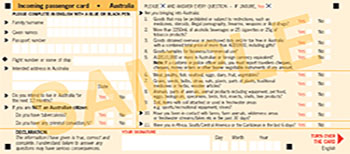
- family/surname, given names and passport number
- flight number or name of ship
- intended address in Australia
- if they intend to live in Australia for the next 12 months
- declarations relating to customs and quarantine.

- the country in which they boarded the flight/vessel
- their date of birth and usual occupation
- nationality as shown on their passport
- contact details in Australia and emergency contact details.
Passengers are required to sign and date the IPC, and are also required to correctly answer additional questions concerning their migration status, health status and any prior criminal convictions. For non-Australian citizens, providing false information can affect their visa status.
Completing a passenger card on behalf of another traveller
An IPC can be completed on behalf of another traveller where a person is in charge of that traveller. This includes parents/guardians of minors and carers of travellers with special needs.
A non-Australian citizen is considered to have completed a passenger card where the card is completed on their behalf.
Further information
Information about the Departments access to passenger information of all persons taking or proposing to take international passenger air service flights into and out of Australia.
See: Collection of passenger name records
Information about arrival and departure records in the Movements Reconstruction database and how to request access to the information.
See: Movement Records
Need a hand?

Enter the first 6 and last 4 digits of the number found on the front of your card.
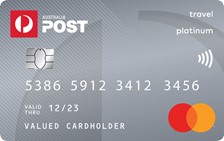
Please Wait...
Can't remember your password?
- Click ' Forgot Password '
- Confirm your account details
- An email with a link to reset your password will be sent to you
Please check your email
Need an account? Activate your card
Mastercard Prepaid Management Services Australia Pty Ltd (ABN 47 145 452 044, AFSL 386837) arranges for the issue of the Australia Post Travel Platinum Mastercard® (“Travel Mastercard") in conjunction with the issuer, EML Payment Solutions Limited ('EML') ABN 30 131 436 532 , AFSL 404131 . Australian Postal Corporation (ABN 28 864 970 579, AR No. 338646), the card distributor, acts as an Authorised Representative of Australia Post Services Pty Ltd (ABN 67 002 599 340, AFSL 457551). You should consider the Travel Mastercard Product Disclosure Statement and Financial Services Guide before deciding to acquire the product. The Target Market Determination for this product can be found here auspost.com.au/travelcard . Any advice does not take into account your personal needs, financial circumstances or objectives and you should consider if it is appropriate for you. Mastercard and the circles design are registered trademarks of Mastercard International Incorporated.
^Pay no foreign transaction fees on purchases when travelling, when you load your Australia Post Travel Platinum Mastercard with USD or EUR currencies supported by the product, and transact in that same currency.
Before you make a decision to acquire the card, please check auspost.com.au for the latest currencies supported. Lock in your rates means the exchange rate is locked in for the initial load only. The exchange rates for subsequent reloads will be set at the prevailing exchange rate at the time of the transaction. Mastercard Prepaid Management Services Australia Pty Ltd (ABN 47 145 452 044, AFSL 386837) arranges for the issue of the Australia Post Travel Platinum Mastercard in conjunction with the issuer, EML Payment Solutions Limited ('EML') ABN 30 131 436 532 , AFSL 404131. Australian Postal Corporation (ABN 28 864 970 579, AR No. 338646), the card distributor, acts as an Authorised Representative of Australia Post Services Pty Ltd (ABN 67 002 599 340, AFSL 457551). You should consider the Australia Post Travel Platinum Mastercard Product Disclosure Statement and Financial Services Guide before deciding to acquire the product. These can be found together with the Target Market Determination for this product at auspost.com.au . Any advice does not take into account your personal needs, financial circumstances or objectives and you should consider if it is appropriate for you. Terms, conditions and fees apply. Mastercard and the circles design are registered trademarks of Mastercard International Incorporated.
Mastercard Prepaid Management Services Australia Pty Ltd (ABN 47 145 452 044, AFSL 386837) arranges for the issue of the Australia Post Travel Platinum Mastercard in conjunction with the issuer, EML Payment Solutions Limited ('EML') ABN 30 131 436 532 , AFSL 404131. Australian Postal Corporation (ABN 28 864 970 579, AR No. 338646), the card distributor, acts as an Authorised Representative of Australia Post Services Pty Ltd (ABN 67 002 599 340, AFSL 457551). You should consider the Australia Post Travel Platinum Mastercard Product Disclosure Statement and Financial Services Guide before deciding to acquire the product. The Target Market Determination for this product can be found here.
Any advice does not take into account your personal needs, financial circumstances or objectives and you should consider if it is appropriate for you. Terms, conditions and fees apply. Mastercard and the circles design are registered trademarks of Mastercard International Incorporated.

Editorial note: We may not cover every product in this category. For more information, see our Editorial guidelines .
Best travel money cards in 2024.
Travel money cards are essential when travelling overseas.
They allow you to easily make payments whilst travelling overseas. They make paying easier for shops, restaurants, hotels and ATMs.Travel money cards work in a similar way to ATM cards. They use a pin when you purchase goods or services overseas.
In this guide, we have compared travel money cards to help you make the best selection for your next trip.

Best Travel Money Cards:
- Wise Travel Card Best Exchange Rates
- Revolut Best for Low Fees
- Travelex Money Card Best All Rounder
- Bankwest Breeze Platinum Best Travel Credit Card
- Pelikin Student Traveller Card Best Student Card
- HSBC Everyday Global Travel Card Best Travel Card by Bank
- Qantas Travel Money Card Best Reward Benefits
Wise Travel Card - Great Exchange Rates
- 40+ currencies available
- Best exchange rates globally
- One of the lowest conversion fee on the market
- No international transaction fees
- No annual or monthly fees
- Extremely low costs to send money overseas
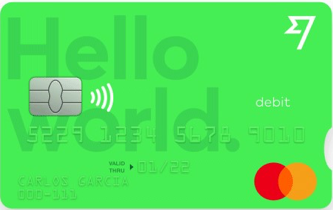
Wise Travel Card
- Cross currency conversion fees are between 0.24–3.69%. AUD to USD, EUR or GBP was 0.42%, which is one of the lowest on the market
- Free cash withdrawals up to $350 every 30 days. However after that, Wise charge a fixed fee of $1.50 per transaction + 1.75%
- Daily ATM withdrawal is $2,700
- Issue up to 3 virtual cards for temporary usage
- It takes between 7 to 14 business days to receive your card
- Can be used wherever MasterCard is accepted
The Wise Travel Card is great for frequent travellers as it offers over 40 currencies at the inter-market exchange rate, which is the cheapest rate globally. In addition you can buy goods online from overseas with no transaction fee plus get the best exchange rate. However if you use ATMs frequently this is not the card to use due to the fees. Finally Wise Travel Card lets you transfer money to an overseas bank account with extremely low fees and the best exchange rate.
Our Wise Travel Card Review
Revolut - Low Fees
- 30+ currencies available
- One of the best exchange rates globally
- No annual or monthly fees for standard membership
- No initial card fee
- Instant access to a range of cryptocurrencies
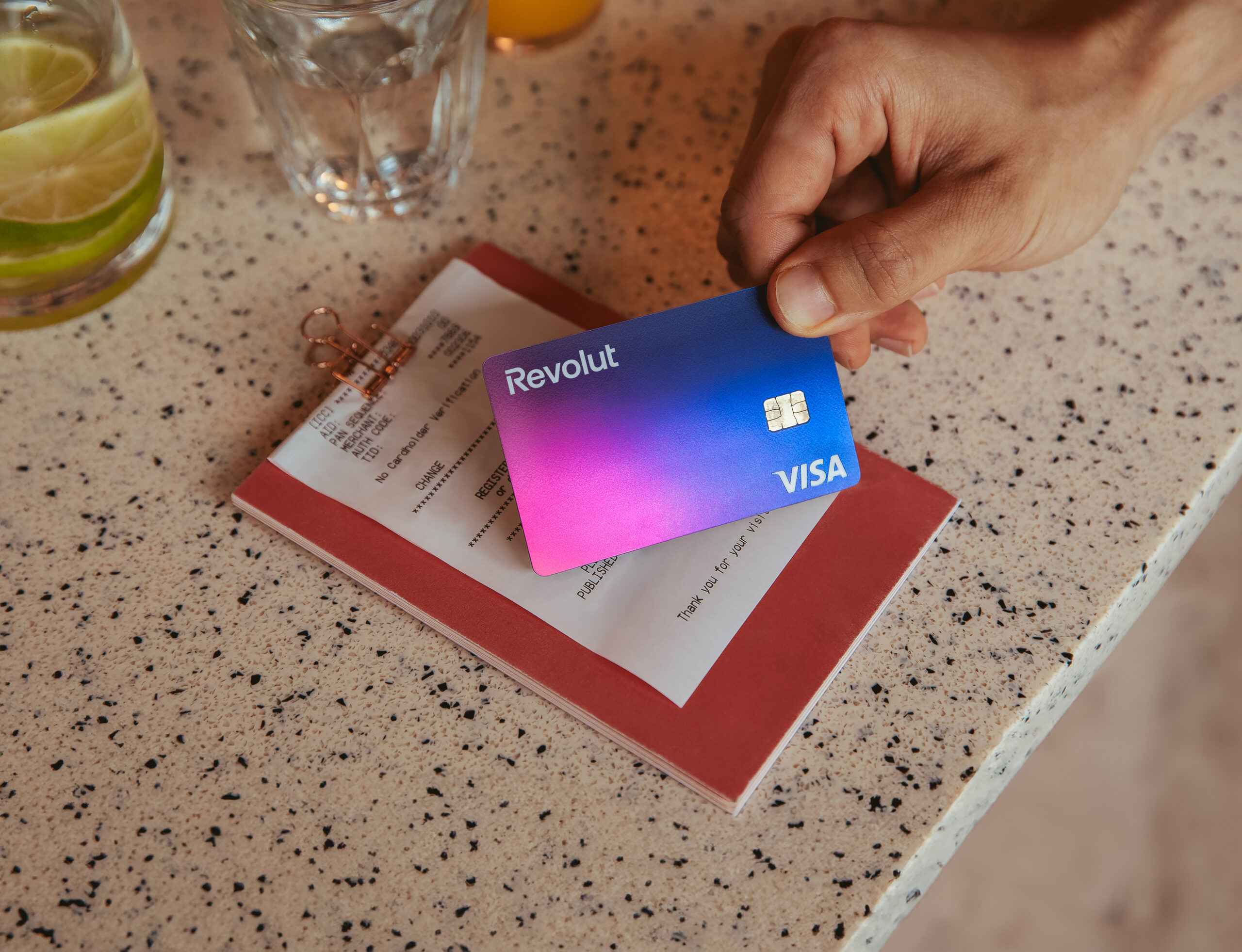
Read our Revolut Card Review
Revolut Travel Card
- No fee ATM withdrawals up to A$350, or 5 ATM withdrawals, whichever comes first, per rolling 30 day period and 2% of withdrawal amount (minimum charge of A$1.50) after that
- Exchanging currency on the weekend can incur a 1% mark-up fee
- Fees on international money transfers were introduced in April 2021.
- Can be used wherever Visa is accepted
The Revolut Travel Card is a decent option for those who travel a lot as it offers over 30 currencies at a great exchange rate, which is the cheapest rate globally. However if you exchange currency on the weekend you can incur a one-percent mark-up fee. In addition they have introduced fees for international transfers. Finally if you use ATMs frequently this is not the card to use due to the fees.
Travelex Money Card - Best All Rounder
Best features.
- Unlimited free ATM withdrawals
- 24/7 Emergency Assistance
- Initial and replacement card are free
- Lock in up to 10 currencies
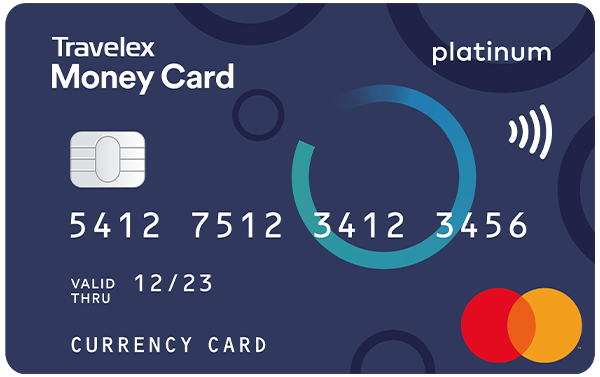
Read our Travelex Travel Card Review
Travelex Money Card
- Minimum load of $100 and maximum load of $100,000
- Can be used wherever Mastercard is accepted
- Fees include a $10 closure fee, $5 for an additional card and $4 inactivity monthly fee.
- While Travelex don't charge ATM fees, some ATM operators may charge their own fees.
- Currencies that can be loaded are AU$, US$, EU€, GB£, NZ$, TH฿, CA$, HK$, JP¥, SG$
- If your card is lost or stolen you can access cash in your account through Moneygram or Western Union agents, with no charge
- Boingo hotspots offer free wifi and you can look at their number of free hotspots per country on this map
The Travelex Card is a good all rounder.
You can use it to take money out of the ATM, for merchant purchases like restaurants and even for online shopping in foreign currency. While the exchange rates aren't as good as the Wise or Revolut Card abroad , the support network if the card is lost or stolen is very good.
Bankwest Breeze Platinum Credit Card - Lowest Interest Rate
- Lowest interest rate at 9.90%
- No international transaction fees on purchases
- 0% p.a. on purchases and balance transfers for the first 15 months
- Up to 55 days interest free on purchases
- Low annual fee
- Complimentary international travel insurance
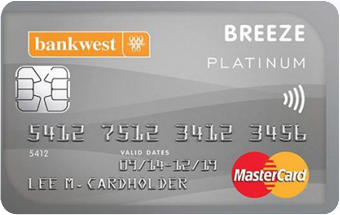
Bankwest Breeze Platinum Credit Card
- Free annual fee first year, then $69 annual fee
- 55 interest free days
- Free international travel insurance that includes the basics but does not cover cancellation costs, pre existing conditions and travellers over 80
- $6,000 minimum credit card
- 0% p.a. on purchases and balance transfers for the first 15 months, then reverts to 9.90%
- 21.99% interest rate on purchases and cash advances
- Cash advance fee of the higher of $4 or 2% of cash advance
The Bankwest Breeze Platinum is a great no frills credit card that offers ‘no foreign transaction fees’ and the lowest interest rate on the market, at 9.90%. These two factors alone will save you hundreds of dollars when travelling overseas.
In addition it has a low annual fee and complimentary international travel insurance. Finally for its price point it is a great value credit card that will be accepted most places around the world.
HSBC Everyday Global Debit Card
- No initial card or closure fees
- No monthly or account fees
- No international ATM fees
- No cross currency conversion fees
- Lock in very competitive exchange rates before travel
- No maximum balance
- Earn 2% cashback
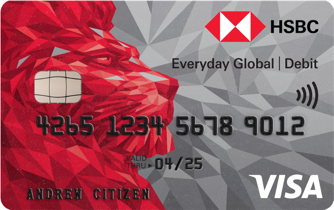
- 10 Currencies can be loaded are AUD, USD, GBP, EUR, HKD, CAD, JPY, NZD, SGD, CNY (currency restrictions apply to CNY)
- Awarded 5 gold stars by CANSTAR in 2021 for Outstanding Value
- Very competitive exchange rates on all currencies when you have currencies already loaded on your card
- ATMs within Australia need to be HSBC and overseas they need to display a VISA or VISA Plus logo, not be be charged fees
- Earn 2% cash back when you tap and pay with Visa pay wave, Apple Pay or Google Pay for purchases under $100. With a maximum of $50 cash back per month. In addition you need to deposit $2,000 or more into your Everyday Global Account each calendar month.
- Daily maximum ATM withdrawal is $2,000
- Fraud protection covered by Visa Zero Liability
The HSBC Everyday Global Debit Card is a good option to take travelling and to spend money in Australia with no international transaction fees, international ATM fees and monthly fees. In addition there is no maximum balance on currencies held and a 2% cash back incentive when you tap and pay under $100.
Finally it is one of the only travel cards that offers Chinese Yuan. To avoid ATM fees you need to find HSBC branches in Australia and only use ATMs overseas with a VISA or VISA Plus logo.
Best Student Card
Pelikin student traveller card.
- Use promo code SMONEY10 for a $10 discount
- Up to 15% off international flights
- A globally accepted virtual student ID card
- 2% cash back on food & drinks, transport and accommodation
- Over 150,000 discounts worldwide

- $30 for 12 months
- 20+ currencies available
- Split bills, pay and get paid instantly
Pelikin is one of the only travel cards in Australia specifically for students. While it has a small annual fee, the range of discounts and offers more than make up for it.
The app is relatively easy to use and card arrives in under a week.
Best Rewards Card
Qantas travel money card.
- No monthly fees, purchase fees and currency conversion fees
- No load fees if you pay by bank transfer or BPay
- Locked in exchange rates: 4%+ margin on exchange rates
- Earn 1.5 Qantas points for every AU$1 spent in foreign currency
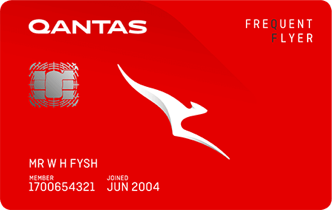
- 10 currencies offered USD, GBP, EUR, THB, NZD, SGD, HKD, CAD, JPY, AED
- Free Australia ATM withdrawals
- 0.5% fee debit card reload fee
- ATM fees overseas (USD 1.95; GBP 1.25; EUR 1.50; THB 70; NZD 2.50; SGD 2.50; HKD 15.00; CAD 2.00; JPY 160; AED 6.50)
- Minload of $50 and max of $20,000
- Available to 16 year olds, has a lower age restriction than most credit cards (18 year olds)
Qantas Travel card is a great option to spend foreign currency overseas if you are already a loyal Qantas customer and use your frequent flyer points regularly on flights, accommodation or gifts. The fees are low, the exchange rate is average however the ATM fees are expensive and will easily add up.
Other popular travel money cards
Aside of the Top 5 travel money cards, there are many more options to consider. These include well known brands such as the Commonwealth Bank and Travelex and less known services like Up Bank and Revolut.
Here is a rundown of their best features, fees and available currencies:
- 13 currencies available, including Vietnamese Dong and Chinese Yuan
- No issue fee, load fees, closure and card replacement fees
- Additional card offered
- Can be accessed through Commonwealth Bank app
Commonwealth Bank Travel Money Card
- $3.50 fee at ATMs overseas
- 13 currencies offered USD, GBP, EUR, THB , NZD, SGD, HKD, CAD, JPY, AED, AUD, VND & CNY
- Minload of $1 and max of $100,000
- Available to 14 year olds, has a lower age restriction than most credit cards (18 year olds)
- When you use your card for a purchase or withdrawal in a currency that is not loaded, or when they automatically transfer funds between the currencies on your card to enable the completion of the transaction at the Visa retail exchange rate plus 4%
- To transfer money between currencies or a transaction account, it will be at the bank rate which is normally 4% above the market value
The Commonwealth Bank travel money card is great if you are already a Commonwealth bank customer who banks online and knows exactly how much money in each country you want to spend. However if you need to transfer between currencies or make a purchase in a currency you don't have funds loaded, then you can get an additional expensive charge. Watch how many withdrawals at ATMs you make as well to keep the costs down.
- Exchange rates most competitive for USD, GBP and THB
- No fee on initial card or load (not BPay)
- No fee on reloads via bank transfers
- No monthly or inactivity fees
- Card is valid for 5 years
Travel Money Oz Currency Pass
- 1.1% reloading fee via Travel Money Oz Login or with debit or credit card
- 1% reloading fee for BPay
- $10 closure fee and replacement card fee
- 2.95% on withdrawals from Australian ATMs is expensive
- Roughly $3.50 on withdrawals from overseas ATMs is expensive.
- $3.99 + 5.95% fee on cross currency transactions
- 10 Currencies can be loaded are USD, EUR, GBP, NZD, CAD, HKD, JPY, SGD, THB & AUD
- Exchange rates for SGD and CAD are the least competitive
- Minload of $20 and max of $10,000
- Only 1 card per account
- According to the website they won't take online orders if you are departing within 14 days as the card can take up to 2 weeks for delivery.
The Travel Money Oz travel money card seems to be an outdated version of the Travelex or Australia Post travel card as it does not offer Global Emergency Assistance or Boingo hotspots. However exchange rates and fees are similar to Travelex, so if you are travelling to the US, UK or Thailand, this is a great card to pay for accommodation and things in shops. We would avoid using it at any ATM, to save costs.
- No ATM fees in Australia or internationally
- No minimum monthly deposit
- No account keeping fees
- Can be used in Australia as an EFTPOS card
- Available to 14 year olds and older
Macquarie Travel Card
- $2,000 daily limit for ATM withdrawals
- Simple and easy to work out costs for account
- Exchange rates are MasterCard exchange rates, which are normally 4%+ market rate.
- 90-day theft and damage protection on eligible purchases and stolen wallet protection up to $500
- Can be used in Australia to buy goods overseas and not pay international transaction fees
- Get discounts of up to 10% on eGift cards to use at over 50 leading retailers
The Macquarie Travel Card is a very good option to take overseas for ATM withdrawals as they are all free. In addition in Australia you can buy goods online and not pay an international transaction fee. Furthermore you can use the card like a normal debit card in Australia with no hefty fees or monthly minimum deposits. However the exchange rate is the MasterCard rate which is normally 4%+ above the market rate. Finally we would recommend this card for cash withdrawals at ATMs internationally but not paying for accommodation due to the added margin on the MasterCard exchange rate.
- Cheapest way to send money overseas through a bank
- UI and UX better than traditional banks making it super easy to use
- Competitive savings interest rate
Up Bank Travel Card
- Backed by Bendigo Bank and Adelaide Bank and partnered with Wise so it has financial backing and access to the cheapest exchange rates to send money overseas
- Nifty online tools to help you track spending, budget and save. These include a detailed transaction history often including a company logo, when you paid down to the minute and the suburb where the transaction was made. In addition it has a ‘Regulars feature that detects regular billers and estimate of upcoming bills so you get a heads-up before they are due
- Good savings account interest rates of 1.85% (0.10% base rate plus 1.75% bonus). Bonus interest is easily unlocked after making five successful card or digital wallet purchases each month
The Up Bank Travel Card is aimed at younger markets who are looking to save on bank costs and receive online tools to help them budget and save for their goals. It is also able to be used overseas at any ATM without fees, no international fees and is the cheapest way to send money overseas through a bank due to their partnership with Wise (the largest money transfer company in the world). In addition the exchange rates are Mastercard rates which are normally 4% above interest rates. Finally, while this card is very useful domestically and for ATMs overseas we would not recommend it for big ticket items overseas as it is an expensive card to use.
- No foreign transaction fees
- No fee on initial card, load, unload or inactivity fees
- No cross currency transactions fees
- Lock in exchange rates before you leave
- Exchange rates most competitive for USD, GBP, EUR and CAD and JPY
- No ATM fee at 50,000 Global Alliance ATMs worldwide
- Free additional card
- Flight delay pass
Westpac Travel Money Card
- 11 Currencies can be loaded are USD, EUR, GBP, NZD, CAD, HKD, JPY, SGD, THB, AUD & ZAR
- $2,000 maximum limit on ATM withdrawals overseas within 24 hours
- $50,000 maximum limit on currencies loaded on to travel card
- $3 roughly for ATMs that are not within the Non Westpac Global Alliance
- If you run out of one currency on the card, you can pay with other currencies without the expensive cross currency transaction fee
- No foreign transaction fees, initial card, load, unload or inactivity fees
- According to the Westpac it can take upto 8 business days to receive the travel card
- Secure from fraudulent transactions with Mastercard Zero Liability protection
- 2 cards per account for free
The Westpac Travel Card is a no frills handy travel card with very low fees, no foreign transaction fees, access to some free ATMs worldwide and competitive exchange rates, especially on USD, EUR, GBP, CAD and JPY. In addition it has the South African Rand (ZAR) which is not common in prepaid travel cards. Finally it has access to a flight delay pass in case your flights are delayed and you need to access airport lounges.
- Linked to ANZ Rewards program
- 7 types of insurance for free
- 55 days interest free
- Good security on card purchases
ANZ Travel Adventure Card
- 20.24% interest on purchases and cash advances
- $120 annual fee
- No international transaction fees in person or online
- Offer 7 types of insurance for free
- ANZ Reward points can be used to buy gift cards, swap for Virgin or Singapore airline points or cash into your account.
- Earn 1.5 Reward points per $1 spent on eligible purchases up to $2,000 per statement period
- ATM fees at non ANZ ATMs
- Minimum credit of $6,000
If you utilize rewards points then the ANZ Travel Adventure Card might be suitable for you. Reward points can be used to buy a wide range of gift cards, swap for Virgin or Singapore airline points or cash into your account. In addition no international transaction fees are charged for purchases online or whilst you travel overseas. Finally this card is not recommended for cash withdrawals as the interest rate of 20.24% will eat up any savings.
- No ATM fees
- Can be used in Australia with no additional costs
- No fees for paying via bank transfer or Bpay
- Transfer limits can be set by user
ING Orange Everyday Account Debit Card
- As long as you you deposit at least $1000 and make at least 5 payments each month ING will waive international transaction fees and refund overseas ATM withdrawal fees
- Can be used in all countries
- Works with Apple Pay and Google Pay
- Visa currency conversion rates apply, which are normally 4% above market
The ING Orange Everyday Account Debit Card is a good card for most Australians travelling overseas for ATM access, with no fees. It also allows you to to buy goods online without an international transaction fee.
Furthermore you can use it in Australia for free and there are no fees to get your initial card, for account keeping or to top up your card. A word of caution however, if you travel overseas for longer than 1 month, you still need to deposit at least $1,000 and make at least 5 payments each month to get the rebates.
- Initial card and replacement cards are free
- Increased protection with Mastercard Zero Liability
- Access to cash from your account through the Global Emergency Assistance, if your card is lost or stolen
Australia Post Travel Money Card - Platinum Mastercard
- 1.1% Admin fee for instore loads, including initial load
- $5 fee for reloads via debit bank card
- $10 closure fee
- $3.50 on withdrawals from overseas ATM is expensive
- Currencies that can be loaded are USD, EUR, GBP, NZD, THB, CAD, HKD, JPY, SGD , AED and AUD
- Minload of $100 and max of $100,000
- If your card is lost or stolen you can access cash that is in your account through Moneygram or Western Union agents, with no charge
- Boingo hotspots offer the free wifi and you can look at their number of free hotspots per country on this map
The Australia Post travel money card is a popular option for Australian travellers due to the convenience of stores. However we would recommend the Australia Post travel money card for paying in shops or accommodation as it is costly to withdraw cash from ATMS. As the Australia Post travel money card is fee heavy we recommend not making withdrawals at ATMs or making cross currency transactions to keep additional fees down.
- Up to 11 currencies available
- Manage your account and card online
- 24/7 global assistance
- Access to emergency cash
- Free additional card when ordered at time of purchase
- Can be used at millions of locations worldwide – wherever Mastercard purchase symbol is displayed
Greater Bank Cash Passport Platinum Mastercard
- $5 fee for reloads via debit bank card, FREE reloads via BPAY
- Admin fee of up to the greater of 1.1% of the load/reload amount or $15 for in-store purchases
- Debit card load fee 0.5% of the amount loaded, per Debit Card Load transaction
- Domestic ATM fee 2.95% of value Withdrawn
- International ATM fee USD 2.50, EUR2.50, GBP 2.00,NZD 3.50, THB80.00, CAD 3.50,HKD 18.00, JPY260.00, SGD3.50, AED 10.00, AUD 3.50
- Minimum load of AUD100 and a Maximum of AUD100,000
The Cash Passport is one of the most popular travel cards in the Australian market. With Greater Bank, you can purchase it online and at one of their branches, then download the app or use the website to manage your card. While the card may be useful for international purchases, be mindful when using an ATM both locally or overseas as the fees can add up if you are withdrawing money often.
Learn more about the Cash Passport Platinum Mastercard through Greater Bank .
The best travel card in Australia depends on its use, for ATM withdrawals it is ING Orange , for best exchange rates it is Wise Travel Card, the best credit card is Bankwest Breeze Platinum , for overall best card by a bank its HSBC Global and the best rewards card is the Qantas Travel card .
A travel money card is safer than cash overseas and if you select a Wise travel card , it is the best exchange rate as well. Most places around the world accept MasterCard or Visa, so you should be able to pay for all your purchases by card.
Yes you can use all travel cards in Australia but you might choose not to due to the fees. ING , Macquarie , Up , Citibank are all good examples of travel money cards that do not charge for ATM withdrawals in Australia. However examples of travel money cards that charge $3.50 per Australian ATM withdrawal include Travelex , Australia Post and Travel Money Oz .
Both if you buy your cash from S Money and pay with a Wise card overseas, as they both use the exchange rate you see online and charge very low fees. However if you buy your foriegn currency at the airport, you are paying top prices so using a card is cheaper.
There are many travel money cards that no longer exist but appear in search engine page results. Travel money cards that no longer exist include 7-11 Just Go, NAB Travel Money Card, Travelex Cash Passport, Australia Post Cash Passport, ANZ Travel Card, Westpac Global Currency Card and the Virgin Velocity Global Wallet program.
Learn more about the best debit, credit and prepaid cards for travel

Best Prepaid Cards

Credit Card

More Travel Card Guides
Learn more about the best travel money cards for your holiday destination.
ASIC regulated
Like all reputable money exchanges, we are registered with AUSTRAC and regulated by the Australian Securities and Investment Commission (ASIC).
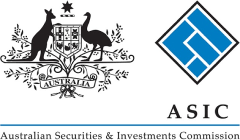
S Money complies with the relevant laws pertaining to privacy, anti-money laundering and counter-terrorism finance. This means you are required to provide I.D. when you place an order. It also means the order must be paid for by the same person ordering the currency and you must show your identification again when receiving your order.
- My Account My Account
- Cards Cards
- Banking Banking
- Travel Travel
- Rewards & Benefits Rewards & Benefits
- Business Business
- Credit cards
- View all credit cards
- Banking guide
- Loans guide
- Insurance guide
- Personal finance
- View all personal finance
- Small business
- Small business guide
- View all taxes
You’re our first priority. Every time.
We believe everyone should be able to make financial decisions with confidence. And while our site doesn’t feature every company or financial product available on the market, we’re proud that the guidance we offer, the information we provide and the tools we create are objective, independent, straightforward — and free.
So how do we make money? Our partners compensate us. This may influence which products we review and write about (and where those products appear on the site), but it in no way affects our recommendations or advice, which are grounded in thousands of hours of research. Our partners cannot pay us to guarantee favorable reviews of their products or services. Here is a list of our partners .
The Guide to Air Canada Wi-Fi

Many or all of the products featured here are from our partners who compensate us. This influences which products we write about and where and how the product appears on a page. However, this does not influence our evaluations. Our opinions are our own. Here is a list of our partners and here's how we make money .
Table of Contents
Does Air Canada have Wi-Fi?
How much is wi-fi on air canada, does air canada have free wi-fi, how to save on air canada wi-fi costs using credit cards, how to connect to air canada wi-fi, if you want to connect to air canada wi-fi.
For some travelers, staying connected in the air is essential to flying. Whether you respond to business emails before arrival or keep up to date with your social networks, Air Canada generally offers some level of Wi-Fi access, depending on your flight details.
If you're planning an Air Canada trip soon, here’s what you should know about in-flight Air Canada Wi-Fi.
» Learn more: The points collector’s guide to Air Canada Aeroplan
All Air Canada Rouge (Air Canada's low-cost subsidiary) customers can access high-speed Wi-Fi during their flight. Premium Rogue customers can enjoy complimentary Wi-Fi, while economy customers have Wi-Fi available for purchase.
Air Canada is working on growing its Wi-Fi capable aircraft. Currently, the carrier offers Gogo-equipped Wi-Fi, but connectivity is limited to certain North American and international flights.
Nearly all of Air Canada’s wide-body planes have streaming-quality Wi-Fi and most of Air Canada’s narrow-body aircraft are also equipped with Wi-Fi.
The exception is the 737 MAX 8 (7M8) fleet, where connectivity is still in progress. As of this writing, just 25% of Air Canada’s 737 MAX 8 (7M8) aircraft have Wi-Fi connectivity.
You can check if Air Canada in-flight Wi-Fi is available on an aircraft before booking your flight. Simply check that the Wi-Fi logo is present in the flight details to confirm that the aircraft is Wi-Fi connected. Keep in mind that you’ll need to verify in-flight Wi-Fi for each flight on a multi-leg trip.
Additionally, you can use the Air Canada Wi-Fi tool on the airline’s website to check if your upcoming flight has Wi-Fi access. You can check this detail using your flight number and departure date, or using your flight route and departure date.
» Learn more: Getting elite status on Air Canada with the Aeroplan credit card
Air Canada passengers can pre-purchase one of three Wi-Fi pass options or purchase a pass at in-air pricing — possibly at a higher cost — after boarding. The pass options include:
Air Canada 1-Hour Pass $4.77 ($6.50 CAD). Offers one continuous hour of Wi-Fi access during the flight.
Air Canada 1-Way Pass $15.41 ($21.00 CAD). Offers internet connectivity during the entire length of your flight.
Air Canada Monthly Plan $48.40 ($65.95 CAD). A monthly subscription for internet access on all Air Canada Wi-Fi capable aircraft between Canada, U.S., and Mexico.
With a pass you can browse the internet, check email, scroll updates on social media and send text messages via Wi-Fi. However, in-flight Air Canada Wi-Fi doesn’t support Voice Service and Voice over IP.
Air Canada’s Aeroplan loyalty program offers complimentary Wi-Fi access for its 75K Status and Super Elite Aeroplan members. Specifically, this benefit offers a 12-month plan for Gogo Wi-Fi for up to five devices. Only one device can be logged into in-flight Wi-Fi at a time.
Additionally, Aeroplan members have access to free texting. To access this complimentary feature, members must add their Aeroplan number to their booking information before checking in to the flight.
Unfortunately, Air Canada’s Aeroplan® Credit Card doesn’t offer free or discounted Wi-Fi access as a travel benefit. However, one way to cover all or part of the cost of Wi-Fi is through a travel rewards credit card.
If you carry a card that provides an annual travel credit you haven’t claimed yet, you can subsidize the cost of a Wi-Fi pass using your card’s benefit. Some credit cards that offer travel credit that can be applied to in-flight Wi-Fi charges include:
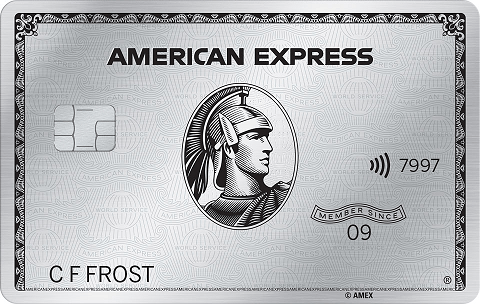
on American Express' website

on Bank of America's website

on Chase's website
Up to $200 annually with your preferred airline. Enrollment required. Terms apply.
Up to $100 annually.
$300 annual statement credit for travel purchases.
» Learn more: The best travel credit cards right now
Once comfortably in your seat, you can connect to Wi-Fi on Air Canada flights in three simple steps.
Go to “Settings” on your mobile device. Set your device to “Airplane mode” and turn on Wi-Fi.
Select “ACWiFi.com” to connect to the airline’s Wi-Fi network.
Launch your browser and go to “acwifi.com” and follow the instructions from there.
If you need technical support during your flight, select “Wi-Fi Onboard” for assistance from Air Canada’s Wi-Fi service provider.
Unless you have 75K or Super Elite Aeroplan status, chances are Air Canada Wi-Fi will cost you. You might be able to save a few bucks by purchasing your pass ahead of time if you’re sure you’ll need to be connected.
The good news is the airline is focusing its efforts on getting free in-flight Air Canada Wi-Fi for all its passengers in the future. It’s testing out “full, fast and free” Wi-Fi for its regional flights and plans on expanding that to its other customers.
How to maximize your rewards
You want a travel credit card that prioritizes what’s important to you. Here are our picks for the best travel credit cards of 2024 , including those best for:
Flexibility, point transfers and a large bonus: Chase Sapphire Preferred® Card
No annual fee: Bank of America® Travel Rewards credit card
Flat-rate travel rewards: Capital One Venture Rewards Credit Card
Bonus travel rewards and high-end perks: Chase Sapphire Reserve®
Luxury perks: The Platinum Card® from American Express
Business travelers: Ink Business Preferred® Credit Card
On a similar note...

- Azerbaijani
- Chinese (Simplified)
- Chinese (Traditional)
- Haitian Creole
- Kinyarwanda
- Kurdish (Kurmanji)
- Kurdish (Soranî)
- Odia (Oriya)
- Scots Gaelic
Travel scratchie scams: don't let 'instant win' become instant regret
- WA households targeted by Malaysian travel brochure scam
- Packages arrive containing fake scratchies showing $US185,000 win
Fake scratchie cards promising huge cash prizes as part of a bogus travel promotion are once again arriving in letterboxes across Western Australia, prompting a warning for households to be on scam alert.
Consumer Protection's WA ScamNet team has recently received a high number of reports from consumers who were sent packages, often via registered mail, containing glossy travel brochures and two scratchie cards, one of which reveals a $US185,000 'win.'
This long-running scam from Malaysia has gone by many names over the years, but the latest versions being reported are "Klang Valley Tours", "Travel Expert Tours" and "Global Line Travel".
When the supposed 'winners' contact the scammers to claim their 'prize', they are instructed to firstly send personal identification (ID) - which will be used to steal their identity - and then to pay an upfront fee to receive the funds. They are also told not to discuss the 'winnings' with anyone.
Unfortunately, one WA couple has reported sending their ID before they realised, and another man sent the money in cryptocurrency. Another couple also came very close to sending the $5,000 fee to the scammers at their local post office.
Scam attempts can be reported to WA ScamNet via the website at: https://www.scamnet.wa.gov.au/scamnet/Home.htm or by emailing [email protected] or phoning 1300 30 40 54.
Comments attributed to Commerce Minister Sue Ellery:
"We often warn about the scams that arrive via email, phone and social media, but it's important not to forget they can land in our letterbox too.
"Scammers are smart - they know by dressing up this con with a very professional, expensive-looking brochure, people may be more likely to think the scratchie prize money is real.
"Don't be fooled though - if you receive these packages, throw them straight in the bin. Do not provide personal information and remember, you should never have to pay money to receive a legitimate prize."

Hon. Sue Ellery
Acknowledgement of country.
The Government of Western Australia acknowledges the traditional custodians throughout Western Australia and their continuing connection to the land, waters and community. We pay our respects to all members of the Aboriginal communities and their cultures; and to Elders both past and present.

IMAGES
VIDEO
COMMENTS
Free ATM cash withdrawals up to 350 AUD a month. The Wise travel money card takes the worry out of using ATMs abroad. You only pay a small fee on withdrawals after the first 350 AUD. Avoid hidden fees in the exchange rate while withdrawing from ATMs abroad. Learn more about our pricing.
The ideal prepaid card for overseas travel. Buy online Manage your card Find Post Office. Travel smarter with our Australia Post Travel Platinum Mastercard, a reloadable, multi-currency prepaid card that's accepted wherever Mastercard is, worldwide 1. Easily swipe or tap in-store, use online and withdraw money from ATMs 2.
Here is a list of the 6 best prepaid cards you can take with you on your travels and the positives and negatives for each one: Wise - our pick for prepaid cards. Revolut - low fees. Citibank - good for use at home. Travelex - no fees for ATM withdrawals. Australia Post - lock in exchange rates. HSBC - no international transaction fees.
01. Revolut — Best all-round travel card in Australia. 02. Wise — Best for number of currencies and foreign account details. 03. Considering going through your bank. 04. Compare the best travel cards in Australia. 05.
American Express Platinum. International transaction fee: 3%. Interest rate on purchases: n/a. Up to 44 cash flow days. Annual card fee: $1,450. Complimentary international travel insurance: Included. Plus 200,000 bonus points for new members who apply online by 9 April 2024 and spend $5k in the first 3 months following approval.
The Citibank Plus Everyday Account - bank debit card. With this card you can: withdraw money for free at over 3000 ATMs Australia-wide and overseas. take advantage of no foreign transaction fees, monthly fees, or minimum opening balance. transfer money to friends and family anywhere in the world for free.
Wise Travel Money Card. AUD,USD,CAD,EUR,GBP,JPY,NZD,SGD. 2 free ATM withdrawals per month up to AUD$350, then AUD$1.50 and 1.75% per withdrawal. $0. $0. Hold and spend funds in more than 40 ...
Canstar considers travel money cards from a range of providers. Our expert researchers use a sophisticated methodology to rank travel money cards based on their fees and features. We give the top-performing cards a 5-Star Rating. Some of the factors Canstar considers are:
The table below displays the best-rated overseas travel credit cards from our online partners, sorted by our expert Star Ratings (highest to lowest). 0% p.a. interest rate on balance transfers for 9 mths. Rate reverts to 21.74% p.a. Balance transfer fee of 1% applies... 0% p.a. interest rate on purchases for 9 mths.
CommBank Travel Money Card is a convenient, simple and safe way to access your money when travelling overseas. ... (PDF) issued by Commonwealth Bank of Australia ABN 48 123 123 124 for Travel Money Card should be considered before making any decision about this product.
7. Fiji. While the white sands and crystal blue waters of Fiji are a favourite for Aussie travellers, no prepaid travel cards currently support the Fijian dollar. However, as Mastercard and Visa ...
Withdrawing €500 From An ATM. Our Picks: Best Travel Debit Cards In 2024. Up Debit Card. Ubank Debit Card. Revolut Australia. Macquarie Transaction Account. HSBC Everyday Global Account. Wise Multi-Currency Account. Honourable Mentions - Best Travel Debit Card.
Australia Post Travel Platinum Mastercard. Available online or at post offices. Currencies: AUD, USD, NZD, EUR, GBP, SGD, THB, JPY, HKD, CAD, AED. Fees: Fee to reload the card via BPay, debit card or instore, but free via online bank transfer. Closure fee. Fees for ATM withdrawals in Australia and overseas.
You may buy or load money in up to 10 currencies at any one time and it can be easily managed online or via our Travelex Money App. From Australia, to the US, to Japan and the UK, the Travelex Money Card is the best travel money card for Europe, Asia, America and other continents. Receive great rates and no fees when buying or loading foreign ...
You can earn up to 2% cashback for contactless payments under $100, so you can earn money just by using your travel debit card to make purchases when you're home in Australia. You can use your card with Visa payWave, Apple Pay, and Google Pay. 7. Bankwest Breeze Platinum Credit Card: Complimentary Travel Insurance.
Mastercard Prepaid Management Services Australia Pty Ltd (ABN 47 145 452 044, AFSL 386837) arranges for the issue of the Australia Post Travel Platinum Mastercard ("Travel Mastercard") in conjunction with the issuer, EML Payment Solutions Limited ('EML') ABN 30 131 436 532 , AFSL 404131.Australian Postal Corporation (ABN 28 864 970 579, AR No. 338646), the card distributor, acts as an ...
Contact Mastercard Qantas Travel Money Global Support on 1300 825 302 (from within Australia), or +61 1300 825 302 (if overseas). If eligible, you can collect emergency funds from approved agent locations. The team will let you know the address details, telephone number and opening hours of the nearest agent location. Help & support.
A passenger card is a document providing passenger identification and an effective record of a person's entry to Australia. An Incoming Passenger Card (IPC) is to be completed by passengers entering Australia. IPCs will be provided to travellers on board their flight or ship before arrival or by the Australian Border Force in the arrival terminal.
Mastercard Prepaid Management Services Australia Pty Ltd (ABN 47 145 452 044, AFSL 386837) arranges for the issue of the Australia Post Travel Platinum Mastercard® ("Travel Mastercard") in conjunction with the issuer, EML Payment Solutions Limited ('EML') ABN 30 131 436 532 , AFSL 404131.Australian Postal Corporation (ABN 28 864 970 579, AR No. 338646), the card distributor, acts as an ...
The Travel Money Oz travel money card seems to be an outdated version of the Travelex or Australia Post travel card as it does not offer Global Emergency Assistance or Boingo hotspots. However exchange rates and fees are similar to Travelex, so if you are travelling to the US, UK or Thailand, this is a great card to pay for accommodation and ...
Using a travel rewards credit card has long been celebrated as an easy strategy to travel the world for less. Consumers can apply for rewards credit cards and earn points and miles on everyday ...
Apply for the Velocity Platinum Card & earn 1.5 Velocity Points per $1 spent. Plus start enjoying its many premium benefits including Lounge access and Travel Insurance.
TRAVEL SPENDING TRAPS TO AVOID • Avoid borrowing money for your trip. • Aim to have a couple of money access cards and options on hand. • Do not exchange money at the airport - the rates ...
Here are our picks for the best travel credit cards of 2024, including those best for: Flexibility, point transfers and a large bonus: Chase Sapphire Preferred® Card.
Fake scratchie cards promising huge cash prizes as part of a bogus travel promotion are once again arriving in letterboxes across Western Australia, prompting a warning for households to be on scam alert.
The services are provided by Wise Australia Pty Ltd ACN 616 463 855. Wise Australia Pty Ltd holds an Australian Financial Services licence (AFSL) number 513764 and is a Purchased Payment Facility (PPF) provider authorised by the Australian Prudential Regulation Authority (APRA).